- Dedicated Marketing Team
- NFT Promotion 2024
- DeFi Promotion
- YouTube Influencers
- Twitter Influencers
- Crypto Traffic
- Online Reputation Management
- Korean Marketing
- Chinese Marketing
- Russian Marketing
- Design for Online Casino
- Online Casino PR
- Crypto Website
- DeFi Development
- Blockchain Consulting
- Smart Contracts
- Custom Blockchain
- Promo Video Creation
- Analytical Review
- White papers for crypto projects
- Branding & Identity
- For Partners
- Brand assets

How to Start an NFT Business: The Algorithm, Ideas, and Investment Valuation
An NFT (non-fungible token) is a unit of data stored on a blockchain that can be used to identify a particular digital asset.
So far, the NFT is mostly popular in the entertainment industry, with most tokens issued for digital art and collectible items. However, the NFT offers significantly greater capabilities. Gary Vaynerchuk, an entrepreneur, known for his unconventional outside-the-box thinking, believes that this technology represents a major cultural change that will take place in the near future.
NFT Business — The Pros and Cons
The blockchain, DeFi, and NFT are still relatively new terms that are only starting to attract users. However, crypto enthusiasts believe in the unlimited potential of the new technologies and consider them to be the foundation of the future economy.
On November 22, 2021, the data platform Chainalysis published a report on the NFT platform. It demonstrates the growth in the weekly total cryptocurrency value on the market throughout 2021.
In August, a new NFT collection known as the Bored Ape Yacht Club was released. The chart shows that this event attracted a lot of interest which can be directly expressed in dollar terms. This leads to a simple conclusion: good business ideas can produce larger profits in the NFT environment than in the crisis-hit traditional economy. What is interesting, the underlying concept of the Bored Ape Yacht Club is quite basic. The tokens represent the unique VIP membership cards of a yacht club.
If you are trying to come up with your own business idea to enter the NFT market right now, pay attention to the chart below. It demonstrates what spheres the users are interested in.
The funny and somewhat weird apes are still ahead of everyone else, outperformed only by the mutant apes that can be created based on the original apes.
So far, art and gaming are still the most popular areas for NFT technology. This means that there are no limits for NFT entrepreneurs. There are lots of opportunities that you can benefit from by coming up with a rather simple original idea.
If you still do not believe in the potential of the NFT sphere, look at the increase in the number of users of a leading NFT marketplace — OpenSea.
Can You Sell NFTS and Make a Profit?
Since the NFT market is still in its early stages, it can be hard to tell what will grab the attention of the NFT community and what will fail to do so. However, up to 90% of potential success is determined by great marketing. Chainalysis have analyzed the profits of the whitelisted participants of the new NFT projects.
This explains why users strive to enter the whitelist of new releases: 78% of them gain profits, and half of them double their investments.
As a result, even NFT projects that are not seen as promising at first can build the hype and achieve success.
If you have business ideas with long-term potential, you can assert your position in the market and set new standards.
Is It Difficult to Create an NFT Online?
Issuing an NFT is very simple and does not take more than ten minutes. To create an NFT, you should carry out several simple steps.
- Prepare a digital asset for your token. It can be a drawing, an animation, a video, a piece of music, or a tweet screenshot — basically, any digital item.
- Register a digital wallet, for example, using the browser extension MetaMask, the Coinbase wallet, or any other service.
- Choose a marketplace for NFTs — below, you will find information about the most popular brands.
- Connect the digital wallet.
- Upload a digital item and proceed to create an NFT.
- Create content and adjust the settings for your own NFT.
- Create a collection (this step is optional and can be skipped).
- List the item on the selected NFT marketplace by paying the fees involved.
After that, the creator can sell their own NFT. The minimum price starts at zero and depends on the platform and the current gas fee. For example, OpenSea offers to create a “lazy” NFT (without paying a listing fee) on the Ethereum blockchain for free. The token is released only after it is sold. The Polygon blockchain on Rarible offers very low gas fees, and users can mint NFTs at less than $10.
On some platforms, the NFT sales are launched at once, while on other platforms, the items have to be approved by the moderator. This system is used by Nifty Gateway, a respectable marketplace that takes responsibility for the quality of digital items it sells. On this NFT platform, you can sell your NFT at a higher price if it actually has the features of an NFT artwork.
Buying a token is even easier: you can connect a buyer’s wallet and close a deal in a couple of minutes.
Why Is It Profitable for NFT Artist to Sell Their Digital Artworks?
Due to the low transaction costs for minting tokens, NFT artists can avoid any intermediaries and sell their art to the buyers, receiving their money directly. For famous people, this means significantly higher profits. Beginners, on the other hand, can get lost among numerous NFT competitors. They need to make themselves known using other methods, mostly through advertisement and promoting their personal brand and NFTs.
Why Is NFT Art So Popular?
The new market offers limitless possibilities. They can be integrated into any existing business or used to set up a new company. Any object that requires proof of ownership can be tokenized. Examples include the right of ownership of a house, a profile picture on social media, a rare collectible video of an athlete, and an artifact in your favorite game. As you can see, both small businesses and large companies can find a way to introduce tokens into their operation.
However, so far, the dominant trend is the NFT art. This is explained by the fact that the market’s technologies and procedures are still in their early stages. The easiest thing to do is to digitize drawings or create media files from scratch. Just like a child gets to know the world starting from the most basic concepts, the users are currently trying these new opportunities. This is the time when good NFT business ideas are worth their weight in gold and can easily enter the NFT market that is still open for new participants.
How to Create an NFT Business Step by Step
ICODA is a community of developers, marketing consultants, and designers. Our company helps beginners who are trying to master new technologies and are looking for their place in the digital business world. We have successfully helped to launch many businesses — from creating a new blockchain to providing turnkey solutions that include both the technical and the marketing aspects.
If you have an idea, reach out to us, and we will help to bring it to life.
Starting an NFT
So, you have a business idea tightened to NFTs. You might think that this is a better idea than any other for launching NFT projects, but at first, you need to answer several questions.
Are There Any Similar NFT Projects on the Market?
If there are competitors, it is both good and bad. The good thing is that you already know that this service is in demand, and you can learn from the mistakes of other people instead of making them yourself. The bad thing is that you will face competition and will have to prove that you are better. Sometimes it can be hard to do.
How Valuable Is Your Offer for Other Users?
To sell an NFT, you need to make it valuable. Without any material objects, it might be difficult. At first, you should consider the target audience of your business idea. What will you sell, and who will be willing to pay money for that? What are these people like, and what are their thoughts and needs? You need to understand your customers.
What Will Make Your Idea Special?
The business idea and the general concept of the project may be two different things. If you want to sell non-fungible tokens, what will the buyers be paying for? This may be a collectible digital file, the right of access to valuable information, data protection, or something else. You will find several basic ideas for an NFT business at the end of this article.
Designing and Developing the Business Models
Business models.
The blueprints and their descriptions are necessary for structuring future interactions with users. How will your ideas be converted into money? The procedures for registration, authorization, and selling NFTs should all be described in as much detail as possible. What will be the roles of your employees and the moderation processes? Every online business has lots of technical aspects.
Choosing the Tech Stack
After the business ideas have been described and detailed, you need to choose the technologies for their implementation:
- the blockchain;
- the crypto wallet;
- the environment for creating smart contracts;
- the minting standard;
- the front end and back end programming languages;
- the database;
- the API of additional services, etc.
An NFT business can have a very basic operating principle but may require the development of numerous additional functions that are necessary to attract users. This will make it much easier to sell your NFT because the convenient features of your platform will promote your service better than any advertisement.
Developing the Interface and the App Design
The design is not only about beautiful pictures. The design skills require understanding the principles of convenience and knowing how to build the user path based on your experience. The customary actions (such as using the checkout, searching for items, and applying filters) with unexpected creative solutions. You need to find the balance between the things that are familiar and new to make the process convenient yet attract the users’ attention with something unique. Keep it in mind that most users who are willing to pay money in this new sphere are crypto enthusiasts.
Programming
At this stage, the technical engineers develop a ready-made solution based on the provided documentation. Your business ideas are actually implemented as a website or a decentralized app.
Testing is performed at each step of the above-mentioned stage of code development. However, when the code is finished, it is important to launch the beta version and check it for bugs.
Deploying the project on its platform requires technical knowledge. This operation is usually performed by the programmers or the developer’s administrators.
The project marketing begins as soon as the idea is formulated. At first, the target audience and the potential competitors are analyzed. After that, you should calculate the main indicators that will demonstrate the actual payback period and conditions. To understand the size of the potential audience and decide on the main promotion strategies, experts conduct research and interviews.
During the development process, the first advertisement campaign is launched. This is the time to set up a landing page, a YouTube channel, profiles on social media, and the NFT community in Discord, and to organize promo offerings — basically, to do anything that will inform as many people as possible about the new startup. In this case, the service will have its first followers as soon as it is launched.
The marketing specialists come up with a system of discounts and gifts, the conditions for including users on a whitelist, and many other aspects.
The Most Profitable Ideas for an NFT Business
How soon you will start making a profit depends on the type of business and the starting conditions. The beginners who do not have a reputation in the crypto community need to work on creating their personal brand at first.
You can only sell a non-fungible token, especially an expensive one, if it is truly unique. However, the experience of minting tokens on the top platforms shows that the new image is only displayed on the main page for 10 minutes or even less. There are so many users willing to have a shot in this new sphere that even the most talented NFT artist can easily get lost in the crowd.
If your business is related to providing services offline, and you are trying to tokenize its IT component, it will be a long time before you start making a profit. At first, you will need to demonstrate the validity and the safety of your idea because it will most likely involve real money. For example, you might offer real estate or investment services.
Currently, we can identify several areas in which the NFT ideas are already producing significant returns.
Any works of art that exist in a digital format can be tokenized. You can create it as a digital file from the beginning or digitize a physical painting. Music pieces, videos, movies, and any other artworks can be NFTs.
Collectible Items
Are there any sports fans or car enthusiasts among your acquaintances? In this case, tokenization will be in high demand. You simply need to find an idea for an NFT collection and implement it.
If you own a game and you are ready to give up the distribution of valuable artifacts by transferring these rights to the players, you can consider this idea and tokenize the artifacts. Gamers are enthusiasts who are ready to pay for additional features in the gaming world.
An NFT is also a financial asset that is traded on the market. You can profit off the price difference or set up a company that will function as an NFT broker for your customers.
Real Estate
An NFT can be used to provide proof of ownership on the blockchain. Houses, apartments, and land plots also need title certificates. The process of real estate acquisition can be simplified and moved to the blockchain. In this case, if you develop a decentralized app, you need to consider the procedures of registration with the authorities and implement these processes in your project.
Membership Cards
If there is a need to prove someone’s membership in any community, it can be tokenized, as we have seen in the example with the yacht club. You can provide discounts or special business conditions by including the preferences into the smart contracts of owners. The most important thing is for your main business to have value for its customers. In this case, the tokens will also be in demand. This can be any business, such as consulting services, online schools, information services, etc.
Social Communities
You can set up your own social media or community and tokenize all user features — from a profile picture to authorization information.
Data Protection Based on the Rights of Access
Smart contracts make it possible to link each non-fungible token with specific rights for certain actions within the system. In this case, you do not even need to sell an NFT. You can profit off subscription fees, for example, the fees charged for using cloud storage or a database.
Setting up Your Own NFT Marketplace
If you understand the disadvantages of existing platforms and know how to fix them, you can set up your own NFT sale platform. Ideally, it should also offer users the option to make an NFT. You can establish a platform where users can sell non-fungible tokens and distribute your own NFT assets, such as gaming and collectible tokens. In this case, you will not need to pay any commissions except for the gas fee.
White Label NFT Service and Manufacturer Labeling
Tokens can be used for labeling goods. White labeling is the process of replacing the brand of an unknown creator with the branding name of the seller. If you promote your own products, the tokens will help to identify them at any stage of sales. Nike has already done that.
Virtual Copies of Physical Objects
Is it possible to buy Gucci sneakers for 9 U.S. dollars? If we are talking about the virtual worlds and the NFT, the possibility is quite real. If you do not own production facilities but have lots of creative ideas, enter into contracts with famous brands. Precedents have already been established in the world of fashion, where virtual copies of clothing items are released alongside the actual clothes. In this way, a customer can be dressed in the same clothes both in the virtual and physical worlds.
How Much Money Do You Need to Launch an NFT Business?
You can sell your NFT on NFT marketplaces for free. However, to call it a business, you need to set up an NFT collection. This is why the minimal starting amount is 100 U.S. dollars — this includes the transaction fee that will be charged by the blockchain for writing down the information about the collection in the smart contract and the fees for minting non-fungible tokens. If you create your NFT art on your own and are willing to promote your brand, this is the approximate amount that you will need. To decrease the expenses and the transaction fees, mint your tokens at night on weekdays when the network load is minimal.
To launch a larger company with higher profits, you need to invest more into the development process. To design and program your own application or service, you will need at least 100,000 U.S. dollars. If you want to develop your business rapidly, you will additionally need to spend the same amount on marketing.
To find out the exact costs of implementing your ideas, contact ICODA. Our experts will help you quickly analyze the investment size and the potential payback period.
The Best NFT Marketplace — A Review of Existing Platforms
There are still relatively few NFT marketplaces with a solid reputation. The oldest one among them is OpenSea which has functioned since 2017 or less than five years. For our purpose, we can classify all platforms into two categories.
Platforms Where Users Can Create NFTs
These platforms are universal and are not limited by any particular sphere. Each content creator can organize an NFT collection, add digital assets, and sell NFTs.
This is one of the top marketplaces that operates on the Ethereum blockchain. It has recently added the Polygon blockchain with an extremely low gas fee.
This platform has a simple and intuitive interface, and its continuous development has attracted many users. The marketplace is gradually expanding beyond the NFT sphere and integrating with the DeFi market.
Binance NFT
This is another project of a famous exchange for those who are looking for stability and safety. The service operates on the Binance Smart Chain. To register on the platform, users need to complete the Know Your Customer (KYC) procedure. To list an NFT, you need to wait a long time before it is verified.
This marketplace also offers marketing services. If you pay for a subscription, you can order a comprehensive advertisement campaign.
The platform was launched in January 2022. It has a no transaction fee policy and offers help with creating tokens. However, so far, the users cannot make an NFT on their own.
Theme-Specific Platforms for Buying an NFT
These are the NFT projects of various companies and developers which have gained popularity in the NFT community. Creating a marketplace of this type is a great start for your own company. You should implement your NFT business ideas and make them valuable to the audience that like NFTs.
CryptoPunks
These images of funny characters are quite simple but also extremely popular among NFTs.
Axie Infinity
The Axie marketplace is one of the first specialized NFTs platforms. An Axie is a cute pet that can participate in battles. Each creature has its own token and genome. The creatures can be bred and collected.
CryptoKitties
Of course, the first NFT fame was about kittens. The players attempt to create the unique breeds of digital cats.
This is the NFT project of a fantasy football game where the participants manage their virtual teams and issue non-fungible tokens for players. By exchanging the cards, they can sell and buy football players similar to real football transfers.
Decentraland
This platform has virtual worlds where users may buy virtual plots of land and organize them as they like. Basically, this is a tokenized 3D game.
This is another virtual NFT world. Tokens represent the colonizers of the Avastar planet, each of whom is unique and has traits with five rarity levels.
Somnium Space
This is a 3D game that allows players to escape from reality and enter its unique world with its own economy and society. Users may build a house and take care of a piece of land.
What Should You Do if You Can Generate Good Ideas but Cannot Start a Business Yourself?
Many people have great ideas but have no clue about the nuances of creating a business. Entrepreneurs have to deal with legal procedures, advertisement, marketing, NFT sale, service implementation, and many other tasks, and it can be easy to get overwhelmed.
Simply contact ICODA. We actually help beginner NFT entrepreneurs. Our experts have great design skills, use development technologies professionally, and are well-versed in marketing tools.
Even if you have solid experience in business, the NFT space and DeFi may cause some difficulties due to their completely new principles. Instead of a traditional bank account, there is a digital wallet, the areas of responsibility are different, and the interaction with clients is based on completely new technologies. This may be a formidable obstacle for someone trying to start a blockchain-based business.
ICODA is ready to help you. We will assist you in understanding the intricate details of this NFT sphere. We will design your own NFT cryptocurrency, develop your concept and implement your strategy.
Our services include various aspects of creating and promoting a business: from programming smart contracts to implement a comprehensive marketing strategy. Become an NFT entrepreneur with ICODA.
Vladislav Pivnev
Co-founder at ICODA
Table of Content
- Crypto Marketing
- Cryptocurrencies
- Marketing Agency
Rate the article
Related Articles
13 September, 2023
04 April, 2023
Other articles by Vladislav Pivnev
This year, Lisbon, Portugal’s capital, is set to host the much-anticipated NFC event from May 28th to 30th, promising a dynamic and immersive experience for attendees from across the globe.
09 April, 2024
Decentralized finance stands on the precipice of revolutionizing the global financial landscape. Long gone are the days when DeFi was merely a buzzword among tech circles and cryptocurrency enthusiasts. Today, it embodies a burgeoning ecosystem poised to democratize finance by making it more accessible, transparent, and inclusive.
29 March, 2024
In the past few years, we have seen many alternative coins emerge and dwindle in the span of months or even faster. Through and through, bitcoin’s dominance is unmatched and unchallenged by other cryptocurrencies on the market, leading to a bare market with very few opportunities for up-and-coming investors and entrepreneurs alike.
20 March, 2024
Website Privacy Policy
Generic privacy policy template
This privacy policy ("policy") will help you understand how Global Digital Consulting LLC uses and protects the data you provide to us when you visit and use https://icoda.io ("website", "service").
We reserve the right to change this policy at any given time, of which you will be promptly updated. If you want to make sure that you are up to date with the latest changes, we advise you to frequently visit this page.
What User Data We Collect
When you visit the website, we may collect the following data:
- Your IP address.
- Your contact information and email address.
- Other information such as interests and preferences.
- Data profile regarding your online behavior on our website.
Why We Collect Your Data
We are collecting your data for several reasons:
- To better understand your needs.
- To improve our services and products.
- To send you promotional emails containing the information we think you will find interesting.
- To contact you to fill out surveys and participate in other types of market research.
- To customize our website according to your online behavior and personal preferences.
Safeguarding and Securing the Data
Global Digital Consulting LLC is committed to securing your data and keeping it confidential. Global Digital Consulting LLC has done all in its power to prevent data theft, unauthorized access, and disclosure by implementing the latest technologies and software, which help us safeguard all the information we collect online.
Our Cookie Policy
Once you agree to allow our website to use cookies, you also agree to use the data it collects regarding your online behavior (analyze web traffic, web pages you spend the most time on, and websites you visit).
The data we collect by using cookies is used to customize our website to your needs. After we use the data for statistical analysis, the data is completely removed from our systems.
Please note that cookies don't allow us to gain control of your computer in any way. They are strictly used to monitor which pages you find useful and which you do not so that we can provide a better experience for you.
Restricting the Collection of your Personal Data
At some point, you might wish to restrict the use and collection of your personal data. You can achieve this by doing the following:
- When you are filling the forms on the website, make sure to check if there is a box which you can leave unchecked, if you don't want to disclose your personal information.
- If you have already agreed to share your information with us, feel free to contact us via email and we will be more than happy to change this for you.
Global Digital Consulting LLC will not lease, sell or distribute your personal information to any third parties, unless we have your permission. We might do so if the law forces us. Your personal information will be used when we need to send you promotional materials if you agree to this privacy policy.
Terms and Conditions
Please read these Terms and Conditions ("Terms", "Terms and Conditions") carefully before using the https://icoda.io website (the "Service") operated by Global Digital Consulting LLC.
Your access to and use of the Service is conditioned on your acceptance of and compliance with these Terms. These Terms apply to all visitors, users and others who access or use the Service.
Links To Other Web Sites
Our Service may contain links to third-party web sites or services that are not owned or controlled by Global Digital Consulting LLC.
Global Digital Consulting LLC has no control over, and assumes no responsibility for, the content, privacy policies, or practices of any third party web sites or services. You further acknowledge and agree that Global Digital Consulting LLC shall not be responsible or liable, directly or indirectly, for any damage or loss caused or alleged to be caused by or in connection with use of or reliance on any such content, goods or services available on or through any such web sites or services.
We reserve the right, at our sole discretion, to modify or replace these Terms at any time. If a revision is material we will try to provide at least 30 days' notice prior to any new terms taking effect. What constitutes a material change will be determined at our sole discretion.
If you have any questions about these Terms, please contact us.
Send request
to scale your business to the next level
Vlad Pivnev
Meet Us at the Blockchain Life 2024
Your request has been sent successfully!

Connecting Entrepreneurs with Business Consultants
- Explore Templates ★
- → Our Successful Use Cases
- Business Planning
- Pitch Decks To Learn From
- Business Ideas
- Business Reads (News)
- Toggle the search field
NFT Business Plan — A Whitepaper & Deck of an existing startup.
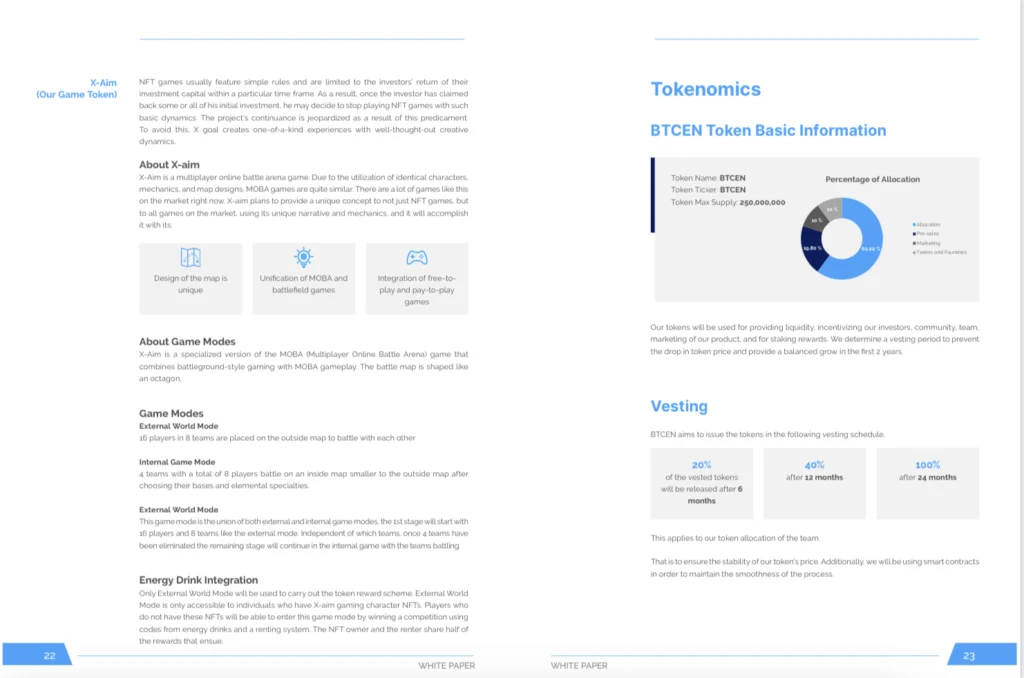
You probably won‘t build the new CryptoPunks. But here‘s the beauty of NFTs — They are extremely unpredictable. You might create something much bigger than CryptoPunks. Alternatively, your NFT project might not say the light of the day. Your NFT business plan could end up archived.
The truth is, it‘s a challenge. I won‘t be writing one of those traditional SEOd articles that are telling you an NFT project will make you hundreds of thousands. In fact, based on experience, there is a high chance it won‘t make anything at all.
But you know what? So is starting a restaurant, a coffee place, a freelancing career, or any business whatsoever. Every business has a risk. So if you‘re thinking of creating an NFT project, I should not be the person who would stand in your way. No one should.
I‘ve created a whitepaper and a pitch deck for a client in the NFT and crypto industry. Let me showcase it to you; may it guide you in creating yours. Oh, and if you want to download it to share it with a colleague, you‘ll find the PDF available.
Finally, before starting this article, you need to know that we do not endorse BTCEN‘s product whatsoever. The article is meant to show you how we wrote a whitepaper and a pitch deck for an NFT project and how you could too.
If you have any questions, we always check the comments!
The NFT Business Plan
Whenever I get a client request whether they want an NFT Business plan or a white paper, I always explain that at 99% of the cases, they‘re the same thing. In the crypto world, the word whitepaper is just more common than the word business plan.
The contents are almost exactly the same. Yet, instead of financials, we put tokenomics.
Here‘s the whitepaper. (Oh, and the company is BTCEN .)
After you check it out, take a look at the pitch deck.
That being said, here‘s the structure of this NFT whitepaper.
NFT Whitepaper Structure
Executive summary.
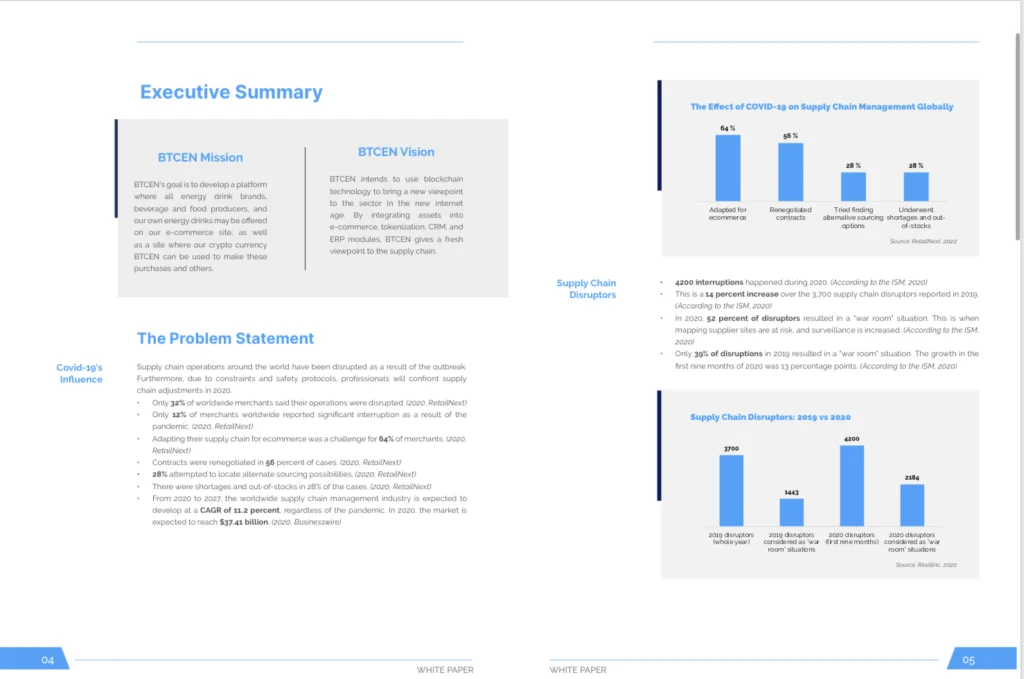
The executive summary is what we usually write at the end of the whitepaper or business plan. It simply states the most important elements mentioned in the plan. Think of it as something that would summarize the plan for an investor who is in a rush.
Hence, it ought to be showing the opportunities in investing in this project quite well.
After that, we start showcasing the market opportunity. It is crucial to convey the market opportunity in an NFT project. That is simply because it‘s quite volatile. So investors might want to invest in a dip, or to generally ensure that the market is growing in this industry.
The Project
What the project does is what should be pitched at this exact time. After conveying that there‘s a big market opportunity, it‘s time to tell the world what the project is. In this case, it‘s BTCEN.
This was the most time consuming section, and you can predict that seeing how complex it is. We had to create a token release schedule based on researching similar NFT Business plans.

A fair amount of projections had to be placed. As mentioned earlier, this market is volatile and unexpected. Yet, after communicating with the BTCEN team quite well, we were able to reach the perfect projected token release schedule and Tokenomics.
It‘s crucial at each NFT project that one states what‘s the plan. There will be a community and they will be investing in your NFTs. For that, you need to convey to them in your business plan the details of your NFT future plan. Are you now raising funds? What are you going to use them for? How long is the expected date for minting the NFTs? Etc…
Finally, showcasing the team is, I would say, the most important aspect of an NFT project. BTCEN‘s final whitepaper showcases their team. When this was in the works, they were still hiring a team to manage this. However, before investing in any NFT, you ought to know who created it.
NFT Pitch Deck Structure
The BTCEN team requested a pitch deck derived from this whitepaper, and so we delivered.
Now this is not very connected to the NFT project. The problem is one that they‘re targeting. That was the supply chain issues that were happening in the past few years.
They‘re focusing on a niche of beverages and trying to help them with their supply chain management.
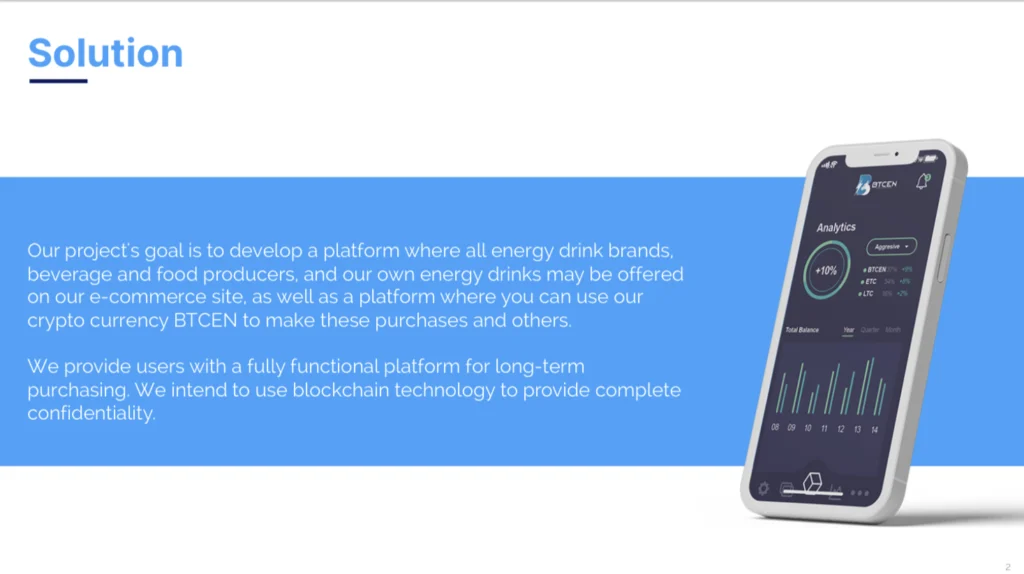
Business Model
This is the most suitable connection to the whitepaper and the business plan. Their business model resides around their NFTs and their crypto token.
Market Size
It‘s not only about the beverages market (or the niche focus of energy drinks). It‘s also the NFT market, the gaming market, and any other market that could potentially invest in their NFTs.
Competitors Analysis
Then the deck showcases some of the competitors in terms of tokens and their market caps.
Displaying this similar to displaying a financial model in a typical pitch deck is what we‘re intending to do in this slide. Rather than pitching a lot of details, the token information and what they intend to invest the token‘s budget in is sufficient.
Following that, this slide showcases what they intend to do with the investors fund at that stage. Remember that this is an investor deck at the end of the day; so it is supposed to raise funds pre-token launch.
For the above slide, they‘re mentioning how much they‘re raising and what equity they‘re giving accordingly.
As mentioned in the whitepaper, a timeline is critical to allow investors to understand what the plan of the startup is.
Again, as mentioned earlier as well, showcasing the team is critical.
NFT Business Plan Consultants
If you like this NFT white paper and deck, do hit a like below or tell me in the comments. If you‘re looking for someone to help you in creating your own whitepaper, pitch deck, or NFT business plan, simply search on Albusi for NFT whitepaper, and you‘ll find freelancers to do that for you with some samples.
Meet The Author Of This Article

I’m Al Anany , the CEO of Albusi.
My articles are here and on Medium, whilst my videos are on Youtube.
I specialize in Tech, hence NFTs and the crypto market are markets that I highly believe in.
Leave a Reply Cancel reply
Save my name, email, and website in this browser for the next time I comment.
Related Posts
How to start a glitter business – your guide for 2023.

How To Start A Car Wrapping Business

Blockchain Whitepaper

Starting A Lawn Care Business – 2023 Guide for Grants

The Most Promising NFT Business Models For Brands And Content Creators
March 31, 2023

In the world of digital marketing, Non-Fungible Tokens (NFTs) are quickly becoming the talk of the town. As NFT adoption increases, brands and content creators are exploring new opportunities to leverage this technology to enhance their business models.
However, with the growing popularity of NFTs, it can be overwhelming to navigate through the various business models and determine which one is the best fit for your brand. That's where we come in. We understand the pain points of businesses struggling to adapt to the ever-changing digital landscape.
In this article, we will look into the advantages of integrating an NFT business model into your brand or offering, different NFT business models, and how to market your NFT collection.
Why should you consider using NFTs?
You may be wondering about the benefits of integrating NFTs into your digital strategy. Here are a few reasons why you should consider using NFTs:
1. Authenticity and ownership of digital assets
One of the best things about blockchain technology is that it makes it easier to verify the ownership and authenticity of digital assets. This is especially important for artists, musicians, and anyone else who wants to protect their intellectual property and prevent their content from being stolen or misused. NFTs can create a permanent and transparent record of ownership on the blockchain, making it easier to determine ownership and enforce copyright laws.
2. Creates new revenue streams
NFTs also provide new revenue opportunities for brands and content creators. Because NFTs are one-of-a-kind and cannot be replicated, they can fetch high prices in auctions and marketplace listings. This means that your digital asset has the potential to generate significant earnings.
Furthermore, NFTs can be sold multiple times, and original creators can earn royalties on secondary sales, allowing creators to generate revenue from their work long after it has been sold.
Read more: How NFT Artists can Create a Buzz on Social Media
3. Build engagement with your audience through an NFT community
NFTs can also be used to engage with your fans and build a community around your digital collectibles. Your audience can buy NFTs to show their support for what you're doing. This instils a sense of ownership in your audience and nurtures a personal connection with them. Moreover, NFTs can be used to create token-gated experiences for NFT owners, such as backstage passes, meet and greets, and exclusive access to new releases.
Read more: NFT Token gating: How can brands leverage NFTs to build new brand experiences?
4. Potential investment opportunity
Because NFTs are one-of-a-kind and scarce, their value can increase with time, and certain NFT projects have already turned into investment opportunities. NFTs, just like traditional investments, can be bought and sold on several other NFT platforms and marketplaces, making them a desirable choice for investors.
Top NFT business models to watch out for in 2023
Let's look at some of the most popular NFT business models and their examples to gain a better understanding of the NFT market and its future potential.
1. Turning digital artworks into NFTs
Generating NFT artwork and launching NFT collections is a well-known NFT business model that has contributed to the popularity and mainstream adoption of NFTs. Launching NFT projects involves creating one-of-a-kind digital artworks that are verified on the blockchain network.
When you own an NFT, you own the original work of art, which you can sell on marketplaces. These digital artworks might take the form of paintings, sculptures, or animations. Artists that sell their artwork as NFTs can earn a lot of money, and NFTs give artists a new opportunity to commercialize their work.

Beeple's "Everydays: The First 5000 Days" artwork, which sold for $69 million at Christie's auction, is one of the most well-known examples of NFT art.
2. Launching music as NFT
Music NFTs are digital tokens that represent ownership of a particular music track, album, or even concert ticket. These tokens allow fans to invest in the artist's music, participate in revenue sharing, and gain access to exclusive content. Music NFTs can also provide an additional revenue stream for artists, who can sell them directly to their fans.

A popular example of a music NFT is Kings of Leon's album "When You See Yourself," which was sold as an NFT for $2 million.
Read more: NFT for Music - How Musicians Can Use NFTs to Increase Profit?
3. Fashion NFTs
Fashion NFTs are digital tokens that represent ownership of a unique fashion item, like a limited-edition sneaker or a designer handbag. These tokens can be used to verify authenticity, track ownership, and enable peer-to-peer trading. NFTs in fashion can offer a new way for fashion brands to engage with their customers and offer them exclusive, one-of-a-kind products.

For example, fashion brand RTFKT Studios has released limited-edition sneakers as NFTs that sold for hundreds of thousands of dollars.
Recommended reading:
NFTs In Fashion: How Brands Can Capitalize On This Emerging Trend
How are brands embracing marketing in the Metaverse?
4. In-game assets
In-game assets are digital items that can be purchased, sold, or traded within video games. They can include things like weapons, skins, avatars, and other virtual things that let players change how they play. Players can own and control these in-game assets thanks to the development of blockchain technology and the use of non-fungible tokens (NFTs).
Moreover, these new NFT business models can provide a new revenue stream for game developers. By creating unique and desirable digital assets, game developers can generate additional income from players who want to purchase these items. NFT-based gaming assets can also provide a new way for players to monetize their gaming experience by allowing them to sell or trade their unique digital assets and items with other players.

Axie Infinity is a prime example of a blockchain-based game that utilizes NFT technology-based in-game assets. In this game, players can earn and trade NFT-based creatures called Axies. These digital creatures have unique characteristics and abilities, making them highly valuable and sought after by players. As a result, players can sell or trade their Axies for cryptocurrency, providing them with a new way to earn money through their gaming experience.
Web3 Gaming Adoption: Best Strategies To Reach Mainstream Audience
Blockchain Gaming: Best Blockchain Networks To Build Web3 Games
5. Create token-gated content
Token-gated content is a unique business model in which digital content can only be accessed by people who have a certain NFT. A token-gated NFT platform is a good business model as it creates scarcity and exclusivity, driving up demand and increasing the value of the NFTs.
It also lets creators make money from their work and give their most loyal fans special access. The NBA Top Shot platform is a prime example of this business model, where users can buy NFTs representing iconic basketball moments and gain access to exclusive content.
Token-gated content makes fans feel like they are part of a community and gets them involved. It also gives creators a new way to interact with their audience while giving collectors and investors access to rare and exclusive digital assets.
NFT Token gating: How can brands leverage NFTs to build new brand experiences?
Shopify NFTs: How To Setup A Shopify NFT Store
6. Launch NFT-based loyalty programs
NFT-based loyalty programs are a promising business model that rewards customers with digital tokens for their purchases or engagement with a brand. These tokens can be traded or redeemed for discounts, exclusive content, or other rewards, creating a loyal community around the brand.
For brands, NFT-based loyalty programs can incentivize customers to make repeat purchases, create a new revenue stream, and provide a new way to engage with their customers.

An example of an NFT-based loyalty program is Starbucks Rewards, which rewards customers with stars for their purchases and is exploring the use of blockchain technology and NFTs to enhance its program.
NFT-based loyalty programs give brands a unique chance to build a loyal customer base while trying out new ways to make money and interact with their customers.
Read more: How To Build An NFT Loyalty Program For Your Brand
7. Launch an NFT marketplace
NFT marketplaces are online platforms where creators can sell their digital art directly to buyers without intermediaries such as art galleries or auction houses. These marketplaces create a sense of exclusivity and rarity, as each NFT is unique and valuable.
NFT marketplaces offer a good NFT business model for creators to monetize their digital creations and for buyers to invest in one-of-a-kind digital assets. Examples of popular NFT marketplaces include OpenSea, Rarible, and SuperRare. As the NFT market continues to grow, NFT marketplaces will become increasingly important in facilitating the sale and trade of digital assets.
8. Create an NFT community
NFT communities are groups of people who share an interest in NFTs, blockchain technology, or digital art. They give artists a place to show off their work and get to know potential buyers. They also let collectors find new artists and connect with people who like the same things they do. Members of NFT communities feel like they belong, which makes them a good model for both creators and collectors.

NFT communities are a good NFT business model for creators, as they provide a platform to increase visibility and build a following. The Bored Ape Yacht Club is an example of an NFT community that offers members exclusive access to events and merchandise, creating a sense of exclusivity and value around the Bored Ape NFTs.
9. Build an NFT launchpad
Launching an NFT launchpad can be a lucrative NFT business model for entrepreneurs as it provides a platform for creators to showcase and sell their digital assets while also offering a new way for collectors to discover and invest in up-and-coming artists.
By launching an NFT launchpad, Web3 entrepreneurs can attract a wide range of creators looking for a platform to sell their digital assets. These platforms provide a place for creators to gain exposure and reach a wider audience, which can lead to increased demand and higher prices for their NFTs.
Furthermore, NFT launchpads can also be a good investment opportunity for entrepreneurs. By charging a commission or transaction fee for every NFT sold on the platform, entrepreneurs can generate a steady stream of revenue.
Examples of successful NFT launchpads include Nifty Gateway and Foundation. These platforms have attracted a large and dedicated user base and offer a diverse selection of digital assets from established and up-and-coming artists.
How brands and content creators can leverage NFT marketing?
As the popularity of non-fungible tokens (NFTs) continues to rise, brands and content creators are looking for ways to capitalize on this trend and incorporate NFT marketing into their business strategies.
If you're looking to leverage NFT marketing for your brand or content, consider partnering with us. We are a web3 marketing company that specializes in helping businesses grow in the NFT space. With our expertise in NFT marketing and our deep understanding of the blockchain ecosystem, we can help you create a successful NFT marketing strategy that resonates with your audience and drives results
Related articles
How To Create A Perfect NFT Roadmap For Your Collection
How To Build dApps On Polygon Network
How To Write A Perfect Litepaper For Your Crypto Project
Tokenomics Design 101: How To Design A Perfect Tokenomics Model
Metaverse Business Models For Brands And Content Creators
Bitcoin Ordinal Marketing Strategy
From The Blog
You may also like.

Subscribe to our newsletter!
Get the latest web3 marketing information
Stay in touch
Ready to talk.
Feel free to message us

GrowthChain is a disruptive web3 marketing agency looking to propel your customer base. We focus on DAOs, DeFi, NFT and Crypto projects.

GrowthChain Designed, 2023
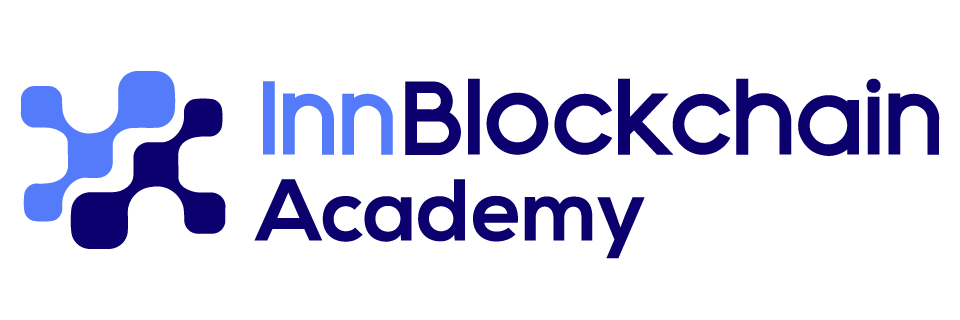
Select Page
NFT Marketplace Business Model – The Ultimate Guide!
Posted by Kirthika | Apr 20, 2023 | NFT , Topics | 0 |
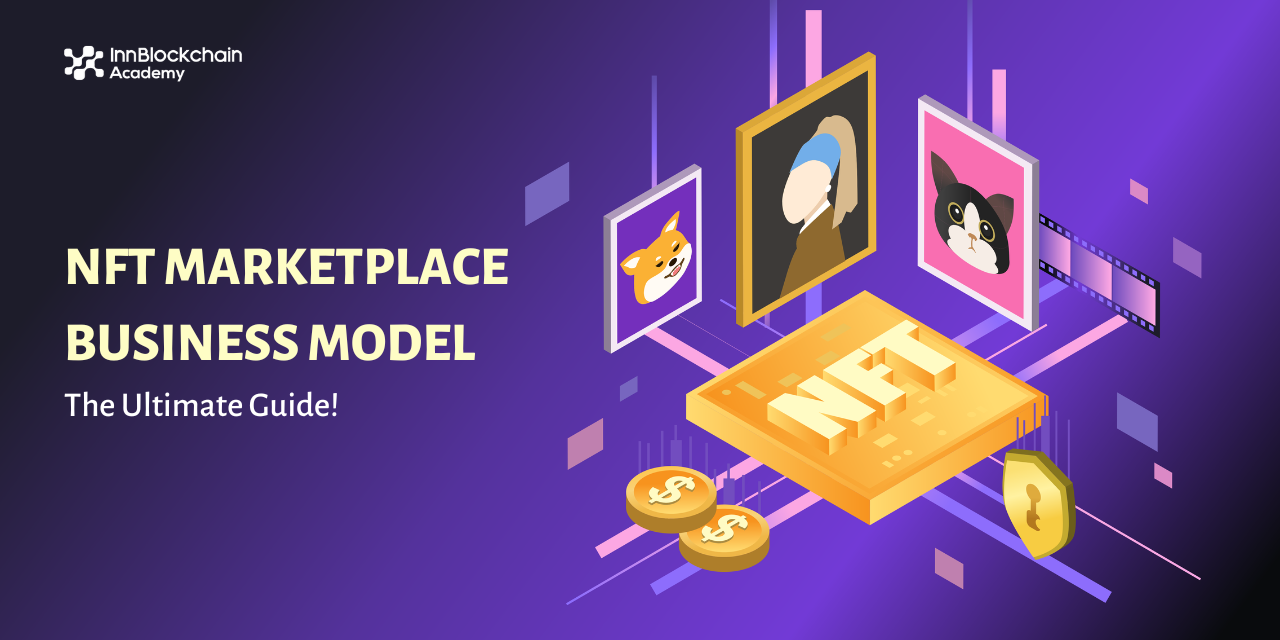
Are you peeking for ways to grow a business with the NFT marketplace? Wondering !! What works and what doesn’t work? Here is the NFT Marketplace business model for your to sketch out the plan for your business.
In this blog, you can learn a complete guide to the NFT marketplace business model help you to structure your NFT marketplace to avoid mistakes and much more.
It is a challenging task for businesses and creators to stand ahead and grab the concentration of their audience. Generally, we bombard with messaging from media, brands, and other creators.
Among several methods, one of the unique ways is using Business Model which helps your NFT marketplace to stand ahead and build robust connections with its audience, even in saturated and crowded markets.
You may have the question how?
Here the business model comes into the picture! This guides you in the creation of a plan for achieving your business objectives. Before we step into the topic; let’s take a rapid look at what an NFT marketplace is and why an NFT marketplace needs a business model.
See Every Detail Unfold: Download the NFT Business Model Canvas in High Resolution
What Is NFT Marketplace Business Model?
NFT marketplace business model helps to determine and analyze several aspects of the business model, allowing stakeholders and entrepreneurs to make informed decisions. The main purpose of using a business model canvas for the NFT marketplace is to facilitate a structured framework to understand and define the key components and considerations involved in running a successful NFT marketplace.
If you are eager to learn more, read our previous blog about how to start an NFT marketplace business . Now let’s step into the next topic why a business model is essential for the NFT marketplace.
Why Does NFT Marketplace Need A Business Model?
The NFT marketplace is a big business, really big business!!! global cryptopreneurs are more passionate about the business model.
The business model facilitates companies to visualize and analyze their strategy. This model updates as the company evolves, like changes in new streams, markets, and expansions.
The business model offers a central, common source of knowledge Via which every segment could add their special input from their appropriate domains. It is a template that defines the business – especially, how every segment interacts with others.
Moreover, the NFT marketplace uses the business model to assess, plan, or implement new models altogether. In this way, the business models highlight the key essentials and also confirm that no vital factors are forgotten.
To be precise, a well-defined business model is necessary for the success of an NFT marketplace. It supports you in generating revenue, depicting the value proposition, cultivating customers, grabbing investors, and confirming scalability.
NFT Marketplace business model: 9 Standard
The business model of the NFT marketplace is made up of 9 building blocks that explore the logic of how a company plans to provide money and make money.
The 9 blocks cover the 4 main areas of a business they are
- Infrastructure
The business model is like a “Blueprint” for a strategy to be executed via organizational structures, systems, and processes.
In one step below, you can learn more about the 4 main areas where the 9 blocks are fitted.
Let’s spend time…
Offering – Value You Offer!
The “value” that your NFT marketplace provides might be defined in various ways based on the context, but generally, it refers to the advantage or benefits that your customers acquire from the company’s offerings.
Let’s be more specific…
NFT Marketplace Value Propositions
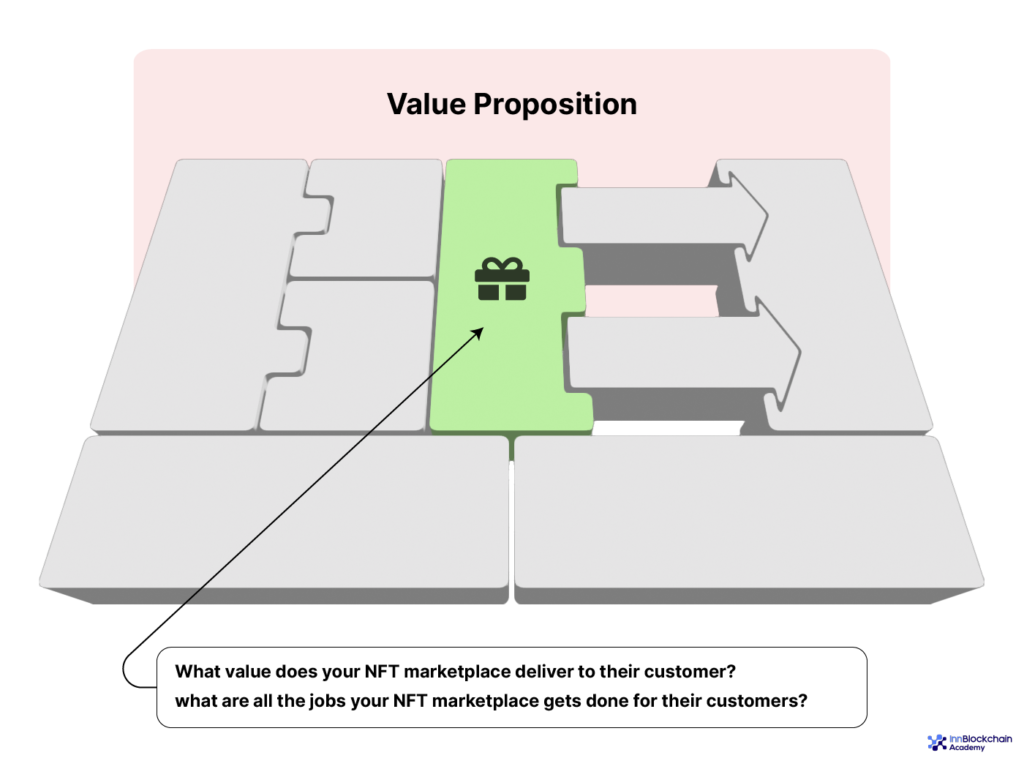
Your “value propositions” refer to the heap of products and services which creates value for a particular customer segment. To put it in one word, it summarizes why the customer would select your product or service. And the benefits they are going to receive from your NFT marketplace. It has to answer the following questions:
1. What value does your NFT marketplace deliver to its customers?
2. What are all the jobs your NFT marketplace gets done for its customers?
3. What customer requirements does your NFT marketplace satisfy?
4. How much heap of products & services are you going to provide to your customer segment?
Your value proposition says why customers turn towards your NFT marketplace. It resolves your customer’s issues or meets your customer’s requirements. Each value proposition includes products/services which are provided based on the need of the customer segment.
In some cases, value propositions might be innovative and denote a new or disruptive offer. Others might be similar to existing market offers along with addon attributes and features.
Example: Let’s consider OpenSea’s Value Propositions. It consists of:
- Buyers: A suitable NFT marketplace with a large number of NFTs. Ethereum gas fees were covered by the platform;
- Sellers: NFT marketplace with free entry and also provides a massive offering for the buyer. A small fraction of the amount is deducted from the total NFT cost. This is charged as a service fee. As the platform covers gas fees, customers can make more profits.
Now, let’s peep on to the second category, “Customers”, which covers all elements of your business’s end users.
Customers – All About End Users!
The word “Customers” in a business context refers to individuals or entities who buy products or services from the company. Here customers are divided into three categories they are
Customer Segments
- Customer Channels
- Customer Relationships
Let’s discuss them one after another…
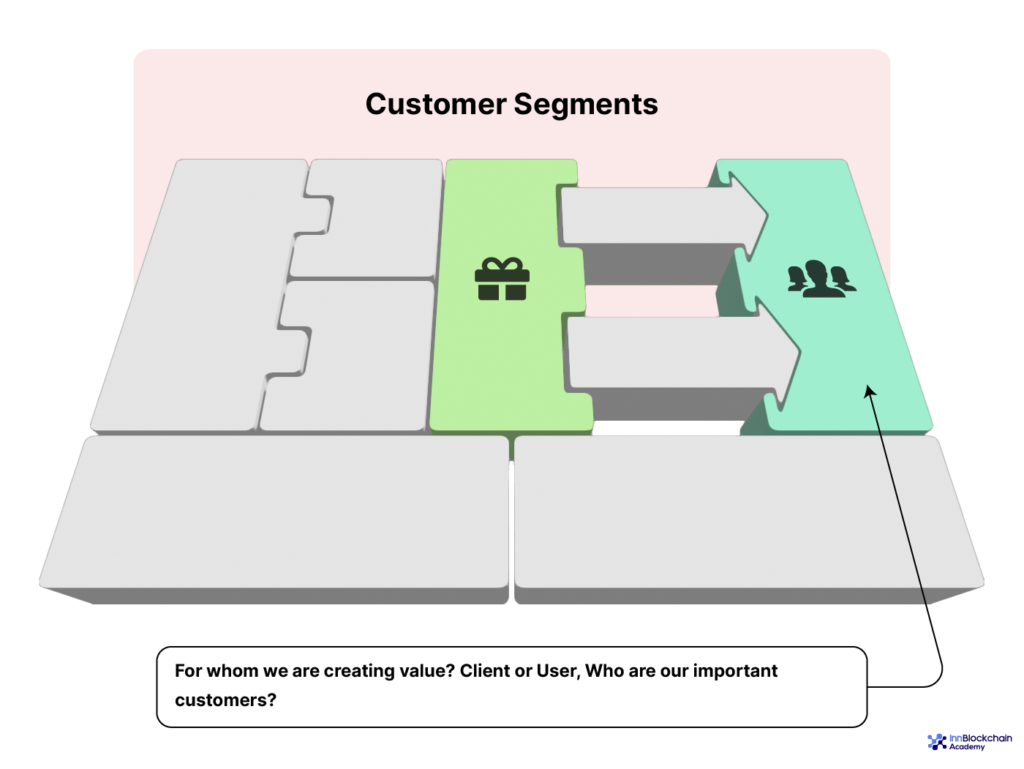
Your Customer Segments refer to a group of people or an organization that the NFT marketplace serves or targets. This includes users who are necessary for the working of the business model. It must answer the question
- For whom we are creating value?
- Client or User, Who are our important customers?
Customer Segments comprise customers who are the heart of the business model. Without profitable customers, your company generates revenue or survives for a long time. To satisfy your customers, you must group them into different segments with common needs like common behavior, jobs to get done, and more.
The customer segment may be small or large. But you have to decide which segment to ignore and which segment to serve. Once it is decided, you can design a business model based on your customer needs and the job to be done.
The customers are categorized into the distinct group if they meet the following features:
- specific requirements explaining the creation of a product to satisfy its requirements;
- they are reached via the distribution channel;
- diverse types of relationships;
- the difference in the level of profitability;
- they wish to pay for various aspects of a value proposition.
Example: Let’s consider OpenSea ‘s Customer segment. It consists of:
- Buyers : Who purchase NFTs from others, in the case of a famous NFT, they commit themself in auctions to outbid others;
- Sellers : Who sell, advertise, and design NFTs either as collections or as single assets.
NFT Marketplace Channels
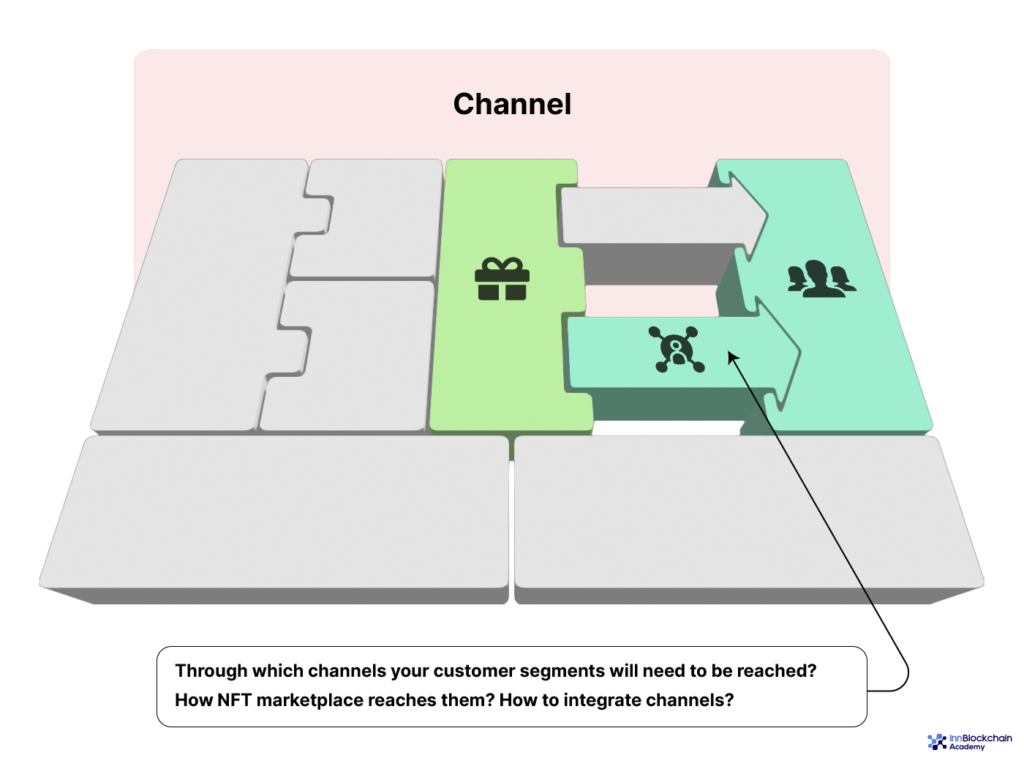
Your Channels refer to several methods by which a company reaches and interacts with its customer segments to deliver its value proposition. It must answer the following questions
- Through which channels your customer segments will need to be reached?
- How does the NFT marketplace reach them?
- How to integrate channels?
- Which one is cost-effective?
- How to integrate with customer routines?
Your distribution, communication, and sales channels incorporate your company’s interface with customers. The channels are the customer’s touch point which plays a key role in the customer’s experience. Your channels must have to serve the following functions such as:
- Boosting awareness among customers about NFT marketplace’s products and services.
- Supporting customers to evaluate the NFT marketplace’s value proposition.
- Facilitating customers to buy particular products and services.
- Providing value proposition to customers
- Offering post-purchase customer support.
Example: Let’s consider OpenSea’s Channels. It consists of
- Website: Use a strong channel to reach and interact with your customers. Through the website, you can communicate and deliver value to your customers.
- App for Android and iOS: It is a key distribution channel through which your NFT marketplace could provide its services or products to its customers.
Customer Relationships of NFT Marketplace business model
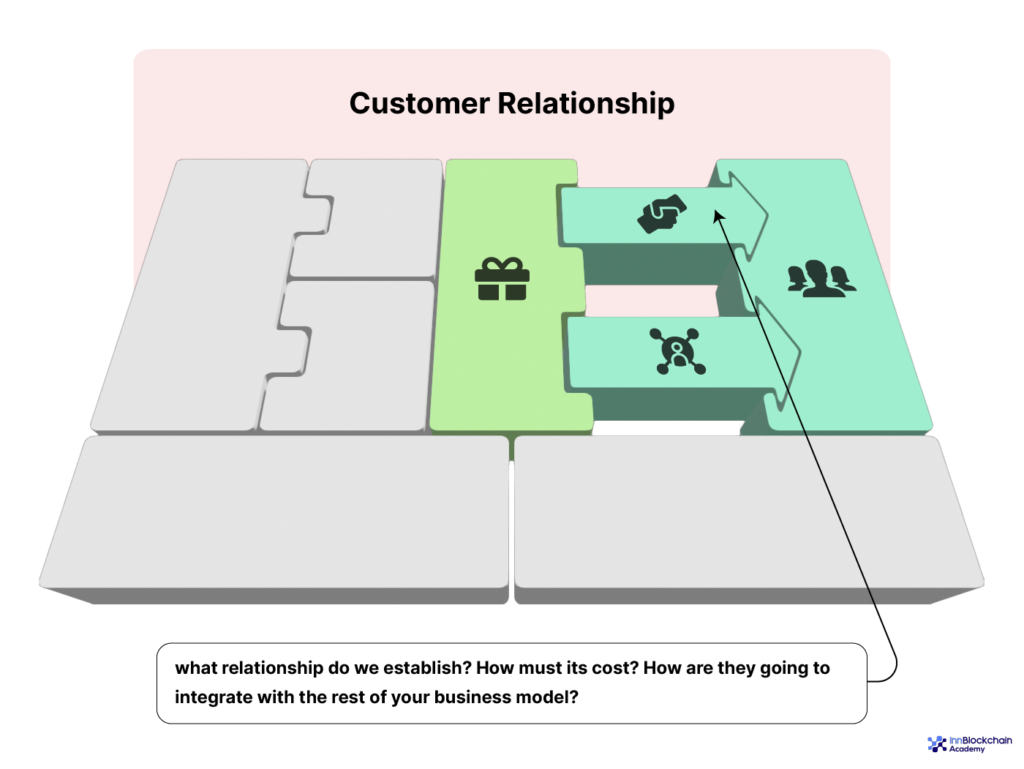
Your Customer Relationships refer to the way the NFT marketplace interacts with the customer segments to enhance, maintain, and establish a relationship with them. It must answer the following questions:
- What kind of relationship is established by the customer segments with your NFT marketplace?
- What relationship do we establish?
- How much its cost?
- How are they going to integrate with the rest of your business model?
The NFT marketplace must define the type of relationship it is going to establish with its customers. Relationships are established via various channels. The relationship may range from transactional to long-term, personal to automated, and aim to obtain customers, boost sales or retain customers.
Example: Let’s consider OpenSea’s Customer Relationship. It consists of:
- Customer Service: Requires authentic & consistent communication, readiness to listen & respond to customer feedback, and providing valuable responses to your customers via exclusive promotions and engaging content.
- Social Media: Requires involvement in building & sustaining a positive and engaging presence on numerous social media platforms which have numerous active customers.
Infrastructure – Things You Need To Focus on!
The value “Infrastructure” refers to fundamental things like partners, processes, and technology that are required for the proper functioning of your NFT marketplace. This section is categorized as:
- Key Partners
- Key Activities
- Key Resources
Let’s take a quick insight into each segment…..
Key Resources: Which to Emphasize?
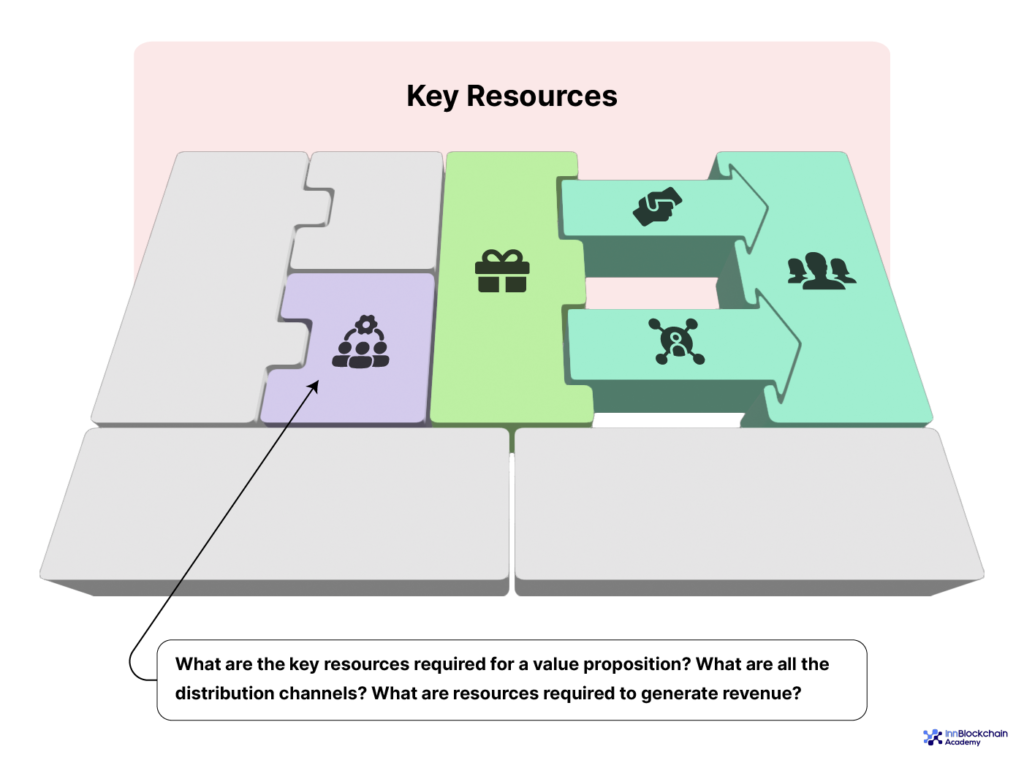
Your key resources refer to the most prominent assets like human, intellectual, financial, and physical that are essential to make your business model more effective. It must answer the following questions:
- What are the key resources essential for a value proposition?
- What are all the distribution channels?
- What are the resources essential to maintaining customer relationships?
- What are resources essential to generate revenue?
All business models need key resources. Your resources facilitate your NFT marketplace to reach the market, deliver a value proposition, maintain a relationship with customer segments, and gain revenue. Key resources may vary based on the kind of business model.
Example: Let’s consider OpenSea’s key resources. It consists of:
- App and Web Services: NFT marketplace utilizes these key resources to interact with its users in a digital environment.
- Active Sellers & Buyers: Refers to the key players who are taking part in buying/selling goods & services.
- Digital Assets: Refers to intangible resources that businesses utilize to create value & develop revenue.
Key Activity: What to focus on?
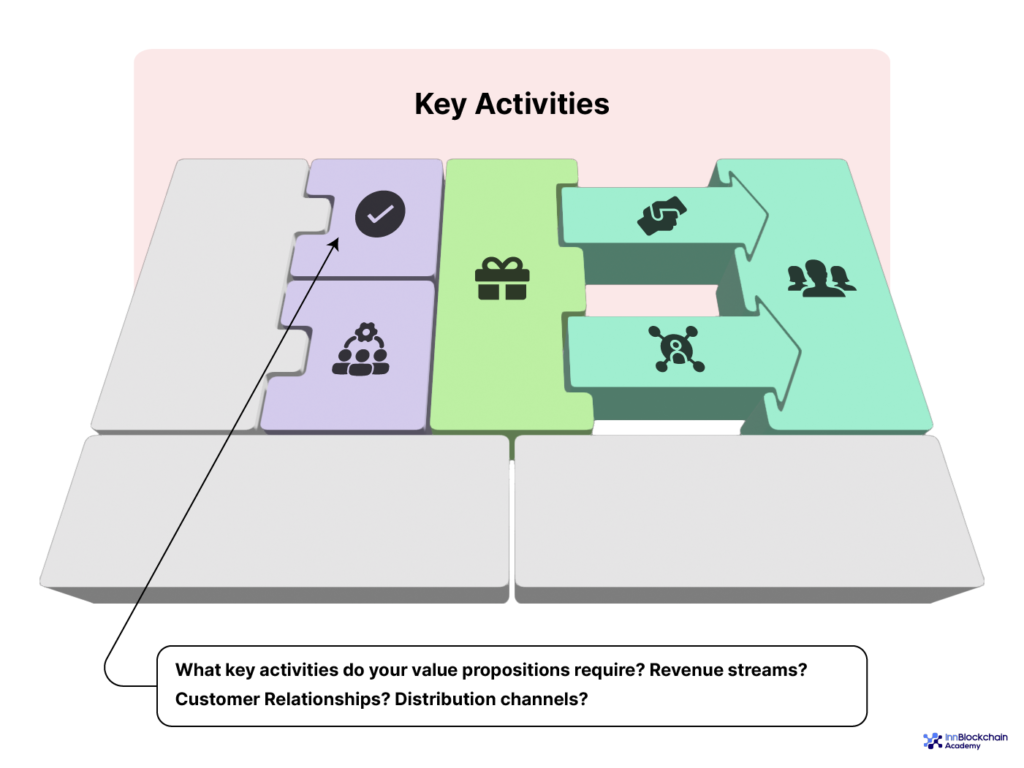
Your Key activity refers to the most important actions performed by your NFT marketplace to make their business model work effectively. It must answer the following questions
- What key activities do your value propositions require?
- Revenue streams?
- Customer Relationships?
- Distribution channels?
Key activities are tasks and processes which are necessary for the success of the NFT marketplace, and this is unique for every marketplace. Like key resources, they have to create and provide a value proposition, sustain customer relationships, research the market, and gain revenues. Key activity differs based on the business model types.
Example: Let’s consider OpenSea’s key activity. It consists of
- Payment Processing: Generate revenue through key activities like setting up a payment gateway, handling invoicing & billing, managing refunds & chargebacks, and assuring compliance with appropriate standards & regulations.
- Marketplace Management: Connects buyer & seller to handle all activities and processes related to administration & operation taking place within the marketplace.
- Peer-to-Peer trade of digital assets: By providing a user-friendly & reliable platform to trade digital assets. Your NFT marketplace can grab more customers, develop high revenue, and create a strong brand.
Key Partnerships: Whom to Collaborate?
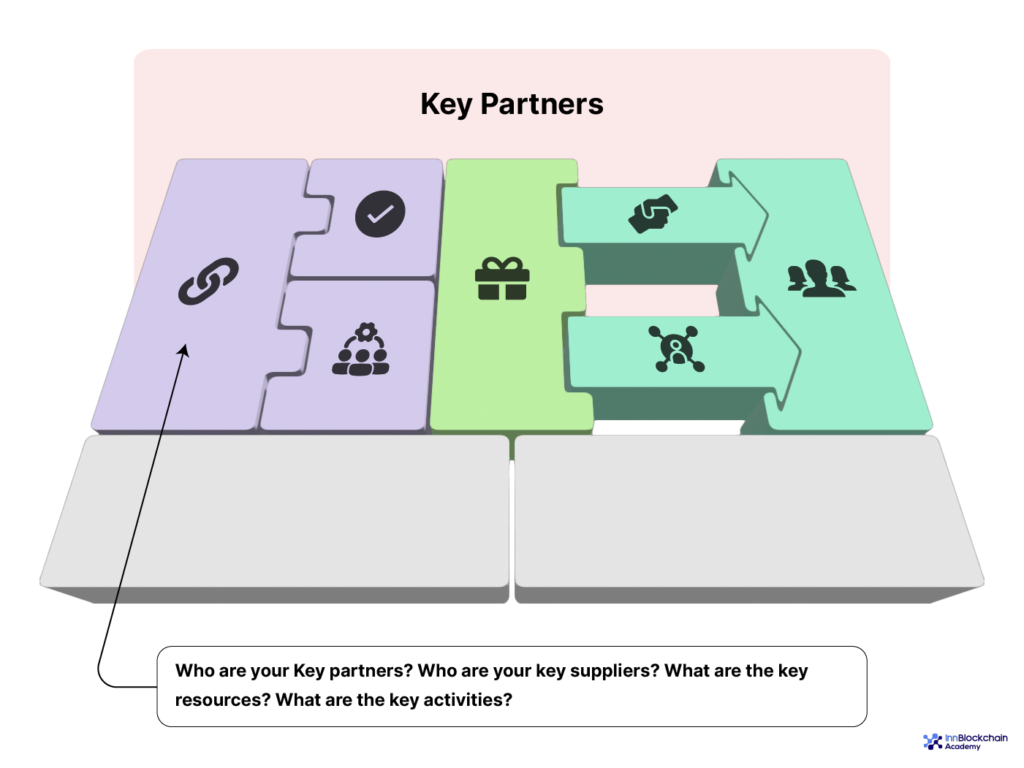
Your Key partners refer to distribution partners or suppliers who maintain a strategic relationship with your NFT marketplace to make your business model work successfully. It must answer the following questions:
- Who are your Key partners?
- Who are your key suppliers?
- What are the key resources your NFT marketplace is going to get from your partners?
- What are the key activities your partners are going to perform for your NFT marketplace?
Most of the NFT marketplace develops a partnership for various reasons, nowadays partnership becomes a cornerstone of numerous business models. Generally, the NFT marketplace creates a partnership to improve its business models, minimize risk, or obtain resources. You can classify partnership as,
- The strategic partnership between non-competitors
- The strategic partnership between competitors
- Joint ventures to build new businesses
- Buyer-Supplier relationships to assure trustworthy supplies.
Example: Let’s consider OpenSea’s Key partnership. It consists of
- Investors: Investors establish a strategic relationship with your NFT marketplace by providing expertise, financial resources, connections, and more.
- Buyers: Buyers collaborate with your NFT marketplace by joint purchasing, co-marketing, negotiating with a supplier, and joint product development to achieve a shared goal.
- Sellers: They involve in offering goods or services, donating marketing resources, or sharing knowledge & expertise with your NFT marketplace to maintain the relationship.
Finally, the business model talks about “Finance”, which represents all the expenses and revenues of your NFT marketplace business.
Finances – Know Your Expense & Revenue!
The value “Finances” refers to the income and expenses of your NFT marketplace. We split this into:
- NFT Marketplace Revenue Stream
- NFT Marketplace Cost Structure
NFT Marketplace Revenue Streams
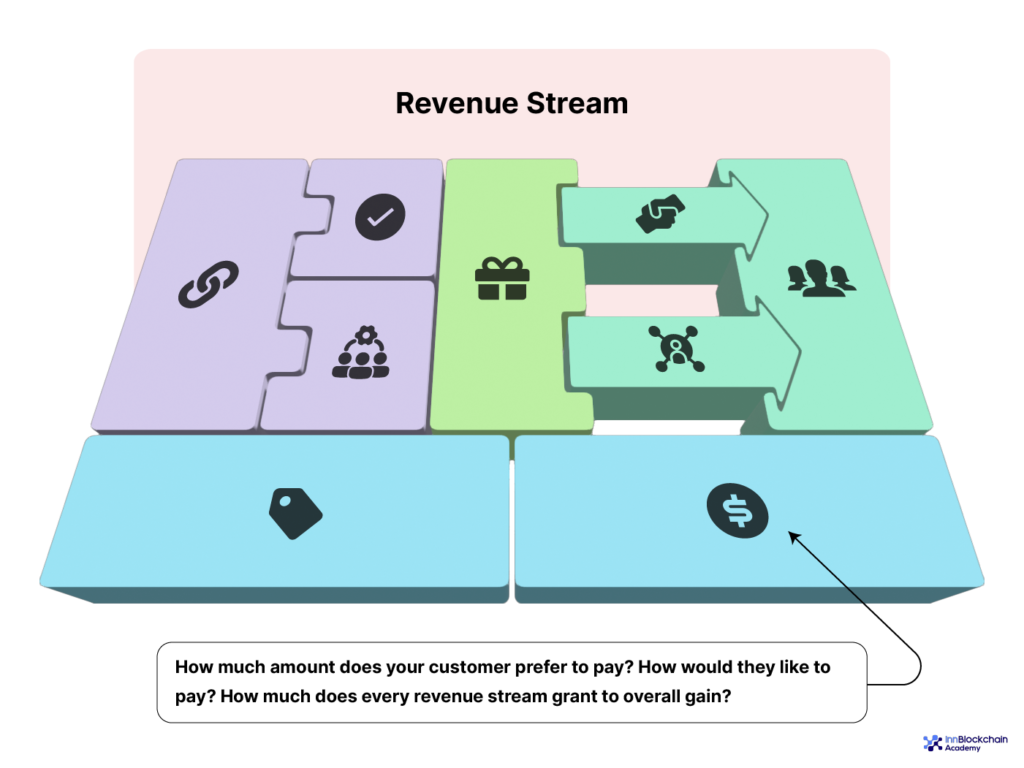
Your revenue streams refer to sources of income that your NFT marketplace generates from its customer segments. It consists of the following questions:
- How much does your customer prefer to pay?
- How much does every revenue stream grant to overall gain?
- How would they like to pay?
Customers are the heart of the business model, then Revenue Streams are its arteries. You have to ask yourself, what value does your customer segment prefer to pay? answering the question will facilitate you to develop one/more revenue streams from every customer segment.
Every revenue stream has various pricing mechanisms like yield management, volume dependent, market dependent, auctioning, bargaining, or fixed list prices. Your NFT marketplace could involve tractional revenues from one-time customer payments or recurring revenues.
Example: Let’s consider OpenSea’s revenue streams. It consists of
- Service Fee/Minting Fee: It is the charges that your company imposed on your users for the services it offers. These fees might be charged based on a recurring or one-time basis, based on the nature of the service they offer.
- Registration Fees: It the fees paid by the customer with your NFT marketplace to register for a service or to gain access to a product.
- Contract Approval Fees: This is done by charging fees from customers for approving or reviewing a specific project or product service.
NFT Marketplace Business Model: Cost Structure
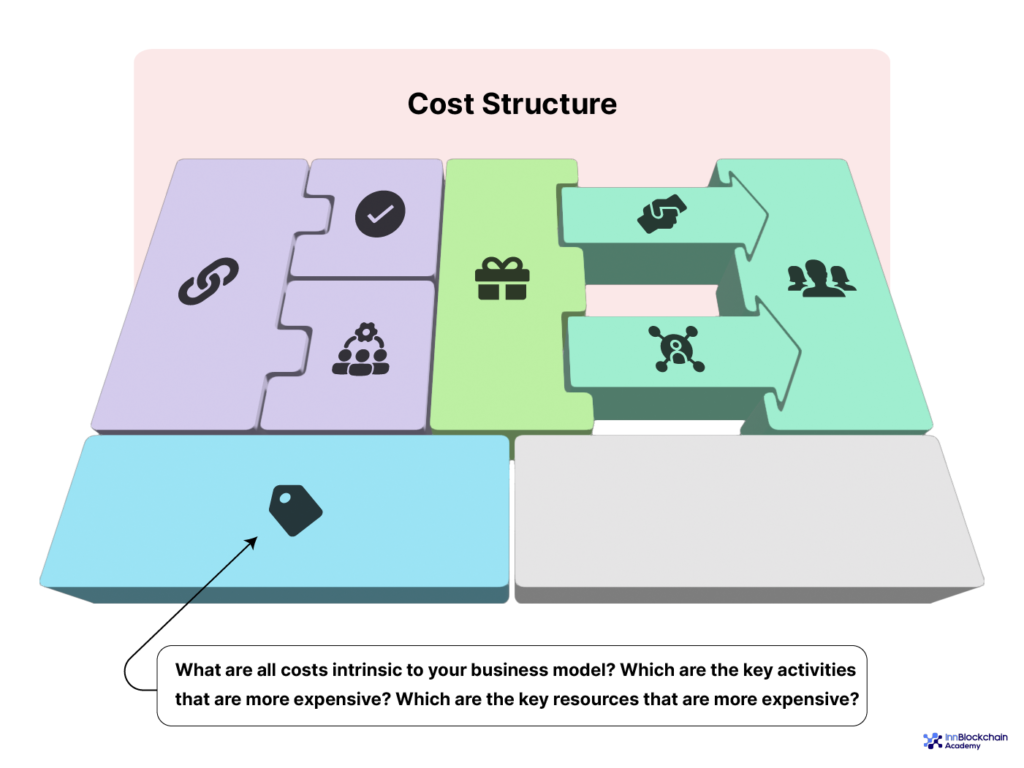
Your “cost structure” refers to the costs required to operate throughout your NFT marketplace. These incorporate costs spent for infrastructure, costs spent on employees for their work, and costs associated with all activities as well as sourcing Via key partnerships. It must answer the following questions:
- What are all costs intrinsic to your business model?
- Which are the key activities that are more expensive?
- Which are the key resources that are more expensive?
This building block briefs about the most prominent costs necessary to operate your business model. Designing & Offering value, sustaining customer relationships, and generating revenue all include costs. These costs are calculated once the key activities, key resources, and key partnerships are defined.
Example: Let’s consider OpenSea’s cost structure. It consists of:
- Payment Processing Fees: A kind of fee charged by the third-party payment processor for processing the user’s transactions.
- Salaries: A regular or fixed payment made to the employees for their services or work.
- Website Maintenance: Ongoing activities & costs associated to keep a website secure, functional, and up-to-date.
To be in a nutshell, a business model is an efficient way to group all elements from cost to the revenue stream. Doing so helps you with a deep overview of the intended business model. Whether you wish to update the existing strategy or you wish to build a new company, the business model is the best way to obtain an initial overview and assess direction as early as possible. Like this:
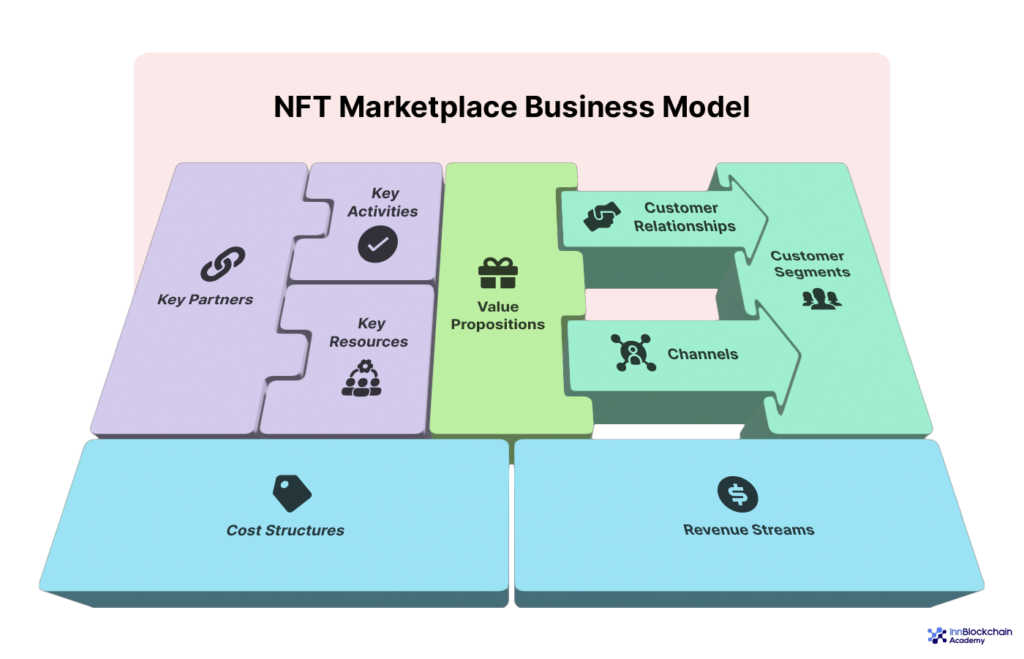
I hope that you might have gained knowledge from the above section. So take the time to craft each and every segment to complete your company’s strategies in the business models.
For your knowledge, let me share an example of crafting a business model for the NFT marketplace.
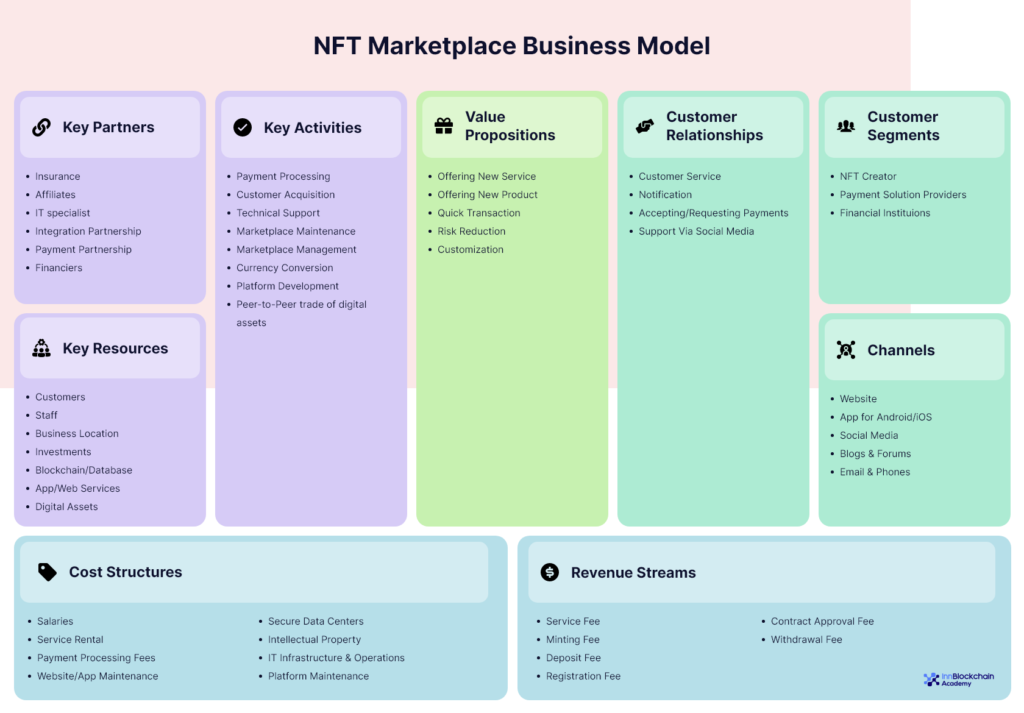
Now it’s time to wrap.…
Conclusion
Just like other business models, the NFT marketplace is a combination of ideas, and there are no rules on how every segment operates and functions.
The increasing popularity of the NFT Marketplace results in numerous transactions happening on the platform, which ultimately results in high ROI. Hence, ready to sketch out your business model to develop a better NFT marketplace in the future!
Frequently Asked Questions
Is there any possibility to create my own NFT marketplace?
Yes, you can create your own NFT marketplace with technical expertise in smart contracts, blockchain development, and web development. Alternatively, you can use white-label NFT marketplace solutions to create an NFT marketplace platform according to your brand.
How could I get started as a creator or artist on an NFT marketplace?
To get started as an artist
- Choose a marketplace
- Create your NFTs
- List your NFTs
- Promote your NFTs
What is the purpose of the business model for an NFT marketplace?
The key purpose of the business model for an NFT marketplace define how the marketplace generates revenue and sustains its operations. It sketches out the procedures and mechanisms for the platform facilitating buying, selling, and trading of NFTs by creating value for both marketplace and its users. A well-defined business model supports the marketplace to identify its target audience, determining fee structure, and implementing efficient marketing and growth strategies.
How NFT marketplace secure NFTs?
NFT marketplace executes verification processes and standards to guarantee the authenticity of NFTs. This includes working with creators or artists directly to examine their ownership and originality of digital assets.
About The Author
I am Kirthika basically a good explorer of the modern trends and revolutions in the crypto industry. If you are a crypto business seeker, wish to Learn More About Crypto Strategy? Grab my blog to explore recent updates and new ideas. Welcome to my crypto world....!
Related Posts
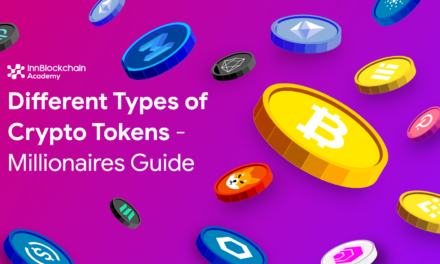
Different Types of Crypto Tokens – Millionaires Guide
December 8, 2023
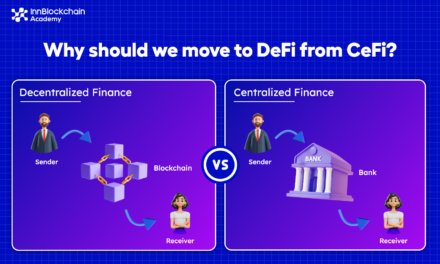
Why Should We Move To DeFi From CeFi?
August 24, 2023
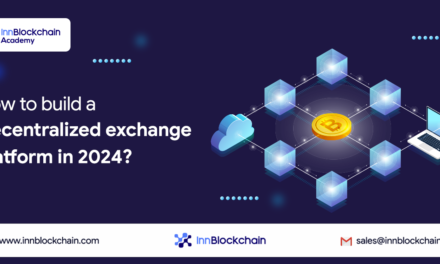
How to build a decentralized exchange platform in 2024?
January 23, 2024
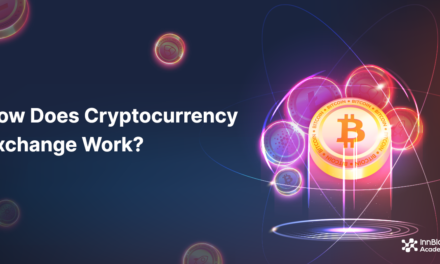
How Do Cryptocurrency Exchange Work?
May 26, 2023
#ezw_tco-2 .ez-toc-title{ font-size: 120%; font-weight: ; color: ; } #ezw_tco-2 .ez-toc-widget-container ul.ez-toc-list li.active{ background-color: #ededed; } Table of Contents
Get more tips & guidelines to launch a crypto business, subscribe us.
Select the industry Crypto DeFi NFT Wallet Token
We swear we won’t ever use your information for bad.
How To Start An NFT Business

- How-To Guides
- Software Tutorials
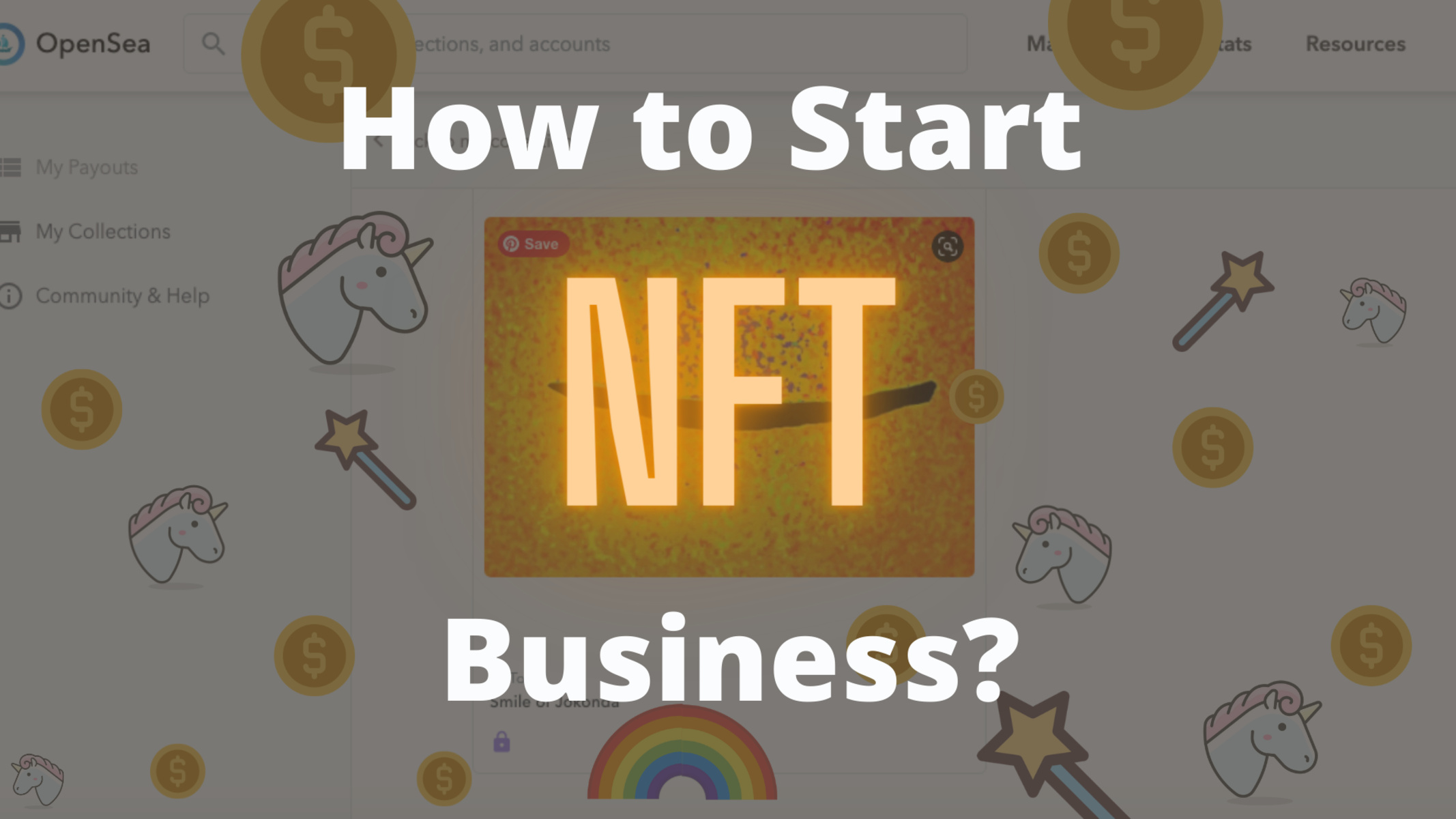
Introduction
Welcome to the exciting world of non-fungible tokens (NFTs)! In recent years, NFTs have taken the digital art and collectibles space by storm, revolutionizing the way we buy, sell, and trade unique digital assets. Whether you’re an artist, a creator, or an entrepreneur, starting an NFT business can be a lucrative opportunity to showcase your talent and monetize your creations.
But where do you start? How do you navigate the ever-evolving landscape of NFTs, and more importantly, how do you stand out from the crowd? In this guide, we’ll walk you through the essential steps to help you kickstart your NFT business and find success in this booming industry.
Before diving headfirst into the world of NFTs, it’s crucial to have a solid understanding of what they are. Simply put, an NFT is a one-of-a-kind digital asset that is secured and verified using blockchain technology. Unlike cryptocurrencies like Bitcoin or Ethereum, which are fungible and interchangeable, NFTs are unique and indivisible. This uniqueness is what gives them their value and appeal in the market.
The beauty of NFTs lies in their versatility. They can represent a wide range of digital assets, including artwork, music, videos, virtual real estate, games, and more. NFTs provide a way for creators to tokenize and sell their work directly to buyers, eliminating the need for intermediaries and ensuring that artists receive proper recognition and compensation.
In the next sections, we’ll explore the key components of starting an NFT business, from finding your niche to marketing and selling your NFTs. By following these steps and adapting them to your unique vision and goals, you’ll be on your way to establishing a thriving NFT business that resonates with collectors and enthusiasts worldwide.
Finding Your Niche
When starting an NFT business, finding your niche is a crucial step that will set the foundation for your success. With the NFT market becoming increasingly saturated, identifying a specific area or theme to focus on will help you stand out and attract a dedicated audience.
One approach to finding your niche is to leverage your existing skills and passions. Consider your artistic abilities, interests, and expertise. Are you a talented painter, musician, or digital artist? Do you have a deep knowledge or passion for a particular subject or genre? By combining your skills with your interests, you can create NFTs that truly resonate with your target audience.
Another strategy is to explore emerging trends or underserved markets within the NFT space. Keep an eye on what’s trending and identify gaps or opportunities that you can fill with your unique offerings. For example, if you notice a growing interest in NFT collectibles based on a specific theme or genre, you can tailor your creations to cater to that demand.
Researching and connecting with the NFT community is essential in the process of finding your niche. Engage with other artists, collectors, and enthusiasts through social media platforms, forums, and online communities. By participating in discussions, attending virtual events, and networking, you’ll gain valuable insights and understand the needs and preferences of your potential customers.
Remember, finding your niche doesn’t mean limiting your creativity or artistic expression. Instead, it’s about finding a focus that allows you to cultivate a dedicated following and differentiate yourself in a crowded market. Your niche can evolve and expand over time as you experiment with different styles, themes, and collaborations.
Once you have identified your niche, it’s crucial to develop a unique brand and visual identity that aligns with your target audience. Your branding should reflect your style, values, and the story behind your NFTs. Consistency across your website, social media profiles, and marketing materials will help build recognition and trust among your audience.
Understanding the NFT Market
As you embark on your NFT business journey, it’s essential to gain a thorough understanding of the NFT market and its dynamics. Having a solid grasp of the trends, platforms, and audience preferences will enable you to make informed decisions and capitalize on opportunities.
One of the first aspects to familiarize yourself with is the different NFT marketplaces. These online platforms serve as marketplaces where creators can mint and sell their NFTs. Platforms like OpenSea, Rarible, and SuperRare are popular choices among artists and collectors. Each platform has its own unique features, fee structures, and community, so it’s worth exploring multiple platforms to find the one that aligns best with your goals.
Another crucial factor to consider is the current trends and demand within the NFT market. Stay up to date with the latest happenings, viral NFT releases, and emerging artists. By following influential figures, joining NFT communities, and engaging in discussions, you’ll gain valuable insights into the preferences of collectors and the evolving market trends.
Understanding the pricing dynamics of NFTs is essential for setting the right value for your creations. Factors such as scarcity, demand, and the reputation of the artist play a significant role in determining the price of an NFT. Research similar NFTs within your niche, analyze their selling prices, and assess the perceived value of your own work to price your NFTs competitively.
Alongside pricing, it’s important to consider the royalty rates and secondary market sales. Many NFT marketplaces allow creators to earn royalties on subsequent sales of their NFTs. Familiarize yourself with the royalty structures of different platforms, and consider how this potential income stream can be beneficial for your NFT business.
Lastly, keep an eye on the legal and copyright considerations surrounding NFTs. Understand the ownership rights and obligations tied to your NFTs, and ensure you have the necessary rights to mint and sell the assets. Consulting with legal professionals specializing in intellectual property can provide valuable guidance in navigating these complex issues.
By gaining a thorough understanding of the NFT market, you’ll be better equipped to navigate the intricacies of the industry and make strategic choices that drive the success of your NFT business.
Creating and Minting Your NFTs
Creating and minting your NFTs is the heart of your NFT business. It’s the process of transforming your digital assets into unique tokens that can be bought, sold, and traded on the blockchain. Whether you’re an artist, musician, or digital creator, here are some steps to help you navigate the process.
1. Create Unique Digital Assets: The first step is to create digital assets that will become your NFTs. This can include digital artwork, music files, videos, or any other type of digital content. Make sure that your assets are high-quality and visually appealing, as this will help attract potential buyers.
2. Choose the Right Blockchain: Select a blockchain platform that aligns with your needs. Ethereum is currently the most common blockchain for NFTs, but other platforms like Binance Smart Chain and Flow are also gaining popularity. Research the benefits, fees, and community of each platform to make an informed decision.
3. Set Up a Wallet: To mint and manage your NFTs, you’ll need a digital wallet that supports the blockchain you’ve chosen. Popular options include MetaMask for Ethereum and Trust Wallet for Binance Smart Chain. Set up your wallet, store your private key securely, and familiarize yourself with its functionalities.
4. Mint Your NFTs: Once you have your assets ready and your wallet set up, it’s time to mint your NFTs. Each blockchain platform has its own process for minting NFTs, but it generally involves connecting your wallet to a compatible marketplace, uploading your digital asset, defining the metadata (such as title, description, and royalties), and paying the required minting fees.
5. Metadata and Tokenization: Pay close attention to the metadata associated with your NFTs. This includes the title, description, artwork file, and any additional information that adds value and context to your NFT. Ensure that your NFTs are properly tokenized with unique identifiers and characteristics that showcase their authenticity and rarity.
6. Verify and Validate: Before finalizing the minting process, double-check that all the information and metadata associated with your NFTs are accurate and complete. Verify that your NFTs are minted successfully and can be viewed on the blockchain explorer.
7. Build a Collection: As you create more NFTs, consider building a cohesive collection that aligns with your niche and style. A well-curated collection can attract a dedicated following and strengthen your brand as an NFT creator.
Remember, the process of creating and minting NFTs is continuously evolving. Stay updated with the latest developments, best practices, and innovations within the NFT space to optimize the quality and value of your NFT creations.
Building Your Online Presence
Building a robust online presence is crucial for promoting and establishing your NFT business. It’s a way to reach and connect with your target audience, showcase your NFTs, and build a loyal following. Here are some strategies to help you build a strong online presence:
1. Website or Portfolio: Create a professional website or portfolio to serve as your online hub. Showcase your NFTs, provide information about your brand and story, and make it easy for visitors to contact you. Invest in a visually appealing design that reflects your unique style and brand identity.
2. Social Media Platforms: Choose the social media platforms that align with your target audience and engage with them regularly. Platforms like Twitter, Instagram, and Discord are popular among the NFT community. Share your NFT releases, behind-the-scenes insights, and interact with your followers to build relationships and attract new collectors.
3. Content Marketing: Produce valuable content related to your niche to attract and engage your audience. This can include blog posts, video tutorials, artist interviews, or educational materials about NFTs. By providing informative and engaging content, you position yourself as an expert in your field and build credibility.
4. Collaborations and Partnerships: Collaborate with other artists, musicians, or creators in the NFT space to expand your reach. Joint releases, cross-promotions, and collaborations can help you tap into each other’s audiences and gain exposure to new collectors.
5. SEO Optimization: Optimize your website and content for search engines to increase your visibility. Research relevant keywords and incorporate them into your website copy, blog posts, and metadata. This will help potential collectors discover your NFTs when they search for related terms.
6. Engage with the Community: Participate in online discussions, forums, and Discord communities related to NFTs. Contribute to conversations, provide insights, and connect with fellow artists and collectors. Active engagement helps you build relationships within the community and expand your network.
7. Collectors’ Feedback and Reviews: Encourage your collectors to provide feedback and reviews on your NFTs. Positive testimonials and reviews can enhance your credibility and attract new collectors. Regularly engage with your collectors, address their concerns, and show appreciation for their support.
Remember, building an online presence takes time and consistency. Be active, responsive, and authentic in your interactions with your audience. Continuously refine your online presence based on the feedback and preferences of your collectors to create a memorable and engaging brand that stands out in the NFT market.
Promoting and Marketing Your NFTs
Once you have created and minted your NFTs, it’s time to focus on promoting and marketing them to reach a wider audience and increase their visibility. Effective promotion and marketing strategies are essential to attract collectors and drive sales. Here are some tactics to help you effectively promote your NFTs:
1. Social Media Marketing: Leverage the power of social media platforms to showcase your NFTs. Create visually striking posts and share sneak peeks, behind-the-scenes insights, and engaging content related to your NFTs. Use relevant hashtags and engage with your audience to build a community of followers.
2. Influencer Collaborations: Collaborate with influencers, artists, or creators who have a significant following in the NFT community. Reach out to them for joint promotions, guest appearances on their live streams, or interviews. Partnering with influencers can help you tap into their audience and gain additional exposure.
3. Email Marketing: Build an email list of interested collectors and potential buyers. Regularly send out newsletters or updates about your NFT releases, upcoming events, or new collaborations. Personalize your emails and provide exclusive offers or incentives to nurture your relationships with subscribers.
4. Limited Edition and Exclusive Releases: Create a sense of scarcity and exclusivity by releasing limited edition or exclusive NFTs. Limited editions with a specific number of copies available can generate excitement and a sense of urgency among collectors. Consider offering bonuses or perks to early buyers as an additional incentive.
5. Community Engagement: Engage with your community and foster a sense of belonging. Host live Q&A sessions, virtual art exhibits, or exclusive collector events. Encourage collectors to share their experiences with your NFTs and facilitate interactions among your audience. Cultivating a loyal and engaged community can drive word-of-mouth promotion and increase the demand for your NFTs.
6. Cross-Promotion: Collaborate with other NFT artists or creators for cross-promotion. Feature each other’s work on social media, websites, or marketplaces. By tapping into each other’s networks, you can reach new audiences and expand your reach beyond your immediate following.
7. Engaging Descriptions and Stories: Craft compelling descriptions and stories for your NFTs. Highlight the inspiration, concept, or meaning behind each piece. Engaging storytelling can capture the attention of potential buyers and evoke an emotional connection, increasing the desirability of your NFTs.
Remember to continuously monitor and analyze the performance of your marketing efforts. Track key metrics such as engagement, conversions, and sales. This data will help you refine your marketing strategies and make data-driven decisions to optimize your promotional efforts.
Selling and Auctioning Your NFTs
When it comes to selling and auctioning your NFTs, there are various strategies and platforms to consider. Implementing the right approach can help you maximize the value of your NFTs and attract potential buyers. Here are some tips to effectively sell and auction your NFTs:
1. Choose the Right Marketplace: Select the most suitable marketplace for selling your NFTs based on your target audience, platform features, and fee structures. Popular NFT marketplaces like OpenSea, Rarible, and SuperRare offer a wide range of options for selling and auctioning your NFTs.
2. Fixed Price Listings: If you prefer a straightforward selling method, consider listing your NFTs at a fixed price. Determine a fair price based on factors like the uniqueness, demand, and quality of your NFTs. Make sure to present your NFTs with enticing visuals and engaging descriptions to capture the attention of potential buyers.
3. Auctions: Auctions can create a sense of excitement and anticipation among collectors. Set a starting bid and duration for your auction, and let the bidding process run its course. Promote your auction through social media, newsletters, and targeted advertising to attract the attention of potential buyers. Ensure that your NFTs are presented in a visually appealing and curated manner to generate increased bidding interest.
4. Tokenizing Physical Assets: If you are an artist or creator who also offers physical artwork, consider tokenizing those assets into NFTs. This approach allows you to expand the reach of your physical artwork to a global audience. Include certificates of authenticity or special perks with your NFTs to enhance their value and appeal to collectors.
5. Timing and Promotion: Strategic timing and effective promotion are crucial in the selling and auctioning process. Consider releasing your NFTs during periods of heightened interest or significant events within your niche. Leverage social media, email marketing, influencers, and content creators to create buzz and reach a wider audience. Keep potential buyers informed about upcoming releases and auctions to generate anticipation.
6. Engage with Potential Buyers: Actively engage with potential buyers who show interest in your NFTs. Respond to inquiries promptly and provide additional information or insights about the artwork. Personalized communication can help build trust and establish a connection, increasing the likelihood of a sale.
7. Royalties and Secondary Sales: Consider setting royalty fees on your NFTs, allowing you to earn a percentage of sales if and when your NFTs are sold in the secondary market. This can provide a recurring revenue stream and incentivize buyers to invest in your NFTs.
Remember to continually monitor the performance of your sales and auctions. Analyze the data, such as the average sale price and engagement levels, to determine the effectiveness of your strategies and make any necessary adjustments. Learning from each sale will help you refine your approach and increase your success in selling and auctioning your NFTs.
Managing Your NFT Portfolio
As your NFT business grows, it’s crucial to effectively manage your NFT portfolio to ensure long-term success and maximize the value of your digital assets. Here are some key considerations for managing your NFT portfolio:
1. Organization and Documentation: Keep your NFTs organized and well-documented. Maintain a record of each NFT, including its title, description, metadata, minting date, and any associated royalties or rights. This documentation will facilitate easy tracking and management of your assets.
2. Storage and Security: Protect your NFTs by storing them securely. Consider using hardware wallets or cold storage options to safeguard your digital assets. Regularly back up your wallet and keep your private keys in a safe and secure location. Additionally, explore insurance options to protect against potential cybersecurity risks.
3. Tracking Market Performance: Monitor the market performance of your NFTs, including their sales, bidding trends, and secondary market activity. Stay aware of price fluctuations and identify any emerging patterns or opportunities. This information will help you make informed decisions about pricing, promotion, and future releases.
4. Update and Improve: Continuously update and improve your NFT portfolio. Consider updating metadata, enhancing artwork quality, or collaborating with other artists to create new editions or variations of your existing NFTs. Innovate and adapt to stay relevant and appealing in the dynamic NFT market.
5. Community Engagement: Regularly engage with your collectors and broader community to foster relationships and maintain a loyal following. Offer exclusive perks, giveaways, or access to limited editions as a token of appreciation for their support. Building a strong community can lead to increased brand loyalty and word-of-mouth promotion.
6. Portfolio Diversification: Consider diversifying your NFT portfolio by exploring different themes, styles, or genres. Offering a variety of NFTs can attract a wider range of collectors and reduce the risk of relying solely on one particular niche. Be open to experimenting with new ideas and expanding your creative horizons.
7. Secondary Market Sales: Keep track of the secondary market sales of your NFTs. Consider participating in the re-sales of your NFTs by setting royalties. This can provide a passive income stream and enable you to benefit from the increasing value of your NFTs over time.
Remember, managing your NFT portfolio is an ongoing process that requires continuous evaluation and adaptation. Stay attuned to market trends, engage with your audience, and refine your strategies to optimize your portfolio’s performance and longevity.
Legal and Copyright Considerations
As you navigate the world of NFTs, it’s essential to understand the legal and copyright considerations to protect your work and ensure adherence to intellectual property laws. Here are key factors to consider:
1. Ownership and Rights: Ensure that you have the necessary rights to the digital assets you are creating and minting as NFTs. Be aware of any licenses, permissions, or contracts required from third-party creators, collaborators, or licensors. Properly attribute and credit any intellectual property used in your NFTs to avoid potential legal issues.
2. Copyright Protection: Copyright laws protect creators’ rights over their original works. However, it’s important to note that the existing legal framework may not fully address the unique aspects of NFTs. Registering your works with relevant copyright offices can provide added protection and help establish proof of ownership in case of infringement or disputes.
3. Licensing and Exclusive Rights: Consider the licensing terms for your NFTs. Determine whether you want to grant exclusive rights to buyers or retain some rights for yourself, such as the right to display or promote your NFTs for portfolio purposes. Clearly state the terms and conditions of usage for your NFTs to avoid any misunderstandings or misuse by buyers.
4. Privacy and Data Protection: Protect the privacy and personal information of your buyers and collectors. Comply with applicable data protection laws, such as the General Data Protection Regulation (GDPR), when collecting and processing personal data. Safeguard any sensitive information provided by your buyers and ensure secure storage and processing practices.
5. Terms of Service and Dispute Resolution: Clearly outline the terms of service for buyers and sellers, including refund policies, warranties, and limitations of liability. Consider including dispute resolution mechanisms, such as arbitration or mediation, to address any potential conflicts that may arise between buyers and sellers.
6. Legal Advice: It’s highly recommended to consult with legal professionals who specialize in intellectual property and blockchain technology. They can provide valuable guidance, review your contracts and terms, and ensure that your NFT business operates within the boundaries of the law.
7. Compliance with Local Regulations: Stay abreast of local laws and regulations related to cryptocurrency, blockchain, and NFTs. Regulations can vary across jurisdictions and may require licensing or reporting obligations. Complying with the legal requirements of your country or region will help you operate your NFT business with confidence.
Remember, legal and copyright considerations are critical to protect your creative work and maintain ethical practices in the NFT space. Stay informed about the evolving legal landscape and proactively address any potential legal issues to safeguard both your NFT business and the rights of your collectors.
Scaling and Growing Your NFT Business
As you establish your NFT business and gain momentum, scaling and growth become key objectives. Here are some strategies to help you scale and expand your NFT business:
1. Expand Your Niche: Consider diversifying your offerings by expanding into new themes, genres, or digital asset types. This allows you to attract a broader audience and cater to different collector preferences. Conduct market research and identify emerging trends or niche opportunities to capitalize on.
2. Collaborate with Influencers and Brands: Partner with influential figures or established brands in the industry to expand your reach. Collaborative NFT releases, joint marketing campaigns, or brand collaborations can significantly increase your visibility and attract new collectors to your work.
3. Explore Virtual and Augmented Reality: Embrace emerging technologies such as virtual reality (VR) and augmented reality (AR) to enhance your NFT offerings. Consider creating immersive experiences or virtual exhibitions where collectors can interact with your NFTs in unique and engaging ways.
4. Build Relationships with Collectors: Nurture relationships with your existing collectors and foster a sense of exclusivity and appreciation. Offer special perks, discounts, or early access to new releases for your most loyal supporters. By building a strong collector base, you can benefit from repeat purchases and word-of-mouth recommendations.
5. Establish Your Brand: Invest in developing a strong and recognizable brand that resonates with your target audience. Maintain consistency in your visual identity, messaging, and overall brand experience across different channels. A distinct brand can help you build credibility, foster loyalty, and differentiate your NFT business from competitors.
6. Participate in Exhibitions and Events: Showcase your NFTs at virtual or physical exhibitions, art shows, conferences, or industry events. Engaging with the broader art and NFT community can expand your network, attract new collectors, and increase your exposure to potential collaborations or partnerships.
7. Explore Cross-Platform Opportunities: Explore opportunities to expand your presence beyond NFT marketplaces. Consider selling prints of your digital artwork, offering merchandise featuring your NFTs, or licensing your artwork for different digital or physical mediums. This diversification can generate additional revenue streams and increase your overall reach as an artist or creator.
8. Strategic Marketing and Advertising: Develop a strategic marketing plan to promote your NFT business effectively. Utilize paid advertising, influencer partnerships, content marketing, and social media campaigns to reach your target audience. Continuously analyze and refine your marketing strategies based on data and feedback.
9. Continual Learning and Adaptation: Stay up to date with the latest trends, technologies, and market developments within the NFT space. Remain adaptable and willing to learn from both successes and failures. Embrace feedback from collectors and the broader community to refine your approach and stay ahead of the curve.
Scaling and growing your NFT business requires a combination of creativity, planning, and adaptability. By exploring new avenues, building your brand, nurturing relationships, and staying relevant, you can continue to expand your reach and achieve long-term success in the rapidly evolving NFT industry.
Congratulations on completing this guide on starting and growing your NFT business! By understanding the fundamentals, finding your niche, navigating the market, creating and minting NFTs, building your online presence, promoting and marketing your NFTs, selling and auctioning, managing your portfolio, considering legal and copyright aspects, and scaling your business, you are well-equipped to embark on a successful journey in the world of non-fungible tokens.
Remember, the NFT space is dynamic and continually evolving. Stay informed about industry trends, technological advancements, and changes in the legal landscape to adapt your strategies accordingly. Keep exploring new opportunities, engaging with your community, and pushing the boundaries of your creativity.
As with any business endeavor, patience, persistence, and dedication are key. Building a successful NFT business takes time and effort. Stay focused on your goals, learn from both successes and challenges, and continuously refine your approach to stay ahead in this fast-paced industry.
Lastly, always prioritize creativity, authenticity, and ethical practices in your NFT journey. Respect intellectual property rights, engage with the community, and nurture meaningful connections with your collectors. By creating unique and valuable NFTs, you contribute to the growth and innovation of the NFT ecosystem.
Now it’s time to put your knowledge into action. Take the first step, dive into the world of NFTs, and let your creativity shine. Good luck on your NFT business venture, and may it bring you success, fulfillment, and extraordinary opportunities!
Leave a Reply Cancel reply
Your email address will not be published. Required fields are marked *
Save my name, email, and website in this browser for the next time I comment.
- Crowdfunding
- Cryptocurrency
- Digital Banking
- Digital Payments
- Investments
- Console Gaming
- Mobile Gaming
- VR/AR Gaming
- Gadget Usage
- Gaming Tips
- Online Safety
- Tech Setup & Troubleshooting
- Buyer’s Guides
- Comparative Analysis
- Gadget Reviews
- Service Reviews
- Software Reviews
- Mobile Devices
- PCs & Laptops
- Smart Home Gadgets
- Content Creation Tools
- Digital Photography
- Video & Music Streaming
- Online Security
- Online Services
- Web Hosting
- WiFi & Ethernet
- Browsers & Extensions
- Communication Platforms
- Operating Systems
- Productivity Tools
- AI & Machine Learning
- Cybersecurity
- Emerging Tech
- IoT & Smart Devices
- Virtual & Augmented Reality
- Latest News
- AI Developments
- Fintech Updates
- Gaming News
- New Product Launches
- AI Writing How Its Changing the Way We Create Content
- How to Find the Best Midjourney Alternative in 2024 A Guide to AI Anime Generators
Related Post
Ai writing: how it’s changing the way we create content, unleashing young geniuses: how lingokids makes learning a blast, 10 best ai math solvers for instant homework solutions, 10 best ai homework helper tools to get instant homework help, 10 best ai humanizers to humanize ai text with ease, sla network: benefits, advantages, satisfaction of both parties to the contract, related posts.
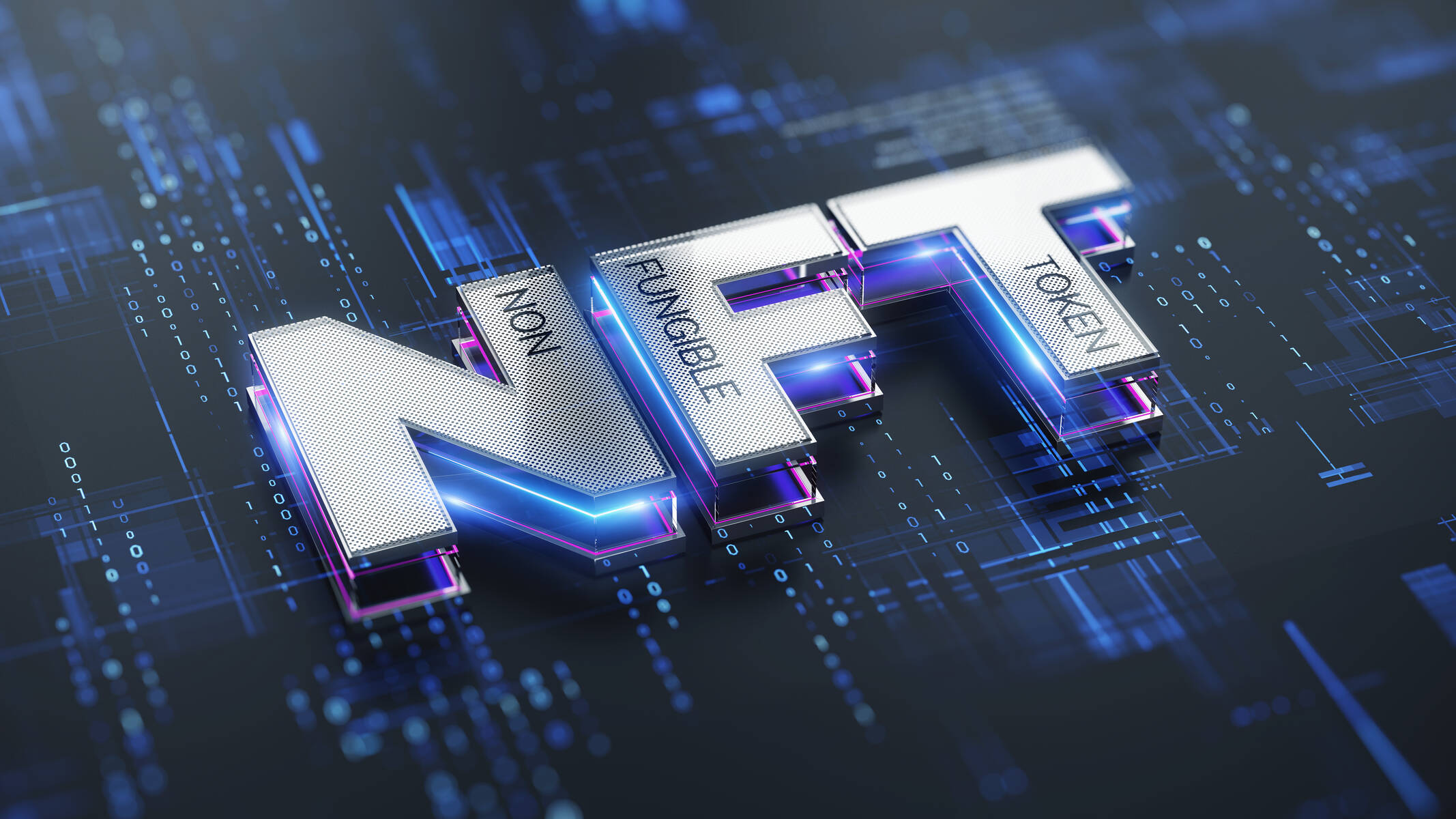
What Is NFT Stock
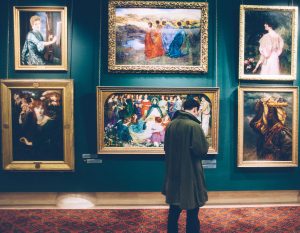
NFT Crypto: What Is It And How to Use It?

How To Do NFT Taxes

What Is NFT Metaverse

How To Make Money On Metaverse
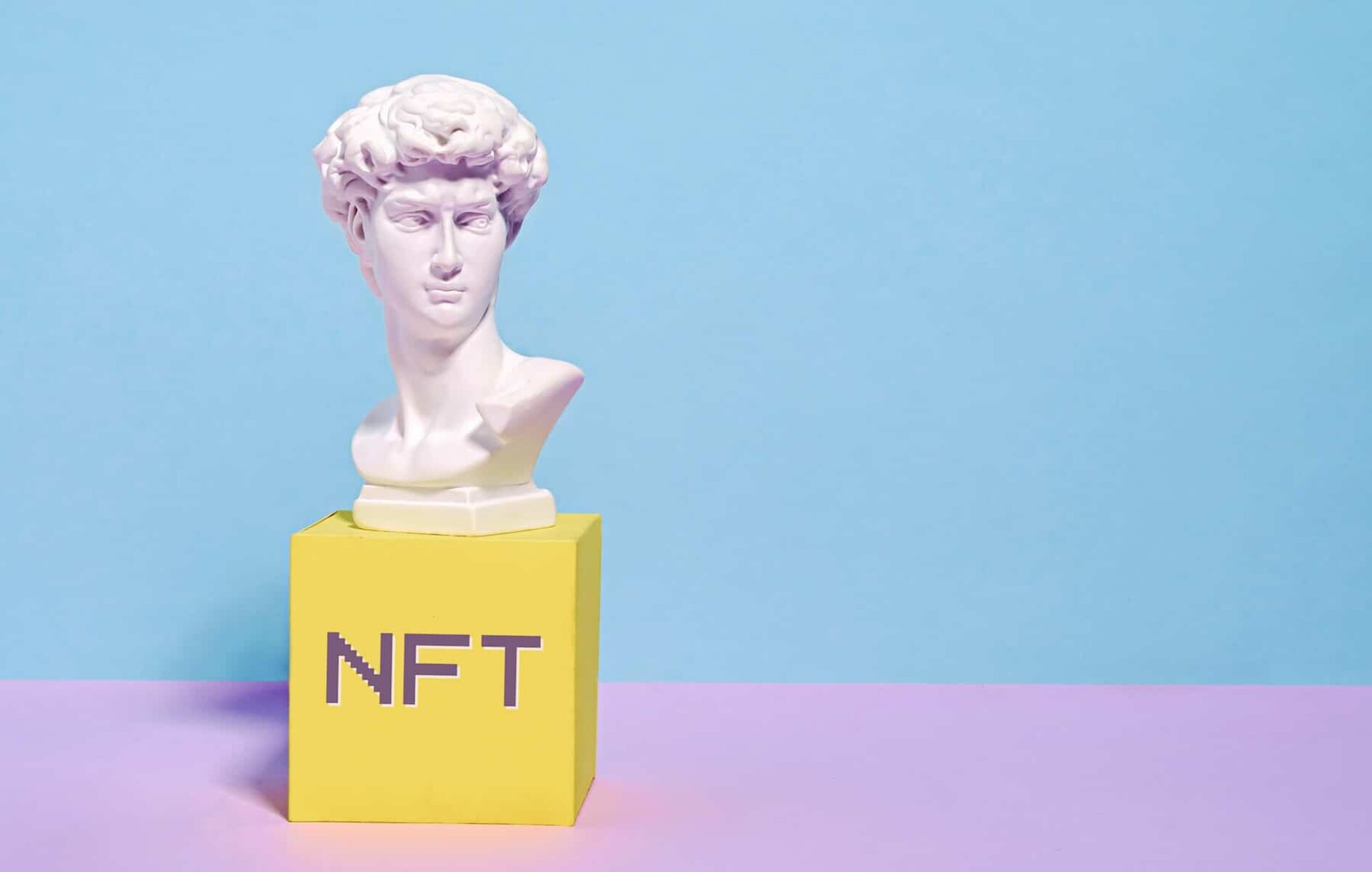
How To Buy NFT Stocks
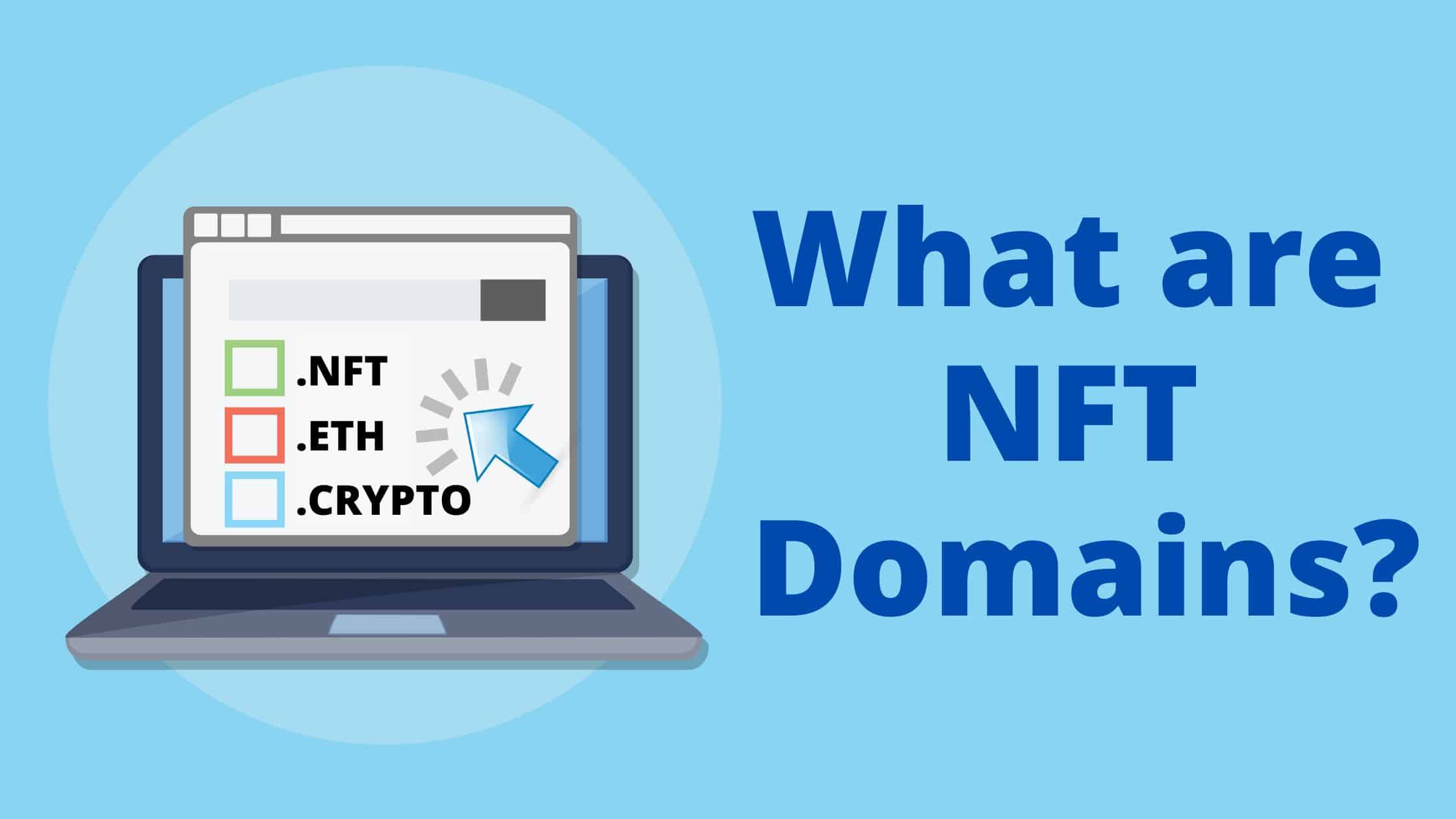
What Is An NFT Domain
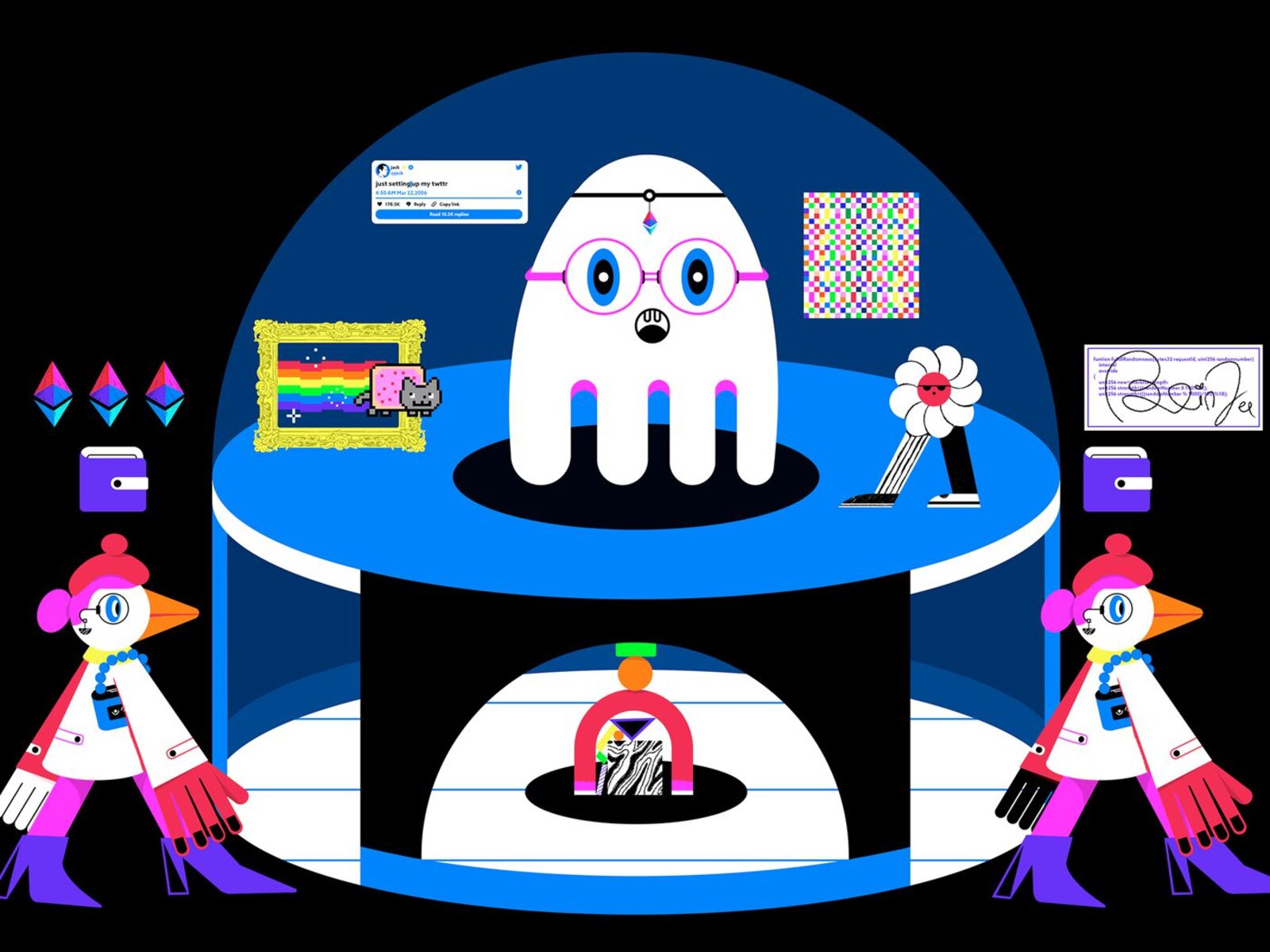
What Is An NFT Salesman
Recent stories.

How to Find the Best Midjourney Alternative in 2024: A Guide to AI Anime Generators

How to Know When it’s the Right Time to Buy Bitcoin

How to Sell Counter-Strike 2 Skins Instantly? A Comprehensive Guide

10 Proven Ways For Online Gamers To Avoid Cyber Attacks And Scams

- Privacy Overview
- Strictly Necessary Cookies
This website uses cookies so that we can provide you with the best user experience possible. Cookie information is stored in your browser and performs functions such as recognising you when you return to our website and helping our team to understand which sections of the website you find most interesting and useful.
Strictly Necessary Cookie should be enabled at all times so that we can save your preferences for cookie settings.
If you disable this cookie, we will not be able to save your preferences. This means that every time you visit this website you will need to enable or disable cookies again.
- SUGGESTED TOPICS
- The Magazine
- Newsletters
- Managing Yourself
- Managing Teams
- Work-life Balance
- The Big Idea
- Data & Visuals
- Reading Lists
- Case Selections
- HBR Learning
- Topic Feeds
- Account Settings
- Email Preferences
How Your Brand Should Use NFTs
- Arun Sundararajan

Wading into a new space always comes with risk — but so does staying out of it.
Suddenly, NFTs are everywhere. For brands, wading into a new space can be daunting, but there’s also risk in not engaging at all. So how should they proceed here? First, recognize that releasing collectables is a good place to start, but it’s also just a first step, like registering a domain name way back in the early days of the internet. Next, look for ways to tie your NFT project to your brand and core product. Finally, experiment, but with authenticity and an eye on the future. There’s little to gain here by trying to mimic what others are doing if it feels obviously out of step.
Non-fungible tokens ( NFTs ) are going mainstream in 2022. You can now show off your favorite NFTs as your Twitter or Reddit profile picture, with Facebook and Instagram soon to follow . Driven in part by a FOMO reminiscent of the 1990s dotcom anxiety of bricks-and-mortar companies, mass-market players and luxury brands alike are launching NFT collections at a dizzying pace.
- Arun Sundararajan is a professor at NYU Stern School of Business who studies how digital technologies transform business and society. Follow him on Twitter @digitalarun
Partner Center

How To Create a NFT Art Marketplace Business Plan: Checklist
By alex ryzhkov, resources on nft art marketplace.
- Financial Model
- Business Plan
- Value Proposition
- One-Page Business Plan
- SWOT Analysis
- Business Model
- Marketing Plan
Welcome to our blog post on how to write a business plan for an NFT art marketplace! The world of art and technology has collided in recent years, giving rise to a new and exciting sector known as NFT art. According to recent statistics, the global NFT market reached a staggering $2.5 billion in sales in the first half of 2021 alone, representing a 1,785% increase compared to the entire year of 2020. With such exponential growth, it's clear that now is the perfect time to enter this industry and create your own NFT art marketplace.
Before diving into the nitty-gritty of creating a business plan, it's essential to conduct thorough market research. Understand the demand for NFT art, the target audience, and the potential competition. By identifying opportunities and gaps in the market, you can position your platform for success.
Defining your target audience is crucial for tailoring your platform's features and services to their needs. Are you targeting traditional art collectors looking to expand their portfolios, or are you catering to a new generation of digital art enthusiasts? Understanding your audience will guide your marketing efforts and help you attract the right artists and collectors.
Identifying potential competitors is another critical step. Research existing NFT marketplaces to understand their strengths, weaknesses, and unique selling propositions. This will help you differentiate your platform and offer something fresh and enticing to artists and collectors.
Speaking of unique selling propositions, determining what sets your NFT art marketplace apart from others is crucial. Whether it's offering a more user-friendly interface, innovative ways to showcase artwork, or strategic partnerships with galleries and museums, highlight these unique features that will make artists and collectors choose your platform over the competition.
Creating a comprehensive business model includes defining your revenue streams, cost structure, and value proposition. Consider the fees you will charge artists for listing and selling their artwork, as well as any additional services you may offer. This detailed plan will guide your decision-making and financial projections.
Outline your marketing and sales strategies to attract artists and collectors to your platform. This may include social media marketing, targeted advertising, partnerships with influencers, or collaborations with established artists. By identifying the most effective marketing channels and tactics, you can build awareness and generate interest in your marketplace.
Developing a financial plan is crucial for understanding the investment required to launch and sustain your NFT art marketplace. Consider operational costs, platform development, marketing expenses, and potential revenue projections. This will help you create a realistic budget and secure the necessary funding.
Don't forget about legal and regulatory requirements. Research the laws and regulations pertaining to NFTs and intellectual property rights in your target market. Ensure compliance to protect artists and collectors while minimizing legal risks for your business.
Last but not least, assess the resources and team needed to bring your NFT art marketplace to life. Determine the skills and expertise required for platform development, marketing, customer support, and legal compliance. Building a capable and diverse team will be instrumental in successfully launching and growing your platform.
In conclusion, writing a business plan for an NFT art marketplace requires careful consideration of market dynamics, target audience, competition, and financial projections. By following these 9 steps , you can create a solid plan that sets your platform up for success in this exciting and rapidly expanding industry.
Conduct Market Research
Market research is a crucial step in creating a successful business plan for an NFT art marketplace. It allows you to gather valuable insights and data about the existing market landscape, understand your target audience's needs and preferences, and identify potential opportunities and challenges.
Here are some key aspects to consider when conducting market research:
- Identify the current demand: Determine the level of interest and demand for NFT art in the market. Analyze market trends, consumer behavior, and the popularity of NFTs among collectors and artists. This will help you gauge the potential growth and sustainability of your NFT art marketplace.
- Study your target audience: Gain a deep understanding of your target audience – artists and collectors. Identify their demographics, preferences, behavior patterns, and motivations. This will help you tailor your platform's features, user experience, and marketing strategies to meet their specific needs and expectations.
- Assess potential competitors: Research existing NFT art marketplaces and platforms. Analyze their strengths, weaknesses, and unique selling propositions. This will enable you to position your marketplace effectively and differentiate it from the competition. Additionally, study the pricing models, transaction fees, and revenue streams of these competitors to inform your own business model.
- Evaluate industry regulations: Understand the legal and regulatory framework surrounding NFTs and digital art. Stay updated on any licensing, copyright, or intellectual property issues that may impact your platform. Complying with these regulations is essential to ensure the legality and credibility of your NFT art marketplace.
Tips for conducting effective market research:
- Use a combination of primary and secondary research methods. Primary research includes surveys, interviews, and focus groups, while secondary research involves analyzing existing data, industry reports, and market studies.
- Engage with artists, collectors, and industry experts to gather valuable insights and feedback. Attend art-related events, join online communities, and participate in forums to build connections and understand the needs of your target audience.
- Stay up to date with the latest industry news, technological advancements, and emerging trends. This will help you anticipate changes in the market and adapt your business strategy accordingly.
By conducting comprehensive market research, you will be equipped with the knowledge and understanding necessary to develop a successful business plan for your NFT art marketplace. It will guide your decisions and strategies, ensuring that your platform effectively caters to the needs and desires of artists and collectors alike.
Define Your Target Audience
Defining your target audience is a crucial step in creating a successful business plan for your NFT art marketplace. Understanding who your ideal customers are will help you tailor your platform, marketing strategies, and overall business approach to meet their specific needs and preferences.
When defining your target audience, consider the following:
- Demographics: Start by identifying the basic demographic information of your target audience, such as age, gender, location, and income level. This data will help you understand who your potential customers are and enable you to create marketing campaigns that resonate with them.
- Interests and preferences: Dive deeper into understanding the interests, preferences, and behaviors of your target audience. Are they art collectors, enthusiasts, or both? Do they prefer traditional art forms or are they more interested in digital art? Knowing their preferences will help you curate your NFT art collection and design your platform to cater to their tastes.
- Needs and pain points: Identify the needs and pain points of your target audience. What challenges do they face when buying or selling art, and how can your NFT marketplace address these issues? By understanding their pain points, you can differentiate your platform and provide unique solutions that will attract and retain customers.
- Conduct surveys and interviews with potential customers to gather insights and validate your assumptions about their needs and preferences.
- Utilize social media platforms and online communities to engage with your target audience and gather feedback on their art buying and selling experiences.
- Consider conducting competitor analysis to identify gaps in the market and understand how your target audience is currently engaging with other NFT art marketplaces.
By clearly defining your target audience, you can shape your NFT art marketplace to cater to their specific needs, preferences, and pain points. This will position your platform as a valuable and relevant solution in the market, increasing your chances of attracting and retaining loyal customers.
Identify Potential Competitors
When starting a business in the NFT art marketplace industry, it is crucial to identify and analyze potential competitors. Understanding the landscape in which your business will operate is essential for developing strategies and positioning your platform effectively. Here are some steps to help you identify potential competitors:
- Conduct thorough market research: Research the NFT art marketplace industry to identify existing platforms that offer similar services or cater to a similar target audience. Look for platforms with a significant user base, established partnerships, and a strong presence in the market. This research will provide insights into their offerings, strengths, and weaknesses.
- Explore online art marketplaces: Look for online art marketplaces that offer traditional art sales as well as NFT art sales. While these platforms may not specialize solely in NFT art, they could still pose competition by attracting artists and collectors away from your platform.
- Consider niche platforms: Identify niche platforms that cater specifically to NFT artists or collectors in a particular art genre. These platforms may have a smaller user base but can still be potential competitors within their niche.
- Analyze their features and user experience: Once you have identified potential competitors, analyze their features, user experience, and overall platform functionality. Look for unique selling points and areas where they may excel or fall short compared to your business idea.
- Assess their pricing and revenue models: Understand how competitors price their services and generate revenue. This will help you determine how to position your platform competitively and develop a pricing strategy that aligns with market trends and customer expectations.
- Join online communities and forums related to NFT art marketplaces to gather insights and learn from the experiences of artists and collectors.
- Stay updated with industry news and announcements to identify new entrants or emerging competitors.
- Consider conducting surveys or interviews with artists and collectors to understand their preferences and frustrations with existing platforms.
By thoroughly researching and identifying potential competitors, you can gain a comprehensive understanding of the market landscape and make informed decisions about how to position your NFT art marketplace platform effectively.
Determine Your Unique Selling Proposition
Determining your unique selling proposition (USP) is a crucial step in creating a successful NFT art marketplace. Your USP is what sets you apart from your competitors and gives your platform a compelling value proposition for artists and collectors. To determine your USP, consider the following:
- Research the market: Analyze the existing NFT art market and identify any gaps or pain points that your platform can address. This will help you understand the unique value you can offer.
- Identify your target audience's needs: Understand the needs, preferences, and challenges of your target audience – both artists and collectors. This insight will help you tailor your USP to meet their specific requirements.
- Define your platform's key features and functionalities: Highlight the unique features and functionalities that your platform will offer. This could include advanced minting tools, built-in copyright protection, or curation partnerships with renowned galleries.
- Showcase your platform's benefits: Clearly communicate the benefits that artists and collectors can expect from your platform. Emphasize how your platform will provide a seamless user experience, secure transactions, and transparent pricing.
- Emphasize sustainability: If your platform incorporates eco-friendly practices or promotes sustainable art creation, highlight this aspect as a unique selling point. Many artists and collectors are increasingly conscious of their environmental impact.
- Highlight social responsibility: Consider incorporating a social responsibility element into your USP. For example, you could pledge a percentage of platform revenues to support artists in underserved communities or donate to art-related charities.
Tips for Determining Your Unique Selling Proposition:
- Conduct thorough market research to understand the existing competition and identify gaps you can fill.
- Engage with artists and collectors to gain insights into their needs and expectations.
- Focus on the key features and functionalities that differentiate your platform.
- Communicate the benefits and advantages of using your platform clearly and succinctly.
- Consider incorporating sustainability and social responsibility into your USP for added appeal to artists and collectors.
Create A Business Model
Creating a business model is a crucial step in establishing a successful NFT art marketplace. It involves identifying how your platform will generate revenue, outline its cost structure, and define the value proposition it offers to both artists and collectors.
When designing your business model, consider the following key elements:
- Revenue Streams: Determine how your NFT art marketplace will generate income. Will you charge a commission on each sale? Will artists pay a subscription fee to showcase their work? Explore different revenue streams to maximize profitability.
- Cost Structure: Identify the costs associated with running the platform, including development, maintenance, marketing, and operational expenses. This will help you understand your financial obligations and set realistic pricing for your services.
- Value Proposition: Define the unique features and benefits your platform offers to artists and collectors. This could include access to a global audience, secure transactions, easy-to-use minting tools, or curated collections that attract art enthusiasts. Clearly communicate the value your platform provides to attract and retain users.
- Partnerships: Consider forming strategic partnerships with galleries, museums, and established artists to enhance the credibility and reputation of your NFT art marketplace. Collaborating with established entities in the art industry can help attract both artists and collectors to your platform.
- Research existing NFT art marketplaces to understand their business models and identify areas where you can differentiate yourself.
- Stay updated with industry trends and changing market dynamics to ensure your business model remains relevant and competitive.
- Consider offering additional services such as art curation, marketing support, or digital art storage to diversify your revenue streams.
By creating a solid business model, you lay the foundation for a sustainable and profitable NFT art marketplace. A well-defined revenue structure, cost analysis, and clear value proposition will attract both artists and collectors, making your platform a go-to destination for digital art transactions.
Outline Your Marketing And Sales Strategies
Effective marketing and sales strategies are crucial for the success of any business, including an NFT art marketplace. The following steps will help you outline your marketing and sales strategies:
1. Identify your target audience: Conduct thorough market research to understand the demographics, preferences, and behaviors of your potential customers. This will enable you to tailor your marketing messages and sales approach to resonate with your target audience.
2. Build brand awareness: Develop a strong brand identity and communicate it consistently across all marketing channels. Utilize social media platforms, search engine optimization (SEO) techniques, and content marketing to generate buzz and increase visibility for your NFT art marketplace.
3. Foster community engagement: Create an online community that brings together artists, collectors, and enthusiasts. Encourage active participation through forums, discussions, and events. This will not only help in building a loyal customer base but also generate valuable insights and feedback for improving your platform.
4. Leverage influencer marketing: Collaborate with influential figures in the art and technology industries who will endorse and promote your NFT art marketplace. Their endorsement can help establish credibility and attract a wider audience.
5. Implement targeted advertising campaigns: Utilize online advertising platforms, such as Google Ads and social media ads, to target specific segments of your audience. Use compelling visuals and persuasive copy to create a strong appeal for artists and collectors to join your platform.
Tips for effective marketing and sales strategies:
- Regularly evaluate and adjust your marketing and sales strategies based on market trends and customer feedback.
- Collaborate with art influencers and thought leaders to expand your network and reach.
- Explore partnerships with galleries, museums, and art festivals to showcase your platform and attract potential customers.
- Utilize email marketing to nurture leads, provide updates on new artworks, and promote exclusive offers.
Remember, a well-defined marketing and sales strategy will help you attract both artists and collectors to your NFT art marketplace. By continuously refining and adapting your strategies, you can stay competitive in this rapidly evolving industry.
Develop A Financial Plan
Developing a strong financial plan is crucial for the success of your NFT art marketplace. It ensures that your business is financially sustainable and helps you make informed decisions about pricing, revenue streams, and expenses. Here are some important steps to consider:
- Estimate startup costs: Calculate the initial expenses required to launch your NFT art marketplace, including development costs, marketing expenses, legal fees, and any other operational costs.
- Forecast revenue: Conduct market research and analyze the potential demand for NFT art in order to estimate your revenue projections. Consider multiple revenue streams such as transaction fees, listing fees, and partnerships.
- Budget for expenses: Determine your operational costs, including technology infrastructure, staffing, marketing, and ongoing maintenance fees. It's important to allocate sufficient resources to each area to ensure smooth operations.
- Define pricing strategies: Decide on a pricing approach that aligns with the value proposition of your NFT art marketplace. Consider whether you will charge a commission fee on sales or implement a subscription-based model for artists.
- Identify funding sources: Explore different funding options, such as bootstrapping, loans, grants, or angel investors. Each source has its own benefits and considerations, so choose the one that best suits your business needs.
- Track and measure financial performance: Implement a comprehensive system to track your financial data, including revenue, expenses, and profitability. Regularly review and adjust your financial plan based on these metrics to ensure your marketplace remains financially healthy and sustainable.
Tips for Developing Your Financial Plan:
- Consult with a financial advisor or accountant to ensure accuracy and compliance with accounting standards and regulations.
- Consider the potential risks and uncertainties in the NFT art market and include contingency plans in your financial projections.
- Monitor market trends and adapt your financial plan accordingly to stay competitive and maximize profitability.
- Review and update your financial plan regularly as your business evolves and grows.
Define The Legal And Regulatory Requirements
When starting a NFT art marketplace, it's crucial to understand and comply with the legal and regulatory requirements that govern the industry. Failing to do so can result in fines, legal issues, and reputational damage. Here are some important considerations:
- Intellectual Property Rights: Ensure that your platform has a clear policy regarding the ownership and protection of intellectual property rights. Consult with legal experts to draft terms of service that address copyright infringement, licensing agreements, and the rights of both artists and buyers.
- Data Privacy and Security: With the collection and storage of user data, it's essential to comply with data protection regulations, such as the General Data Protection Regulation (GDPR). Implement robust security measures to safeguard sensitive information and provide clear disclosure about how user data will be used and protected.
- Anti-Money Laundering (AML) and Know Your Customer (KYC) Regulations: As a marketplace facilitating transactions, it's important to have mechanisms in place to prevent money laundering and comply with KYC regulations. Implement proper due diligence measures to verify the identities of buyers and sellers and monitor transactions for suspicious activity.
- Consumer Protection: Ensure that your platform adheres to consumer protection laws and guidelines. Clearly communicate the terms of sale, refund policies, and any guarantees or warranties offered to buyers. Address any potential disputes or customer complaints in a fair and transparent manner.
- Consult with legal professionals specializing in intellectual property law, data privacy, and regulatory compliance to ensure you are fully informed and compliant.
- Stay updated on evolving legal and regulatory standards in the NFT and art market industries to proactively adapt your platform and policies.
- Consider obtaining necessary licenses or certifications, such as a virtual currency exchange license or payment processor license, depending on the nature of your platform's operations.
By defining and adhering to the legal and regulatory requirements, you can establish trust and credibility with artists, collectors, and other stakeholders, while also mitigating legal risks and protecting the interests of all parties involved.
Assess The Resources And Team Needed
Assessing the resources and team needed for your NFT art marketplace is crucial for the successful implementation and operation of your business plan. It's essential to have a clear understanding of the resources required and the skills and expertise needed to build and maintain your platform. Here are some important considerations:
- Technical Expertise: Building a robust and user-friendly NFT art marketplace platform requires strong technical expertise. You will need developers who are proficient in blockchain technology, web development, and smart contracts. Consider hiring or partnering with experienced professionals who have a deep understanding of decentralized platforms, secure transactions, and digital asset management.
- Design and User Experience: Your marketplace needs to have an attractive and intuitive design to attract and engage users. Hiring designers who specialize in user experience (UX) and user interface (UI) will ensure that your platform is visually appealing, easy to navigate, and provides a seamless experience for artists and collectors.
- Legal and Compliance: Navigating the legal aspects and regulatory requirements surrounding NFTs and intellectual property rights is essential. You may need to consult with legal experts who have experience in blockchain and digital art to ensure that your platform complies with relevant laws and regulations.
- Marketing and Business Development: To reach a global audience of collectors and enthusiasts, you will need a well-rounded team with marketing and business development expertise. This team will be responsible for implementing strategies to promote your platform, attract artists, and build partnerships with galleries, museums, and other key players in the art industry.
- Operations and Customer Support: Running an NFT art marketplace requires efficient operations and excellent customer support. Having a dedicated operations team to manage transactions, resolve technical issues, and provide timely customer support will be crucial in establishing trust and loyalty among your users.
- Consider conducting a skills gap analysis to identify any areas where you may need to hire or partner with external experts.
- Build a diverse and inclusive team that can bring different perspectives and expertise to your marketplace.
- Develop a clear team structure and define roles and responsibilities to ensure efficient collaboration and accountability.
By assessing the resources and team needed for your NFT art marketplace, you can ensure that you have the necessary expertise and capabilities to bring your business idea to life. Assemble a talented and dedicated team that can support your vision and drive the success of your platform.
In conclusion, creating a successful NFT art marketplace requires careful planning and consideration of various factors. By following the nine steps outlined in this checklist, you can develop a comprehensive business plan that will pave the way for a thriving platform. From conducting market research to assessing the necessary resources and team, each step plays a crucial role in the success of your venture. With a user-friendly interface, strategic partnerships, and a focus on sustainability, your NFT art marketplace has the potential to revolutionize the digital art industry and provide artists with a platform to showcase and monetize their unique creations.

$169.00 $99.00 Get Template
Related Blogs
- Starting a Business
- KPI Metrics
- Running Expenses
- Startup Costs
- Pitch Deck Example
- Increasing Profitability
- Sales Strategy
- Rising Capital
- Valuing a Business
- How Much Makes
- Sell a Business
- Business Idea
- How To Avoid Mistakes
Leave a comment
Your email address will not be published. Required fields are marked *
Please note, comments must be approved before they are published
The Pourquoi Pas
Tech made Easy
- Adrien Book
- Oct 16, 2022
How to create an NFT business plan
Over the past year , interest in Non-Fungible Tokens has plunged . Many on Twitter argue this is a good thing; that the concept was a scam all along . Others claim that the technology remains revolutionary and will one day be the biggest thing in the world . They blame external factors and bad actors for the current market depression.
I care little for either side; they’re probably both right, as is often the case. At the end of the day, NFTs exist, and they don’t seem to be disappearing. The technology was first adopted by web3 companies , who never really seemed to be able to differentiate business from scams . It was then over-taken by large multi-national companies, who are by their nature dull and unimaginative .
The shine having seemingly worn off, now is the right time to have a serious, honest discussion about how to view and use NFTs within your business. But first…
1. Do YOU need an NFT strategy?
Despite what some parts of the “industry” says, not everyone needs to have an NFT strategy. This is not an industrial revolution or a “new internet”. Before jumping in, it’s important to ask the following :
Does your brand have recognizable assets that could be turned into NFTs, such as a trademark character, notable branding, luxury products…?
Does your brand have an engaged community who identify as fans of your brand, products or services?
Do you want these people to have a stronger voice and a bigger role within your organisation?
Can you tie an NFT to real-life perks such as exclusive events, discounts, or early access to products?
Do you have the bandwidth and freedom to test out an innovative but unproven marketing channel?
If the answer to all of these questions is no… go outside, build something real, make a name for yourself and then start thinking about NFTs . Chances are, at that point, you won’t need them anymore.
A lot of entrepreneurs have made two mistakes over the past two years. First, they tried to assert that NFTs have self-sustaining value. They do not: digital assets are inherently contextual. Secondly, and more importantly… by their very nature, most centralized companies do not NEED to use NFTs . If I need to explain why, you shouldn’t be messing with cryptography.
2. Defining NFTs’ Value proposition

You don’t create digital tokens purely to make money. You create tokens because they add value to existing and/or potential customers. Which in turn give you money. Here’s how organizations and creators can use NFTs to leverage existing content and interact with their customers.
Develop new offerings
Due to the digital nature of NFTs, the line between different types of offerings is blurred. This is a sign of the times.
New products : Earlier this year, GAP launched “hoodie art” as an NFT , which unlocks physical clothing.
New services : Plenty of companies are betting on future metaverse users wanting to glam-up their digital avatars with wearable NFTs designed by luxury houses like Louis Vuitton, Valentino and Burberry .
New partnerships : Nike created CryptoKicks in partnership with RTFKT studios . The sneakers have sold for over $5K.
These examples show the incredibly dull way traditional actors see the world… We shouldn’t let them gain more power in this space. There are so m+any cooler things you can do with NFTs.
Create new forms of value
The concept of potential new value is fascinating, as the below can be mixed and matched as needed. There are a lot of innovative ways to interact with customers there.
Exclusivity : Many people in the recent past purchased NFTs simply to show people online how cool they are and how much money they have . Exclusivity has long driven luxury sales; NFTs are no different. The internet has been a great equalizer for decades, but this may be coming to an end, for better or for worse (probably the latter).
Social capital : Exclusivity is often shared by and with people of similar socio-economic backgrounds. This creates social capital. NFTs can be used to bring like-minded people together, in online communities, coordinated around a token. As an example, the most well-known social DAO, “ Friends with Benefits ”, gives access to NFT-related events in exchange for thousands of dollars . Do with that information what you will.
Community : Social capital and its own form of exclusivity naturally leads to the creation of communities. Lazy Lions , Bored Apes Yacht Club , Wall St Bulls … every NFT collection has its own group of fans and followers. In these communities, NFTs have two functions beyond mere financial incentives. Primarily, they act as artifacts of networks , which reinforce the community’s value by being the one thing everyone has in common. They can also represent voting shares in the community, whether officially or unofficially.
Access : By their very nature, NFTs are unique and cannot be broken down. As such, their unique code can work as a key to grant access to a community, to a real-world event, to a concert, to a sale… Mixed with the other forms of value mentioned here, this can be quite powerful.
Authenticity : Since tokens are unique, they can also be used as authenticate products they may be linked to (ex : YSL sends an NFT to your digital wallet when it sells you a bag). For industries suffering from plagues of fakes, this opens many possibilities. Not to mention the many use cases around identity.
Utility: A utility NFT isn’t just a piece of code or a pretty picture. It can also serve a real purpose online. The easiest example to grasp is equipment for video-games that give players new and unique attributes. Another, more advanced example is the utility garnered from an NFT that also acts as a voting token within a DAO. In the future, we can think of utility with regards to national identification, but we are far from it today.
Rewards : the blockchain being transparent, it’s easy for brands to identify who may own a specific number or combination of NFTs , and reward these people through a promotion or a unique gift, thus increasing brand loyalty.
Investment : with all the above in mind, one might think it wise to buy specific NFTs early, and keep them as they accrue the value highlighted. This is why many people bought NFTs over the past year. That was a mistake. But who’s to say, as the market matures, if it will continue to be? A company might get a head start by believably implying future value exists.
Entertainment : At the end of the day, why can’t I just like a silly picture and enjoy owning it as a piece of a company's history, or as the totem of a community? What’s so wrong with that? For all its glory, the digital world has always lacked biographical indexicality — a way of seeing the full history of a digital asset. And history has value, if only in the eyes of its beholder. As such, NFTs create hedonic value: owning one creates pleasure for its own sake. Companies can do well to understand that.
None of the above is mutually exclusive. This is not to say that your NFTs need to do it all — this is a mistake we see too often.
Improve customer relationship
All of the above ensures customers are :
More Engaged : Customers that are part of an exclusive community, from which they derive value, will work to improve that community. Companies dream of having active promoters : NFTs are a way to get there.
More Aware : an NFT collection, if done well, has a tendency to be self-propagating. This means more free advertising to potential customers. However, that awareness is meaningless if there are no benefits to entering a relationship with the NFT issuer.
More Loyal : If a customer is engaged, and gets regular rewards, and those rewards improve as he becomes more entangled with the NFTs’ issuer, why would he switch to a different service provider? NFTs are a path to unprecedented customer stickiness.
Drive long-term value
If everything goes well, NFTs are a path to :
Customer retention : a relationship having an exponential value, customer stickiness is increased.
Customer acquisition : Said value lowers the net cost of customer acquisition.
Data & Insights : having a more digital relationship on a transparent blockchain allows companies to have access to more data, which they can then use to improve their offer. Ethically, of course .
New revenue : this should not necessarily be the end goal, as mentioned above. But it can be a VERY nice cherry on the cake.
3. Going deeper : building an NFT business model canvas
I’ve long bemoaned the way the business model canvas is taught in business schools . Too rigid, no interconnections, no focus on ecosystems…So I don’t use it. What I’ve created instead are a set of questions that one might instead ask as they build a case to bring NFTs to the attention of a boss or partner. You’re welcome.
Who are the consumers of our company’s digital assets?
How are these consumers different from other types of customers — if at all?
What are their current purchasing motivations? What do they value? What do they look for as customers of our brand?
What kind of digital assets do they want to buy today? In the future?
Business case
What is the potential contribution of digital asset sales to our company’s top and bottom lines?
Will digital asset sales be additive? Or will they cannibalise some physical sales?
What investments are required today? Over the long term?
Go-to-Market
To what extent should our brand mint its digital assets as NFTs and / or pair physical assets with an NFT?
How can our brand reduce the environmental footprint of NFT mints?
Should we translate our digital assets to the virtual realm or create entirely new assets?
How can a brand authentically activate digital or digital/physical product pairings?

Brand Experience
Which elements of brand identity can and cannot be easily communicated in a virtual world?
How can our company authentically build community in a virtual environment? Is that an objective in itself?
How can our brand and sale platforms convert those communities to engage in the real world — if at all?
Partnerships
What kinds of partners would be a suitable match given our objectives, positioning and values?
What do these potential partners bring to the table (consumer access, digital credibility, technology, long-term vision...)?
If we don’t go through a partner, what proportion of our workforce is skilled in 3D modelling, rendering, blockchain technology...?
If the proportion is small, can we feasibly train our existing workforce or will we need to acquire new talent?
If this is more than a marketing gimmick ( it usually is ), how do we adapt our culture and structure to be nimble in a fast-evolving space?
Should we launch and operate NFTs within a siloed team or across the organisation?
These questions are in no way exhaustive, but they should put you on the right path. You’ll need to be on it, because planning is the easy part. Execution is where it gets hard… and fun.
4. Launch, run & coordination
Beyond the big plans and fancy marketing announcements, real work is needed for any project, whether on the blockchain or not. Below is a list of things to work on to ensure a sound NFT strategy and vision, as well as a successful implementation and roll-out.
Strategy & innovation
Define long-term strategy based on value opportunities ( continuous POCs are not a strategy! )
Continuously monitor market movements and trends ( it’s better to be a mediocre surfer on a big wave than a great surfer in a bathtub )
Identify what will be accepted / rejected by customers through rapid prototyping and regular improvements
Identify internal strategic focus areas, and link up with them ( see bathtub comment )
Ensure NFT-related activities align with brand guidelines
Test out target audience, markets, products
Develop communities (One? Many?) through meaningful projects
Manage campaigns alongside roll-outs of other offers
Collect new data points to improve marketing
Business Units
Manage NFT product management roadmaps
Build business cases and work through the high business value ones
Document priority features for customers
Work with creative teams / developers on creating assets
Leverage existing IP / create new digital IP
Understand blockchain risks and trade-offs versus other technologies
Select a tool stack according to company requirements
Integrate new tools into existing systems ( oh the humanity )
Define and prepare long-term customer support
Build services to support the custody of NFTs
Handle crypto payments and reconciliations ( lol good luck )
Understand financial impacts of NFT sales on the organisation
Manage royalty payments / collections
Manage associated taxes with NFT mint / exchange
Advise what local / global regulations allow (now and in the future)
Review all smart contracts, rights and obligations
Advise what types of rights are acceptable
Enforce copyrights, trademarks and patents
Work with Finance & Treasury teams on tax implications
5. Planning for risks
The world of NFTs is new and exciting. Just like the new girl in high school. And just like the new girl in high school, NFTs are dangerous. Damn it Jessica, my leg still hurts when it rains . Though NFTs can create a significant amount of value, they can also be net value-destroyers if risks are ignored.
For the brand
NFTs offer new mechanisms to present a brand and engage with consumers. Accordingly, they can hurt a company’s image, reputation, and legacy if done improperly. NFT offerings should be executed with the same level of rigor that a new product launch entails; quick cash grabs may damage consumer trust in the long term.
For instance, proof-of-work solutions to validate NFTs’ authenticity require significant energy cost. Brands looking to be perceived as ‘ green ’ should consider this in their blockchain selection process.
Scams, Hacks, Fraud and Theft
NFTs offer authentication, provenance, and title to ensure the proper rights management of assets. But fraud is common in this market — counterfeits have always existed, and always will. Fraudsters may mint an NFT relating to a work that is not their own and without the creator’s permission. Additionally, various hacking schemes exist to steal NFTs from their rightful owners. Not to speak of social engineering scams, or outright cyber-attacks.
These risks can be mitigated by purchasing NFTs from reputable creators, undertaking the proper due diligence of an asset’s provenance on a secondary market, and storing assets in secure wallets. This will probably never be enough, and strong contingency plans also need to be in place.
Ownership rights / rights transfer
The purchaser of an NFT owns the token. But owning an NFT does not equate to owning the underlying IP itself . Often these rights remain with the creator of the NFT. In order to preserve these rights and maintain transparency, legal contracts need to be constructed in the real world. These conditions would also need to be carried over to secondary markets and rights transfers.
Technology, however, is as much an art as it is a science. If the contracts are forever airtight, future innovation may be stifled. It is sometimes better to become a meme and be paid for it in free marketing than to sue a pre-school for IP “theft” .
Technological risk
Any NFTs released on a permissionless chain are subject to the technology risks posed by that chain. If a network goes down, ( *cough* Solana *cough* ), your NFT assets may be at best useless, and at worse the source of lawsuits. Yet, centralized chains can be at risk of hacking as well.
There is no right answer, only a thin line on which we must walk the best we can.
Regulatory risks
NFTs are a relatively new asset class. As such, much of the legal and regulatory framework surrounding them is still under development. This should not stop organizations looking to offer NFTs from enforcing existing regulations through KYC, AML, CFT tools.
Regulatory considerations around how NFTs could be regulated in the future (i.e., as a security) will soon present additional challenges. Best be as ready as possible today.
Loss or Damage
An NFT can occasionally be tied to an underlying asset or access to a physical experience. However, the NFT and the underlying asset it represents are separate. While the NFT will contain information about its link to the underlying asset and its holder, should the underlying asset be destroyed, lost, stolen, or the event halted, the NFT itself could be rendered worthless. It is important to have contingency plans in place for such an event
This article highlights but a speck of the efforts necessary to bring a new technology to the mainstream of an organization not specifically built around it. And, as I mention throughout, all these efforts may be for naught — the technology needs to improve, the laws need to catch up… and a new vision of “ value ” needs to emerge. I have nothing but respect for whoever earnestly wishes to hold the NFT banner within a non-web3 company.
Good luck out there.
Related Posts
Why NFTs are dumb (in as few words as possible)
5 Reasons why NFTs are not as stupid as they seem
Here's how NFT Platforms will Transform the Wine Industry
You may also like :

24 Tech predictions for 2024

Write a Children's Book in 10 Minutes with AI

The Big Picture: Macro-Trends That Will Shape the Next 10 Years

6 Problems with the Business Model Canvas

Tech's "Next Big Thing" : 20 Technologies that will change your life by 2050
Thanks for subscribing!
Get the Insights that matter
Subscribe to get the latest on AI , innovative business models , corporate strategy , retail trends , and more.
No spam. Ever.
Let's get to know each other better
What Is an NFT — And How Can It Help You Build Deeper Customer Relationships?
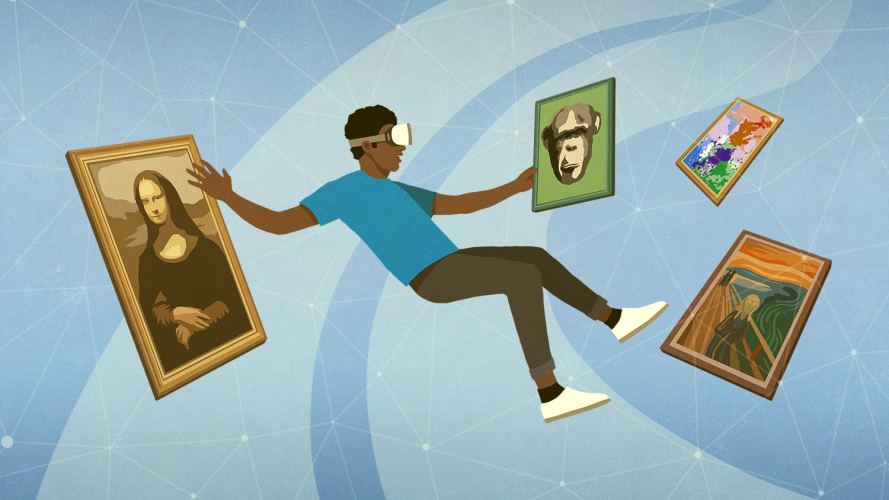
As Web3 continues to bubble up, businesses may wonder how to get involved — or if they should at all. Here’s a primer.

Ari Bendersky
Share article.
- Link Copied
When an artist named Beeple sold a piece of digital art for $69 million in 2021 through a Christie’s auction, it raised eyebrows — mostly because it was an NFT. At the time, most people had never heard of this acronym. But in the last year cryptocurrencies , such as Bitcoin and Ethereum, continued to attract investors and more people embraced the decentralized ecosystem of Web3 , the blockchain , and the metaverse — pushing this whole virtual world more into the mainstream. You may still wonder: What is an NFT and how can it help my business ?
NFTs, or non-fungible tokens, come in many forms, but most people associate them with art or music. Brands like Adidas, Coca-Cola, and the NBA have offered these digital tokens as collectibles or keys to unlock events or exclusive promotions. While more businesses embrace NFTs, should you enter this new Web3 world? Here, we offer a primer to help make sense of NFTs and how they can benefit businesses.
What is an NFT?
First of all: fungible? Something that is fungible can be swapped or replaced with something identical. Something that is non-fungible is unique and can’t be replaced with anything else.
In the physical world, examples of fungible items are a dollar bill, a spiral notebook, or a gallon of milk. On the other hand, a Banksy painting is non-fungible since there’s only one. In the Web3 world, a bitcoin is fungible and can get replaced with another bitcoin.
NFTs, however, are digital tokens that represent digital files, such as photos, videos, and music, which could represent traditionally physical goods such as concert tickets or sneakers. They are created and stored on the blockchain (a digital ledger) to represent something distinctive or scarce.
You may also wonder about the difference between Web1, Web2, and Web3. In its most basic sense, Web1 allowed people to access and read information on websites, like Yahoo. In Web2, blogs, wikis, and social media like Twitter and YouTube got introduced, giving people more control over the information they created and shared. In Web3, the decentralized world puts ownership into the hands of the community.
Wow your customers wherever they are
With Salesforce Web3, customers can create deeper loyalty with their customers with a trusted, connected platform.

What can NFTs do for your business?
Products are no longer sold just in the physical world. A new generation of buyers is splitting its time between the physical, digital, and virtual worlds — and brands need to meet their buyers where they are. NFTs open doors to new markets, experiences, revenue streams, and brand relationships — giving brands the opportunity to increase revenue and open lines for community feedback.
You’ll continue to sell products in the physical world and on websites like Amazon or Target (Web1) and promote them on social media (Web2), but you can also sell NFTs in new digital-first marketplaces like the metaverse (Web3), likely in your own branded store. People can buy or earn NFTs to hold in a digital wallet or to sell or trade. Ultimately, it’s about deepening the brand-consumer relationship and building on loyalty and rewards programs.
NFTs also further your digital transformation and can create new revenue streams. For example, NFTs contain smart contracts that govern their use and can be set to execute at a certain point. A smart contract can dictate how long the asset must be held before it can be sold, how much it can be sold for, and what royalty the original creator retains on each sale. As a business, you can earn revenue, in perpetuity via a royalty, through a smart contract. Consumers can even “ rent ” your NFT to use in games and other activities. If they win and earn money, you split the earnings. The revenue streams at this point are plentiful and will continue to grow.
How are some brands using NFTs?
This all may sound confusing or overwhelming, so let’s talk about what some well-known brands are already doing in this space:
- Luxury fashion house Gucci created brand awareness by selling $12 digital sneakers to be “worn” in augmented reality (AR) like in the online gaming platform Roblox.
- Brewer Stella Artois offered 50 NFT horses that will race on a digital racetrack.
- Car manufacturer Alfa Romeo equipped its new SUV with an NFT that will track vehicle data to show proper maintenance over time.
- Coachella, the annual California music festival, launched an NFT marketplace where people bid on NFTs to unlock lifetime passes, unique on-site experiences, and physical and digital art.
What drives success with NFTs in the Web3 world?
Does entering this world and creating NFTs actually make sense for you? Do you have a community that wants what you’re offering? While you’ll continue to operate mostly in a Web2 environment for the foreseeable future, Web3 is decentralized, meaning the community works together and collaborates. It’s about co-creation and co-ownership.
Community drives success in this world. A brand first should identify a community to collaborate with on how to enter the market, otherwise it may get ignored and fail. This has already happened with a number of celebrity-crafted NFTs . So work with a community to help you create whatever it is you’re creating. Community will always be your best defense in Web3. This leads us to the next step: What utility does your NFT provide?
Many NFTs offer some sort of utility and have intrinsic value, whether monetary, access, perks, voting rights, and more. And they can be another revenue stream for businesses. For example, you can:
- Collaborate with artists or musicians to create NFT art.
- Use NFTs as special offers or keys to gain access.
- Mint digital assets people can display like a badge of honor.
- Create a real-life product extension like Louis Vuitton’s seal of authenticity .
- Offer legal ownership of intellectual property.
- Allow people to rent out NFTs for revenue.
How can you get started with NFTs?
So how do you get started and enter this new world? You can approach this in one of three ways:
- Low effort with little to no investment : If your company uses Slack , set up an internal channel for employees who demonstrate a passion for NFTs, crypto, blockchain, and more to discuss ideas and help you get set up or host virtual listening sessions.
- Medium effort with some investment : Start accepting crypto as payment for your goods and services. If you have a log-in to your website, allow people to log in with their digital wallet instead of a password. Or you can simply buy an NFT and hold on to it while also joining those communities and showing your commitment to Web3.
- High effort with significant investment : This is where you go all-in on NFTs and Web3. You can create an NFT project and work with an external community to build a roadmap to enter the market, where you sell NFTs on your branded marketplace.
This world is moving fast and changing even faster. Yes, there’s a lot to understand and learn, so take the time to do your research. NFTs won’t fit with every company, business, or organization. Do what makes the most sense for your company, customers and community. And then get ready to go down the NFT rabbit hole. It’s deep.
Get a 360° view of success
Vantage Point magazine brings together thoughtfully curated voices from the world’s most influential companies. Each issue unpacks intimate insights shaping the workplace.
Just For You
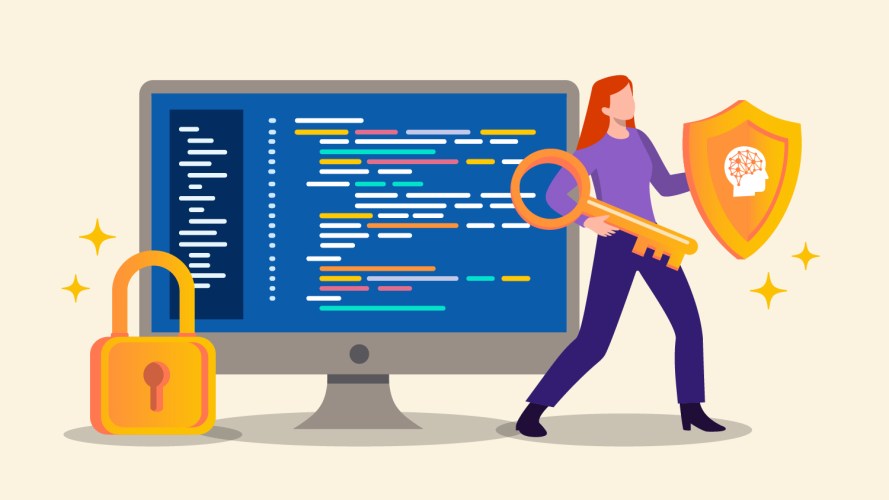
Your Data is Everything — Protect it With Digital Sovereignty Standards

What Is a Customer Satisfaction Survey? Importance, Types, and Tips

Explore related content by topic
- Customer Relationships
- Digital Transformation
- Financial Services

Ari Bendersky is a Chicago-based lifestyle journalist who has contributed to a number of leading publications including the New York Times, The Wall Street Journal magazine, Men's Journal, RollingStone.com and many more. He has written for brands as wide-ranging as Ace Hardware to Grassroots Cannabis and is a lead contributor to the Salesforce 360 Blog. He is also the co-host of the Overserved podcast, featuring long-form conversations with food and beverage personalities.
Get the latest articles in your inbox.

What Is a Serviceblazer? Here’s What Community Members Told Us

Customer Pain Points: How to Identify and Address Them

What Does Salesforce Do?

Everything You Need to Know About AI in Customer Service
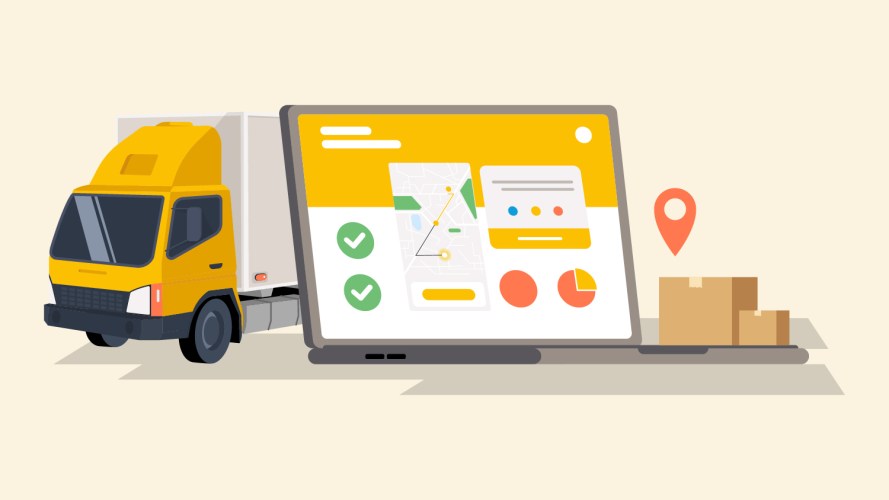
What Is Order Management — And Why Should You Care?

What’s Your Customer Effort Score? Here’s How To Measure It — and Why

Customer Relationships Are Frayed — Can Generative AI Mend Them?

Want Happy Customers? Start With the Right Case Management System

360 Highlights
Yes, I would like to receive the Salesforce 360 Highlights newsletter as well as marketing emails regarding Salesforce products, services, and events. I can unsubscribe at any time.
By registering, you confirm that you agree to the processing of your personal data by Salesforce as described in the Privacy Statement .

Thanks, you're subscribed!

New to Salesforce?
- What is Salesforce?
- Best CRM software
- Explore all products
- What is cloud computing
- Customer success
- Product pricing
About Salesforce
- Salesforce.org
- Sustainability
Popular Links
- Salesforce Mobile
- AppExchange
- CRM software
- Salesforce LIVE
- Salesforce for startups
- América Latina (Español)
- Brasil (Português)
- Canada (English)
- Canada (Français)
- United States (English)
Europe, Middle East, and Africa
- España (Español)
- Deutschland (Deutsch)
- France (Français)
- Italia (Italiano)
- Nederland (Nederlands)
- Sverige (Svenska)
- United Kingdom (English)
- All other countries (English)
Asia Pacific
- Australia (English)
- India (English)
- Malaysia (English)
- ประเทศไทย (ไทย)
© Copyright 2024 Salesforce, Inc. All rights reserved. Various trademarks held by their respective owners. Salesforce, Inc. Salesforce Tower, 415 Mission Street, 3rd Floor, San Francisco, CA 94105, United States
NFT Marketing Plan Template: What You Need to Know

An NFT marketing plan template is essential for successfully promoting and selling your non-fungible tokens in the competitive digital marketplace.
Table of Contents
By creating a comprehensive strategy that encompasses audience targeting, content creation, and performance tracking while collaborating with influencers, you can effectively navigate the complex world of NFT marketing.
Implementing an adaptable NFT marketing plan template ensures you stay ahead of trends and capitalize on opportunities in this rapidly evolving space.
Understanding the Basics: An Introduction to NFT Marketing Plan Templates
Non-fungible tokens (NFTs) have taken the digital art and collectibles world by storm. This offers an innovative approach for artists to generate income from their creations and for collectors to invest in digital assets . To make the most of this growing market, it’s crucial to have a solid NFT marketing plan in place. This is where an NFT marketing plan template comes into play.
An NFT marketing plan template is a pre-designed, customizable document or framework that helps creators outline their marketing strategies for promoting and selling their NFTs. It provides a structured approach to organizing promotional efforts, from identifying target audiences and setting goals to developing content strategies and tracking performance.
The template serves as a guide, ensuring that all essential elements of a successful NFT marketing plan are considered and executed effectively.
The first step in utilizing an NFT marketing plan template is understanding the target market, preferences, and behaviors. This information will inform the development of tailor-made marketing strategies and content that resonates with potential buyers.
Setting clear and measurable objectives is another crucial NFT marketing plan template aspect. These objectives should be specific, achievable, and time-bound while providing a roadmap for success and a means to evaluate progress.
Content creation and platform strategies are essential to an NFT marketing plan template. Diversifying content across various platforms and formats, such as social media, blogs, and videos, will help engage potential buyers and build a sense of community around your NFTs.
Finally, the template should include a system for tracking performance metrics and analyzing results. This data-driven approach allows for continuous improvement and adaptation while ensuring your NFT marketing efforts remain effective in the rapidly evolving digital assets landscape.
By understanding the basics of an NFT marketing plan template, you’ll be better equipped to promote and sell your unique digital creations in the competitive NFT market.
Setting Clear Objectives: Defining Success in Your NFT Marketing Plan Template
In the fast-paced and competitive world of non-fungible tokens (NFTs), having a well-defined marketing strategy is crucial for success. One of the most critical aspects of creating an effective NFT marketing plan is setting clear objectives.
These objectives not only help you stay focused on your goals but also allow you to measure progress and make data-driven decisions. Here are some NFT marketing tips to help you set and achieve your objectives in your NFT marketing plan template.
- Be Specific: When setting objectives, ensure they are clear and concise. Instead of aiming for vague goals like “increase sales,” specify the desired number of NFTs you’d like to sell or the revenue you aim to generate within a given timeframe.
- Make Them Measurable: To track progress, your objectives should be quantifiable. This means including specific metrics, such as website traffic, social media engagement, or sales conversions, that can be monitored and measured over time.
- Ensure Achievability: While setting ambitious goals is essential, they must also be realistic and attainable. Consider your resources, time constraints, and current market conditions when defining your objectives.
- Focus on Relevance: Your objectives should closely align with your business goals and target market. Identify the key challenges and opportunities within the NFT space relevant to your niche and tailor your objectives accordingly.
- Set Timeframes: Establish a clear timeline for achieving your objectives, whether short-term, medium-term, or long-term. This fosters a sense of immediacy and keeps your marketing efforts on track.
By incorporating these NFT marketing tips into your plan template, you’ll be better equipped to define success, measure progress, and adapt your strategies. Clear objectives are the foundation of any effective marketing plan, and by setting them wisely, you’ll increase your chances of success in the ever-evolving world of NFTs.

Constructing a Robust Brand Image: The Significance of Consistency in Your NFT Marketing Plan Template
A strong brand identity is essential for marketing NFT projects effectively standing out in the competitive landscape of non-fungible tokens. Your brand identity should reflect the unique qualities and values of your NFT project and resonate with your target audience.
Consistency in your NFT marketing plan template is vital in establishing and maintaining a cohesive brand identity that fosters trust, recognition, and loyalty among potential buyers.
Achieving Cohesive Visual Identity
One of the essential elements in constructing a consistent brand identity is ensuring that your visual elements, such as logo, color palette, and typography, are harmonious across all marketing channels. Whether it’s your website, social media accounts, or promotional materials, maintaining a cohesive visual identity helps create a professional and memorable impression.
Crafting Consistent Messaging and Tone
In addition to visual elements, your messaging and tone should be consistent in your NFT marketing efforts. Your communication should reflect your brand’s unique voice and values while engaging your target audience and building an emotional connection. This can be achieved by sharing compelling stories and highlighting the creative process behind your NFT project, while showcasing the benefits and features of your digital assets.
Strategic Influencer Partnerships
Collaborating with influencers and partners who share your brand values can further reinforce your brand identity and broaden your influence within the NFT community. Carefully selecting these collaborators ensures that your marketing efforts are aligned with your brand ‘s overall vision and goals.
Continual Improvement
Finally, regularly reviewing and refining your NFT marketing plan template is crucial for maintaining a consistent brand identity in the ever-evolving NFT market. By monitoring your performance metrics and gathering feedback from your audience, you can identify areas for improvement and adjust your strategies accordingly.
Consistency in your NFT marketing plan template is vital for building a solid brand identity that sets your project apart from the competition. By paying close attention to visual elements, messaging, and strategic partnerships, you can create a cohesive and engaging brand experience that attracts and retains potential buyers in the dynamic world of NFTs.
Content and Platform Strategies: Optimizing Your NFT Marketing Plan Template for Maximum Reach
An effective NFT marketing strategy to maximize reach and engage potential buyers in the ever-evolving world of non-fungible tokens. By creating a diverse range of content and utilizing various platforms, you can increase the visibility of your NFT project and appeal to a broader audience.
Crafting a Diverse Content Plan
The first step in optimizing your NFT marketing strategy template is to develop a content plan showcasing your digital assets’ unique features and value. This plan should include a mix of content formats, including blog articles, videos, social media content, and email newsletters. By diversifying your content, you can cater to different audience preferences and maximize engagement.
Selecting the Right Platforms
In addition to content variety, your NFT marketing strategy template should also consider the platforms where your target audience is most active. Research popular platforms within the NFT community, such as Discord, Twitter, and Instagram, and tailor your content to each channel’s unique features and demographics. Participating in online forums, engaging with potential buyers, and joining NFT-related groups can also help you establish a strong presence within the community.
Harnessing Influencer Power
Another crucial aspect of your NFT marketing strategy template is to leverage the power of influencers and strategic partnerships. By collaborating with prominent figures in the NFT space who share your brand values, you can expand your reach, generate buzz, and increase credibility.
Performance Monitoring and Analysis
Lastly, regularly monitor and analyze your performance metrics to assess the effectiveness of your content and platform strategies . This will enable you to pinpoint areas for enhancement and adjust your NFT marketing strategy template to ensure optimal reach and engagement.
A well-rounded content and platform strategy is essential for maximizing the potential of your NFT marketing efforts. Creating diverse content, targeting the right platforms, and continuously refining your approach can optimize your NFT marketing strategy template for success in the dynamic digital asset landscape.

Community Engagement: Fostering Relationships through Your NFT Marketing Plan Template
Community engagement is a critical component of any successful marketing plan, and when marketing an NFT collection, it becomes even more essential. By fostering relationships and nurturing a sense of community around your NFT collection, you can create an environment that encourages user interaction, loyalty, and sales. A well-crafted NFT marketing plan template should prioritize community engagement and incorporate strategies to connect with your audience more deeply.
Active Participation
One of the critical aspects of community engagement is active participation on social media platforms and online forums where your target audience is present. Regularly posting relevant content, responding to comments, and addressing questions show that you value your community’s opinions and feedback. This helps build trust and encourages members to share their experiences and recommend your NFT collection to others.
Events and Webinars
Hosting events and webinars related to your NFT collection can also foster community engagement. These events can provide insights into the creative process, offer sneak peeks of upcoming releases, or even include workshops on topics related to NFTs. By providing valuable content and experiences, you demonstrate your commitment to the community and strengthen the connection between your audience and your NFT collection.
Influencer Collaborations
Collaborating with influencers and other prominent figures in the NFT space can also enhance community engagement. When these individuals share their support for your NFT collection, it lends credibility and creates a sense of excitement and anticipation among their followers.
Rewards, Contests, and Giveaways
Implementing a rewards program or organizing contests and giveaways can incentivize community members to engage with your NFT collection and spread the word. These initiatives can create a fun and competitive environment that encourages users to interact with your brand and share their experiences with others.
Active involvement with the community is essential for the achievement of your NFT marketing plan template. By actively participating in conversations, hosting events, collaborating with influencers, and offering rewards, you can foster meaningful relationships with your audience and drive long-term success for your NFT collection.
Analytics and Performance Tracking: Refining Your NFT Marketing Plan Template for Better Results
In the rapidly evolving world of non-fungible tokens, having a solid NFT business plan template is vital for success. An essential aspect of any effective marketing strategy is monitoring analytics and performance tracking to continually refine your plan and achieve better results. By incorporating data-driven insights into your NFT business plan template, you can make informed decisions that lead to more efficient and effective marketing efforts.
Identifying Key Performance Indicators
Identify the key performance indicators (KPIs) most relevant to your NFT business objectives. Some common KPIs include website traffic, social media engagement, conversion rates, and revenue generated. By focusing on these metrics, you can assess the success of your marketing efforts and identify areas that require improvement.
Leveraging Analytical Instruments
Employ analytical instruments to collect information on your NFT marketing campaigns. Tools like Google Analytics, social media analytics platforms, and email marketing software can provide valuable insights into user behavior, campaign performance, and audience demographics. By regularly reviewing this data, you can uncover patterns and tendencies that can guide your marketing decisions.
Adapting and Refining Your NFT Business Plan
Following your evaluation, implement the required modifications to your NFT business plan template. This may include revising your content strategy, optimizing your website for a better user experience, or reallocating your marketing budget to focus on more successful channels. Continuously testing and refining your strategies will enable allowing you to maintain an edge over competitors and capitalize on emerging opportunities in the NFT market.
Staying Current with NFT Marketing Trends
Staying updated on recent developments is crucial to trends, tools, and best practices in NFT marketing. By keeping abreast of industry developments, you can ensure that your NFT business plan template remains up-to-date and relevant, allowing you to adapt to changes in the market and maintain a competitive edge.
Incorporating analytics and performance tracking into your NFT business plan template is crucial for achieving better results. By monitoring your KPIs, utilizing analytics tools, and continuously refining your strategies based on data-driven insights, you can optimize your marketing efforts and drive the long-term success of your NFT business.

Partnerships and Collaborations: Leveraging Influencers and Networks in Your NFT Marketing Plan Template
A successful NFT marketing campaign often relies on the power of partnerships and collaborations to amplify its reach and impact. By incorporating influencers and networks into your final marketing plan example, you can create buzz around your NFT project, tap into new audiences, and enhance your brand’s credibility in the market.
Leveraging Influencer Marketing
Influencer marketing has become essential in promoting NFT projects, as influencers often have a loyal and engaged following that trusts their opinions and recommendations. Start by identifying influencers within the NFT community with values that resonate with your brand and an audience that matches your target demographic. Reach out to these influencers with a well-crafted proposal outlining the benefits of collaborating with your NFT project, and be prepared to negotiate the terms of the partnership.
Building Strategic Alliances
Another strategy to strengthen your final marketing plan example is to build strategic alliances with other businesses and platforms within the NFT ecosystem. Such collaborations can enable you to access fresh networks and gain exposure to potential buyers who may have yet to discover your project otherwise. Look for partners that complement your brand and share a mutual interest in promoting each other’s success.
Co-Hosting Events and Webinars
Joint marketing efforts, such as co-hosting events or webinars, can also be valuable to your final marketing plan example. These collaborations can provide your audience with exclusive insights and experiences, generate excitement around your NFT project, and foster community among participants.
Harnessing the Power of Grassroots Marketing
Remember to underestimate the power of grassroots marketing initiatives. Engaging with online communities, participating in forums, and joining NFT-related groups can help you build valuable relationships with potential buyers and influencers who can advocate for your project and spread the word.
Leveraging partnerships and collaborations in your final marketing plan example can significantly enhance your NFT marketing efforts. By working with influencers, forging strategic alliances, and engaging with the community, you can elevate your brand’s visibility and credibility, ultimately leading to tremendous success in the competitive NFT market.
Budgeting and Resource Allocation: Ensuring Financial Efficiency in Your NFT Marketing Plan Template
The booming NFT market has inspired many creators to ask, “Can I create NFTs?” Absolutely! Non-fungible tokens have transformed the digital art landscape, opening opportunities for artists, collectors, and investors. To guarantee success in this competitive space, it’s vital to have an effective marketing plan in place. This includes strategically budgeting and allocating resources to ensure financial efficiency.
One of the first steps in creating an NFT marketing plan is to define your project’s goals and objectives. Determine your target audience, desired outcomes, and revenue projections. Establishing a realistic budget early on will enable you to allocate resources accordingly, helping you maintain financial efficiency throughout the process.
When planning your NFT project, factor in costs associated with research and development, such as platform fees, gas fees, and design expenses. Allocate funds to cover initial R&D, including market research and competitor analysis. Keep in mind that ongoing development of your NFT project, such as updates or new features, will also require resources.
A robust marketing strategy is crucial for your NFT’s success. Budget for content creation, social media management, and influencer partnerships. Don’t forget to allocate funds for paid advertising, such as social media ads and search engine marketing, to increase visibility and reach.
In summary, creating an NFT project is an exciting journey but requires careful budgeting and resource allocation. By focusing on financial efficiency throughout your marketing plan, you’ll maximize your NFT’s potential for success and make a mark in this dynamic industry.
What is an NFT marketing plan template?
An NFT marketing plan template is a customizable framework designed to help creators outline their marketing strategies for promoting and selling their non-fungible tokens. The template ensures that all essential elements of a successful NFT marketing plan are considered and executed effectively.
Why do I need an NFT marketing plan template?
An NFT marketing plan template is essential for successfully promoting and selling your non-fungible tokens in the competitive digital marketplace. It helps you create a comprehensive strategy that includes audience targeting, content creation, performance tracking, and collaboration with influencers.
How do I set clear objectives for my NFT marketing plan?
Set specific, measurable, achievable, relevant, and time-bound objectives. Ensure your objectives are quantifiable, realistic, and aligned with your business goals. Establish a clear timeline for achieving these objectives.
Why is brand consistency important in my NFT marketing plan?
Brand consistency is vital for establishing and maintaining a cohesive brand identity that fosters trust, recognition, and loyalty among potential buyers. It helps create a professional and memorable impression and sets your project apart from the competition.
How can I optimize content and platform strategies in my NFT marketing plan?
Develop a diverse content plan, including various formats such as blog posts, videos, and social media posts. Select the right platforms where your target audience is most active, and leverage the power of influencers and strategic partnerships. Regularly monitor and analyze your performance metrics to continuously refine your approach.

Learn How To Develop Launch-Ready Creative Products
Download How to Turn Your Creativity into a Product, a FREE starter kit.

Advertisement
Create a Memorable Social Media Experience
Get the content planner that makes social media 10x easier.

Invite Your Customers To A Whole New World
Create a unique user experience.

Maximize Your Brand and Make Your Mark
Custom brand assets will take you to new heights.

Rank a Website: How to Use Guest Blogging for SEO

Anatomy of a Magazine: How to Shape Perception

Storytelling: How to Use it in Marketing

Business Landscape: How to Understand Trend Analysis

Crafting Powerful Headlines: What You Need to Know

Faceless Affiliate Marketing: What You Need to Know

Business Plans
Building digital assets through nft strategies, what is nft.
Any digital asset whose ownership is recorded on the blockchain can be an NFT, which is generally art, collectibles, and other unique goods used in games or virtual worlds. Blockchain-native firms are unlocking the ideal commercial models for the technology as corporations enter this new industry, while older organizations are studying how to exploit these assets inside existing business models.
NFT business - How to make money?
It's time to learn about the industry, how to create NFT business plan and how to make money using NFTs. We all understand that the goal of any business is to make money. A business model aids in the formation, development, and maintenance of a company. The most popular way for enterprises to make money in this ecosystem is by selling NFTs. Because there is abundant demand for virtual goods, this business model is an unequivocal and undeniable choice. And as per the latest reports, it also performs admirably.
As previously stated, the most common approach for companies in the NFT ecosystem to generate revenue is through selling NFTs directly to users. Video game producers and creators, for example, have already entered the NFT market. The revenue generated by the NFT business accounts for the majority of the total revenues. Experts believe that selling NFTs directly to customers will generate revenue in the near future.
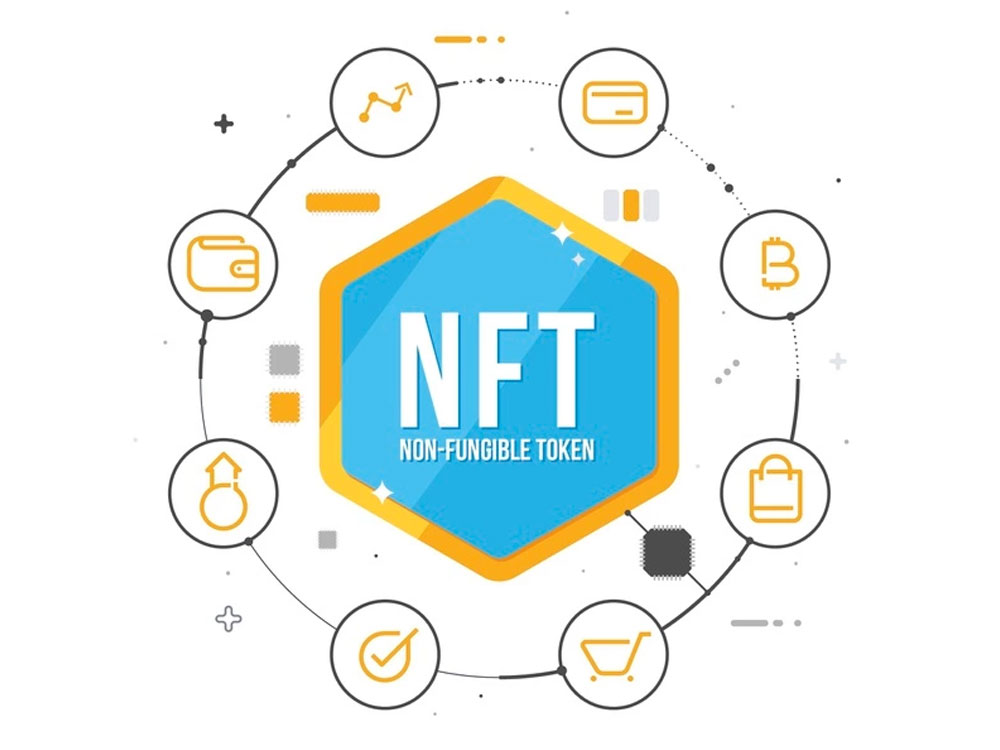
Keys to NFT Success
When creating the NFT p itch deck for clients, it should echo the excellent unit economics and include the following points -
- Low marginal cost
Virtual trading cards or comics have a lower marginal cost of manufacture and dissemination than traditional physical trading cards or comics. While both need upfront expenses for designers, selling assets through a digital channel saves thousands of dollars in printing production costs, as well as the time and effort required to manage retail channels to get products into stores. Converting digital artwork into NFTs necessitates paying "gas fees" to mint tokens on a blockchain, which can cost up to $150, as well as a tiny monthly subscription charge, which varies depending on which platform or marketplace you choose as an outlet.
- Improved customer engagement
- Limitless potential
Intellectual property rights are also important to consider, however, this is still a developing field. Because there is no legal precedence in the United States for NFT ownership, a number of significant questions about authors' retention of commercial rights and future licensing are still being contested or refined, says the experts.
Finally, the ecological impact must be taken into account. The Ethereum network, which generates as much carbon as some small countries, is where most NFTs are traded and exchanged. That's large because the decentralized consensus technique it uses to validate transactions, known as proof of work, necessitates a lot of computational power. Companies, as well as individual artists, may face backlash or loss of sales from environmentally concerned clients.

- Know the Risks
So, what's keeping your organization from joining the NFT bandwagon? Even a believer like me realizes that the industry is in its infancy and is largely unregulated. To begin with, not all NFTs are the same. Yes, the ownership certificate kept on the public blockchain ledger is immutable and unforgeable. It's important to understand, though, that this token is only a link to a digital file stored on a server. And not every server is the same.
Link rot, which occurs when hyperlinks break, is a severe issue. This usually occurs when the target file is relocated to a new server without the connection being updated, or when the server goes down. Keep track of where the digital file is stored when making or purchasing an NFT. The likelihood of the NFT being lost increases dramatically when it is stored on a local server. A public cloud storage solution decreases this danger, but a decentralized server is even better. You should also make sure the token's metadata is saved on a decentralized server.
For a free assessment of your situation and needs, fill out the form below and an expert will respond shortly.
Or call us toll-free: 800-691-6202
NFT Roadmap Guide (With Examples & Template)

Discover the importance of an NFT roadmap & examples of successful projects. Learn different approaches to roadmaps & how they drive community engagement & trust.
Welcome to our in-depth guide on NFT roadmaps. This article will provide a comprehensive overview of what NFT roadmaps are, their advantages and limitations, and real-life examples from successful projects. Additionally, we will be providing a basic template that you can use to get started creating your own NFT roadmap.
NFTs have become a popular topic in the blockchain and cryptocurrency space over the past couple of years, and for good reason. They allow for the creation of unique digital assets that can be bought, sold, and traded on the blockchain. However, creating a successful NFT project takes more than just technical knowledge; it also requires a clear vision and strategy. That's where NFT roadmaps come in. They provide both a clear path for the development and growth of your project and communicate your intent to your community members.
By the end of this article, you will have a better understanding of NFT roadmaps, their pros and cons, and how to create one for your own project.
What is an NFT Roadmap?
An NFT roadmap is a plan that outlines the steps a creator, or team will take to launch and grow their own NFT project. It serves as a guide for the development and implementation of a new NFT ecosystem, from concept to launch, and lays out what the community can expect from the project post-mint.
An NFT roadmap typically includes a clear vision for the project, a list of key milestones, and a timeline for achieving them. It also generally identifies the resources needed for the project, including funding, personnel, and partnerships.
One important aspect of an NFT roadmap is the creation of a token economy. This involves determining how the NFTs will be used and valued within the ecosystem, as well as outlining the incentives for users to participate in the ecosystem.
Another key component of an NFT roadmap is the development of a strong community. This can include strategies for building a community of artists, creators, and enthusiasts around the project, as well as engaging with potential partners and collaborators.
NFT roadmaps also tend to include a plan for ongoing maintenance and growth of the project. This can include strategies for marketing, user acquisition, and community building, as well as plans for future developments and updates to the NFT ecosystem.
Overall, an NFT roadmap serves as a helpful, but not necessarily required tool for any organization or individual looking to launch an NFT project. It provides a clear and actionable plan for developing and launching a new NFT ecosystem, and helps ensure that the project stays on track and achieves its goals.
In the next section, we’ll discuss the pros and cons of using NFTs roadmaps so you can better understand whether implementing a roadmap is the right choice for your project or brand.
Pros and Cons of NFT Roadmaps
Knowing if you should implement an NFT roadmap can be a tough choice and there are many legitimate reasons as to why you may not want to have one.
To help, we’ve weighed the pros and cons below;
There are several advantages to using an NFT roadmap to guide your project:
- Provides a clear vision and goals: NFT roadmaps provide a clear vision and goals for the NFT project, which helps the development team and stakeholders to understand the project's objectives and key results. This helps to align the project's vision and goals with the current state of the NFT market, target audience, and industry trends.
- Detailed plan for development: NFT roadmaps include a detailed plan for the development, launch, and growth of the project, which helps to track progress and make adjustments as needed. This includes information about the technology stack, tokenomics, and the team behind the project, which helps to ensure that the project is delivered on time and within budget.
- Plan for marketing and promotion: NFT roadmaps include a detailed plan for the marketing and promotion of the project, which is key to attract investors, partners, and users. This includes information about social media and community engagement strategies, as well as plans for PR and influencer marketing.
- Facilitates communication and engagement: NFT roadmaps provide a clear plan for communication and engagement with stakeholders, including investors, partners, and the community. This helps to ensure that all stakeholders are aware of the project's status and next steps, and that any unexpected challenges or opportunities that arise during the project can be addressed.
- Helps to raise attention and sales: NFT roadmaps help to raise capital for the project, by providing a clear and concise plan for the development, marketing, and long-term goals of the project. This can be used to attract potential new owners and partners, and to demonstrate the project's potential for success, which can increase the chances of raising the necessary funds.
But on the other hand, there are some disadvantages to consider before diving into the creation of an NFT roadmap:
- Limited flexibility: NFT roadmaps provide a detailed plan for the development, launch, and growth of the project, but they can also limit flexibility. Projects may encounter unexpected challenges or opportunities that require adjustments to the roadmap, and if the roadmap is not flexible enough, it can be difficult to adapt to these changes.
- Limited scope: NFT roadmaps often focus on specific aspects of the project, such as development and marketing, but they may not take into account other important factors such as legal and regulatory compliance.
- Time-consuming to create: Creating an NFT roadmap can be a time-consuming process, requiring significant research and planning. This can be a challenge for businesses with limited resources or tight timelines.
- Risk of not achieving goals: NFT roadmaps set out a clear path for the project to follow, but if it's not executed correctly the project may not achieve its goals. This can be due to lack of funding, lack of support from the community, or lack of adoption of the project.
- Risk of over-promising: NFT roadmaps are used to attract investors and partners, but it's important to be realistic about what can be achieved, setting unrealistic goals can lead to disappointment and mistrust from potential partners or investors.
- Risk of becoming outdated: NFT roadmaps are created with a specific vision and goals, but if the market or the technology changes the roadmap can become outdated. This can lead to the project falling behind the market trends and becoming less attractive to investors and partners.
Do You Need a Roadmap for NFTs?
No, a community roadmap is not necessary for an NFT project. While a roadmap can be helpful in outlining goals and milestones, providing updates, and building community engagement, it is not a required component for a successful NFT project.
In some cases, a roadmap can cause issues if a project over promises and fails to deliver, so it is important to carefully consider the need for a roadmap and the potential risks before implementing one.
Ultimately, the success of an NFT project will depend on a variety of factors, including the strength of the team, the value of the product, and the engagement of the community. Your roadmap is just a small component in this at the end of the day.
Now with that out of the way, if you’re still looking to create a roadmap for your NFT project, let’s dive in and cover some of the basics.
How to create an NFT Roadmap
Businesses can create an NFT roadmap by following these steps:
- Define the project's vision and goals : The first step in creating an NFT roadmap is to clearly define the project's vision and goals. This includes identifying the problem or opportunity that the NFT project aims to address, as well as the specific objectives and key results that the project aims to achieve.
- Create a project timeline: Once the vision and goals have been defined, businesses can create a project timeline outlining the key milestones and deliverables for the NFT project. This timeline should include information about the project's current status, upcoming milestones, and key deliverables.
- Develop a tokenomics model: NFT projects rely on tokenomics, so it's important to develop a tokenomics model that outlines the project's token economics, including the total supply, token distribution, and the use cases for the token.
- Define the team: The team behind the project is crucial for the success of the NFT project, so it's important to define the team and their roles and responsibilities in the project. This section of the roadmap should also include information about the team's experience and their plans to build the community.
- Develop a marketing and promotion plan: An NFT roadmap should also include a detailed plan for the marketing and promotion of the project, including information about how the project will be marketed to potential investors, partners, and users. This may include information about the project's social media and community engagement strategies, as well as plans for PR and influencer marketing.
- Outline the development and maintenance plan: The NFT roadmap should also include a plan for the ongoing development and maintenance of the project, including details about how the project will be updated and supported after its launch. This may include information about bug fixing, feature development, and community engagement.
- Review and update the roadmap regularly: As the project progresses, it's important for businesses to review and update the NFT roadmap regularly to ensure that it remains aligned with the project's vision and goals, and that all stakeholders are aware of the project's status and next steps.
To help you better understand how to create your own NFT roadmap, what better way than to learn from some of the best.
6 NFT Roadmap Examples to Learn From
In this section, we’ll cover some of the top projects in the space and provide examples of they’ve approached their NFT roadmaps.

SOURCE: AZUKI
Azuki Mind Map
An effective NFT project roadmap should clearly outline the goals and milestones of the project, and provide regular updates to the community on its progress. Azuki's "Mindmap" is an excellent example of this, with its clean and aesthetic layout that groups its goals into seven distinct categories.
Each category includes specific targets, and Azuki's community can easily see the progress of each goal marked as "Complete", "Exploring", or "In Progress". This approach provides the community with a clear and concise view of the project's progress, which is essential for building trust and engagement.
Overall, a well-crafted NFT project roadmap like Azuki's "Mindmap" can be a powerful tool for communicating the project's vision and progress to the community, and ultimately driving its success in the Web3 ecosystem.

SOURCE: Bored Ape Yacht Club
Bored Apes/Yuga Labs
BAYC's NFT project roadmap is a great example of a simple yet effective approach to tracking progress. Instead of a detailed and elaborate plan, they have chosen to measure their progress by percentage of target sales. This approach might not be as elaborate but it is fully achieved which means that the team have accurately assessed their capabilities as developers and have delivered on their promises.
This approach is effective in keeping the community informed and engaged, while also building trust in the project's ability to execute on its vision.
BAYC's roadmap is a great example of how a clear and achievable NFT project roadmap can be a powerful tool in driving the project's success within the Web3 ecosystem.

SOURCE: Cool Cats
CoolCats is a digital collectible platform that uses a unique and engaging approach to their NFT project roadmap. Instead of a traditional linear timeline, CoolCats has created an interactive map that allows users to explore different areas of their project and learn more about the different features and functionalities that will be developed.
Each area of the map is represented by a different cat character, and users can click on each character to learn more about the corresponding feature. This approach makes the roadmap more accessible and engaging for users, and allows them to easily understand the project's vision and progress.
CoolCats roadmap is a great example of how a creative and interactive approach can make a roadmap more engaging and accessible for the community. Additionally, by breaking down complex goals into smaller and more manageable chunks, it allows the community to easily understand the project's progress and vision, which is essential for building trust and engagement.

SOURCE: Sorare Twitter
Sorare is a blockchain-based fantasy football game that uses NFTs to represent unique player cards. Their NFT roadmap outlines the development and launch of their game, including the use of Ethereum blockchain and the ERC-721 token standard.
They have a clear vision of creating a decentralized gaming platform that allows users to own, trade and collect unique digital items, and they also have a clear plan for the game's development, including the launch of different leagues, and new functionalities, such as in-game tournaments.
They also have a clear plan for the community engagement and the marketing of the game, which includes the use of social media, referral program, and partnerships with football clubs and players.

SOURCE: Aavegotchi Wiki
Aavegotchi is a blockchain-based game that uses NFTs to represent unique ghost pets. Their NFT roadmap is focused on the game's development and launch, which includes the use of Ethereum blockchain, the ERC-721 token standard, and the Aave protocol.
They have a clear vision of creating a decentralized gaming platform that allows users to own, train and battle unique ghost pets, and they also have a clear plan for the game's development, including the launch of different features such as breeding, and different worlds, and they also have a clear plan for community engagement and the marketing of the game, which includes the use of social media, referral program, and collaborations with influencers and other games.

SOURCE: Pop Art Cats
Pop Art Cats
Pop Art Cats is a Digital Art collection by the artist Matt Chessco. It’s roadmap takes a playful approach providing it’s community with a map based outline of what to expect as the community grows and the artist produces more work.
Examples of next steps include what art is coming, events, and merch drops. All of this combined helps community members to understand the value of the products and collectibles they are purchasing and can increase loyalty by promoting community feedback/participation.
NFT Roadmap Template
If it’s not clear yet, an NFT roadmap can serve as a valuable asset in outlining your plans and objectives, and in communicating them to your target audience. To help you get started with creating one (if you think it’s the right choice!) , here's an example of a quarterly NFT project roadmap that can be tailored to suit your specific needs:
- Develop a marketing strategy to increase awareness and excitement for your project.
- Set a mint date for your NFTs and communicate it to your audience.
- Consider launching an airdrop for holders of your NFTs.
- Roll out a website and Discord channel to provide a platform for engagement and communication.
- Utilize Twitter Spaces to connect with your community and build interest in your project.
- Explore collaborations with other projects or artists to create exclusive and desirable collectables.
- Develop merchandise related to your project to offer additional ways for users to engage with your brand.
- Introduce exclusive collectables to your inventory to create a sense of scarcity and desirability.
- Develop a game that incorporates your NFTs and community gamification to access future mints.
- Plan a Metaverse event with OnCyber to showcase the capabilities of your NFTs and promote the project.
- Roll out a token for your project and explore the possibilities of a DAO.
- Consider opening a physical store that utilizes your NFTs in an innovative way.
It's important to note that this is just a sample roadmap and you should consider how to adapt it to your own project's goals and objectives.
An NFT roadmap can help you stay organized and focused while providing a way to measure progress and success. By communicating your plans and objectives, you can build trust and excitement for your project, which is crucial for its success. But keep in mind that a roadmap is only good if you use it and deliver on your promises otherwise you’ll likely end up with more headaches than you wished for.
We’d love to hear from you
In conclusion, an NFT project roadmap is an essential tool for any NFT project. It provides a clear and concise plan for the development and launch of the project and allows for better communication and coordination among team members.
By including key milestones, timelines, and deliverables, an NFT project roadmap can help to ensure that the project stays on track and meets its goals. Additionally, by including a detailed marketing and community engagement plan, an NFT project roadmap can help to build a strong community around the project, which is essential for its long-term success.
Overall, a well-crafted NFT project roadmap can be a valuable tool that can help to ensure the success of an NFT project and maximize its potential impact on the Web3 ecosystem.
But we’d love to hear your thoughts? Roadmaps can be a bit of a debate in space and we want to provide the most reasoned perspective to our audience. If you have something to add don’t hesitate to drop us a line!
How helpful was this?
We're sorry to hear that. How can we improve?
Thanks for your feedback! Let us know how this article helped:
- Our Services
- NFTs for Business

A Complete Guide on How NFTs Can Benefit Your Business
26 MIN. READ
What are NFTs?
How to use nfts for your business, grow brand awareness, run innovative marketing campaigns using nft for your business, raise funds by selling nft collections, build nft communities, raise fund charities, licensing and registrations, create loyalty programs, how can businesses use nfts.
Your enquiry was received successfully.
Thank you for contacting us.
We will come back to you soon.
Something went wrong, your enquiry was not sent.
Please try again later or send email with your enquiry to [email protected]
The world of Non-Fungible Tokens (NFTs) has exploded in recent years, with artists, musicians, and even athletes getting in on the action. But what exactly are NFTs, and how can you use the approach of an NFT in business? This comprehensive guide will cover everything you need to know about NFTs, including real-life examples and use cases.
The concept of NFTs dates back to 2012 when the blockchain-based game “CryptoKitties” was introduced. CryptoKitties allowed players to collect, breed, and trade virtual cats, with each cat represented by a unique NFT. However, it wasn’t until 2017 that NFTs gained widespread attention, thanks to the success of CryptoPunks, a collection of 10,000 unique 8-bit characters, each represented by its own NFT.
Since then, the market for NFTs has exploded, with NFT sales reaching a total of $2.5 billion in the first half of 2021 alone, according to data from DappRadar. The popularity of NFTs has been driven by a number of factors, including the ability to prove ownership and authenticity of digital assets, the potential for creators to earn revenue through the sale of their work, and the allure of owning a one-of-a-kind asset that cannot be replicated.
Non-fungible tokens, or NFTs, are unique digital assets that are stored on a blockchain network, making them easily verifiable and immutable. Unlike cryptocurrencies such as Bitcoin and Ethereum, which are fungible and can be exchanged for identical units, non-fungible means something is unique and irreplaceable. This characteristic makes each NFT has its unique value and characteristics. They cannot be exchanged for other tokens on a 1-to-1 basis like we can exchange 1 BTC for 1 BTC. NFTs are typically used to represent digital art, collectibles, music, videos, tweets, and even virtual real estate

One of the key qualities of NFTs is their decentralized nature, which means they are not controlled by any central authority or institution. NFT transactions are transparent, as they are recorded on a public blockchain that enables anyone to track ownership and transaction history. Additionally, NFTs are often encrypted, providing an additional layer of security to the ownership and authenticity of the underlying asset. The unique qualities of NFTs have led to their popularity among creators and collectors, as they provide a means of rightfully owning and exchanging digital art that were previously difficult to monetize or verify ownership of.
One of the most high-profile NFT sales to date was the digital artwork “Everydays: The First 5000 Days” by artist Beeple, which sold for a record-breaking $69.3 million at a Christie’s auction in March 2021. Other notable NFT sales include a tweet by Twitter CEO Jack Dorsey, which sold for $2.9 million, and a virtual house in the online game Decentraland , which sold for $2.4 million.

The use cases for NFTs extend far beyond the art world, with many industries exploring the potential of NFTs for business. For example, NFTs could be used to prove ownership of physical assets such as luxury goods or real estate or to track the authenticity and ownership of digital assets such as patents and copyrights. NFTs also have potential in the gaming industry, where they could be used to represent in-game assets and items.
This blog will guide you on how to use NFT in business and nowadays many companies are booming with more and more creative campaigns and approaches to implementing NFTs in their business models. We have favored some of the most impressive examples below in this guide as a bonus.
While NFTs were initially popularized in the art and music industries, they are now gaining traction in the business world as well. By leveraging the power of NFTs, businesses can create new revenue streams, stand out in a crowded marketplace, and reward customer engagement loyalty by offering unique opportunities. Using NFTs for your business creates a new way to monetize digital assets. In this article, we’ll explore in more detail why businesses should pay attention to NFTs and how they can benefit from this emerging technology.
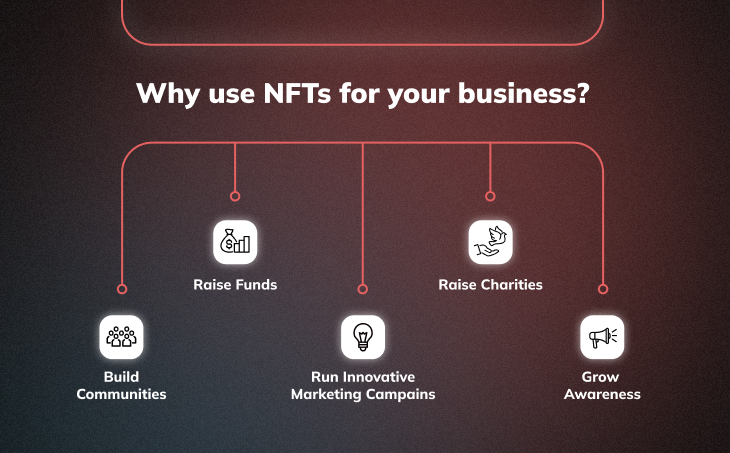
In the following sections, we have broken down the specific advantages and steps for implementing the NFT approach:
NFTs can be a powerful tool for growing brand awareness for businesses. By creating unique NFTs that showcase their brand and products, businesses can reach new audiences and build a stronger following. NFTs can be used to reward customer loyalty or build a community around the brand, which can create a sense of exclusivity and belonging. By creating one-of-a-kind NFTs that showcase their brand and products, businesses can generate buzz and attract attention from collectors, investors, and fans. What is more, as NFTs are used to protect a company’s intellectual property, this approach can help the company build trust with the customers and establish the brand as a leader in their industry.
A good example is Pizza Hut. The tasty brand launched a simple pizza slice as NFTs. The interesting part is that with each NFT, the collector receives an authentic Pizza Hut recipe, according to the NFT piece. The most expensive share is estimated at $8,824. Their next step is happing right now. The brand released The Pizzaverse through an AR app, continuing the Pizza story:
the pizzaverse is now open https://t.co/aLIeBoR3Il — Pizza Hut (@pizzahut) June 1, 2022
Companies like Digital Artists work with global brands.
NFTs offer businesses a unique and trendy way to run marketing campaigns that capture the attention of consumers. By creating NFTs that are tied to your brand or products, an NFT for your businesses can leverage the growing popularity of NFTs to attract attention and engage with customers in a new way. Here are some examples of names creating a sense of exclusivity around their brand through NFTs:
In 2021, the fast-food chain released a series of NFTs that were tied to their new menu items. Each NFT featured a 3D animation of the menu item, along with sound effects and music. The NFTs were sold on the blockchain marketplace, Rarible, and were priced between $1 and $5. By creating these unique and collectible NFTs, Taco Bell was able to create a buzz around their new menu items and engage with their customers in a new and exciting way.
Our Spicy Potato Soft Tacos can now live in your hearts, stomachs and digital wallets. https://t.co/IC8b45lmd9 pic.twitter.com/FJUcuwCuyy — Taco Bell (@tacobell) March 8, 2021
Gucci has been making significant strides in the NFT space, launching several campaigns that have captured the attention of the fashion and art worlds.
In 2021, Gucci launched the “Aria” NFT campaign on the Arianee blockchain platform, which featured a series of 24 unique NFTs inspired by the brand’s history and iconic designs.
Later on, in 2022, Gucci launched its own metaverse, which includes an NFT marketplace where users can buy and sell digital assets. They also partnered with the digital art platform Art021 to launch “The Vault of Art Space”, a virtual exhibition featuring exclusive NFT artworks by a variety of artists. Among they latest projects, is “Supergucci” – a collection of NFTs inspired by the brand’s signature motifs and designs. The collection includes a variety of unique NFTs, including digital sneakers, bags, and other accessories. The NFTs were sold on the Arianee blockchain platform and were priced between $9 and $12.
In the first drop of #SUPERGUCCI NFTs, @superplastic ’s #SuperJanky finds himself in ten different dreamscapes inspired by #GucciAria by #AlessandroMichele . Discover more on Vault’s Discord channel https://t.co/wEUMFP1c3G pic.twitter.com/yshQAx4I2E — gucci (@gucci) February 1, 2022
By creating unique and collectible NFTs, businesses can attract attention and engage with their customers in new and exciting ways. Taco Bell and Gucci are just a few examples of brands that have leveraged the power of NFTs to create buzz around their products and generate revenue. With the growing popularity of NFTs, businesses of all sizes can explore this innovative marketing strategy to capture the attention of their target audience and take their brand to the next level.
Selling NFT collections is a relatively new way for businesses to raise funds . By creating unique and collectible NFTs that are tied to their brand or products, businesses can generate revenue from the sale of these digital assets. This strategy has become particularly popular in the art world, where artists are selling NFTs of their digital artwork for millions of dollars. However, it’s not just artists who can benefit from this trend – businesses in a variety of industries are starting to leverage NFTs to raise funds and engage with their audience in a new way. Here are some good examples:
In 2021, the NBA launched its own NFT platform, Top Shot , which allows users to buy, sell, and trade officially licensed NBA collectible highlights. Each highlight is sold as a unique NFT, and prices can range from a few dollars to thousands of dollars depending on the rarity of the highlight. In just a few months, Top Shot generated over $500 million in sales, demonstrating the potential for NFTs as a fundraising tool.
Burberry launched a collection of NFTs inspired by its iconic plaid pattern. The collection included three different NFTs and was sold on Mythical Games for $60 to $480. The sale generated over $200,000 in revenue, which was donated to charities supporting communities affected by the COVID-19 pandemic. By using NFTs to raise funds for charity, Burberry was able to engage with its audience and demonstrate its commitment to social responsibility. Check the collection here → This year we can stride in BURBERRY X BLANKOS BLOCK PARTY .
In conclusion, NFTs present an exciting opportunity for small businesses to raise funds and expand their operations. The success of large-scale NFT projects demonstrates the potential of this fundraising method, and small businesses can leverage NFT drops to access the growing Web3 community and reach new audiences.
As with every new thing, we know it can be a little frustrating to step into this entirely new domain and we understand you. Therefore, the team of Digital Artists is and will always be here to get you out of the tight spot and place your potential under the lights. Digital Artists specializes in actively assisting small businesses to build their own NFT collections and raise the proper funds, gaining the sales they need. Our wireframe is “Every business is unique”, so there is no “one fit for all” strategy. Rather, we choose to work closely with the brand and together with our extensive knowledge in the NFT industry, build a strategy with a ready-to-use action plan.
NFTs offer businesses a powerful tool for building strong and engaged communities around their brand or products. By creating unique and collectible NFTs, businesses can foster a sense of exclusivity and create a community of passionate fans and collectors. With the potential for high returns and the ability to reach a new and engaged audience, it’s no wonder that more and more businesses are exploring the use of NFTs to build strong communities. Savour these two great examples for NFT community building: the Alma Mater of the field and the latest but leading one:
Cryptopunks
The Cryptopunks community is known for being one of the most engaged and active communities in the NFT space. Here are some of the typical characteristics of the Cryptopunks community:
- Passionate collectors: Many members of the Cryptopunks community are passionate collectors who are dedicated to acquiring and holding rare and valuable Cryptopunks NFTs. These collectors often form close-knit groups and share information and insights about the market, upcoming auctions, and new releases.
- Collaborative culture: The Cryptopunks community is known for its collaborative and supportive culture, with members often working together on projects, sharing resources and knowledge, and supporting each other’s creative endeavors.
- Creative experimentation: The Cryptopunks community is also known for its creative experimentation, with members often pushing the boundaries of what is possible with NFTs and exploring new ways to showcase and interact with their Cryptopunks.
- Inclusivity and diversity: Despite the high value and exclusivity of Cryptopunks NFTs, the community is known for being welcoming and inclusive, with members from all walks of life and backgrounds. This inclusivity and diversity has helped to make the Cryptopunks community a vibrant and dynamic place where new ideas and perspectives are encouraged and celebrated.
Overall, the Cryptopunks community is a passionate, creative, and collaborative group of collectors and enthusiasts who are dedicated to exploring the possibilities of NFTs and pushing the boundaries of what is possible in the digital art world.
VeeFriends is building its NFT community through various initiatives that focus on fostering collaboration, education, and support among its members.
VeeFriends also hosts regular events and workshops, such as the VeeCon conference, where members can connect with each other and learn from industry experts. They also offer mentorship programs and grants to support members’ projects and ideas.
In addition, VeeFriends has created a unique NFT ecosystem where members can purchase and trade NFTs that grant access to exclusive experiences, such as attending private dinners with Gary Vaynerchuk or participating in group coaching sessions.
Overall, VeeFriends’ approach to building their NFT community is centered around creating opportunities for members to connect, learn, and collaborate, while also providing exclusive experiences that add value to their membership.
In conclusion, NFTs are a powerful tool for businesses to build engaged and passionate communities around their brand or products. The Cryptopunks community is a prime example of a community that is passionate, collaborative, and creative, and they have been able to push the boundaries of what is possible with NFTs. Meanwhile, VeeFriends is taking a different approach, focusing on fostering collaboration, education, and support among its members, while also providing unique and exclusive experiences through their NFT ecosystem. By leveraging NFTs to build communities, businesses can create a sense of exclusivity, foster collaboration, and connect with their audience in new and exciting ways, ultimately driving growth and success for their business.
NFT fund charities are a new and innovative way to raise money for charitable causes through the use of non-fungible tokens. These initiatives leverage the popularity of NFTs to generate interest and support for various charitable organizations, while also providing NFT collectors with an opportunity to give back to society.
NFT fund charities typically involve the auctioning of unique or rare NFTs, with the proceeds going directly to the designated charity. These auctions can generate significant sums of money, which can be used to support a range of social causes, from providing clean water to impoverished communities to funding research for diseases. NFT fund charities have been successful in bringing together different communities, including crypto enthusiasts, art collectors, and philanthropists, to support a common goal. A good example is The Art Blocks Playground Initiative . This is a popular NFT platform launched by the Playground Initiative, which aims to raise funds for the St. Jude Children’s Research Hospital. The initiative involves the auctioning of unique NFTs created by various artists, with all proceeds going to the charity.
Explore NFT Gallery – The Future of Presenting Digital Art .
Licensing and registrations with NFTs are two important considerations for creators and buyers of NFTs. Licensing refers to the legal agreements that govern how an NFT can be used and distributed, while registrations refer to the process of formally registering an NFT with an organization or regulatory body.

Licensing is essential for NFT creators to ensure that their intellectual property rights are protected, while also providing clarity to buyers on what they can and cannot do with the NFT. There are various types of licenses available, such as exclusive, non-exclusive, and limited licenses, which dictate the level of control the creator has over the NFT.
Registrations, on the other hand, can help to establish the authenticity and ownership of an NFT, which is particularly important for high-value NFTs. Some organizations, such as the Winklevoss-led NFT regulatory body NFT NYC, are exploring the possibility of developing a formal registration system for NFTs.
To sum up, licensing and registrations are crucial considerations for anyone involved in the NFT space, and they can help to provide clarity and protection for creators and buyers alike.
When you get to the thought that there isn’t any other way on how to use NFT for your business, here come the Loyalty Programs. NFT loyalty programs are a new and innovative way for brands and businesses to reward and incentivize their customers using non-fungible tokens. These programs typically involve the creation of unique NFTs that customers can earn through specific actions or behaviors, such as making a purchase or referring a friend. The NFTs can then be redeemed for exclusive rewards, such as discounts, merchandise, or access to special events.

One recent example of an NFT loyalty program is the NBA’s Top Shot Moments Rewards program, which allows users to earn exclusive NFTs by completing various challenges, such as collecting a specific number of moments or completing a set of moments.
Another example is the Axie Infinity Scholarship Program , where players can earn NFTs by participating in the game and using them to pay for tuition to attend Axie Infinity’s play-to-earn program.
The NFT loyalty programs have the potential to provide brands and businesses with a unique and engaging way to build customer loyalty and incentivize specific behaviors, while also providing customers with exclusive and valuable rewards.
As you witnessed, Businesses can use NFTs in a variety of ways to engage with their customers and enhance their marketing strategies. And yet, lets sum up:
One way, of course, is by creating unique and collectible NFTs that represent their brand or products, which can then be sold or given away to customers as promotional items. This can help to create a sense of exclusivity and reward customer loyalty. NFTs can also be used to create new revenue streams by auctioning off limited edition NFTs or by selling digital assets as NFTs. Additionally, businesses can use NFTs to track the ownership and authenticity of physical goods, such as luxury items or artwork, by creating a digital record of ownership on the blockchain.
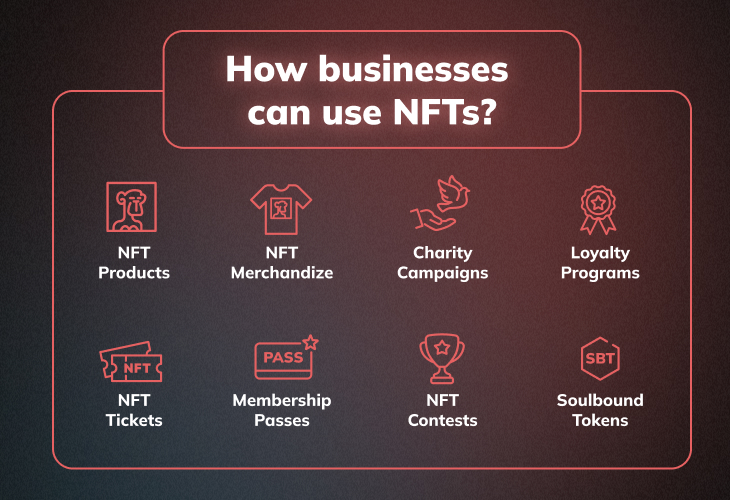
Finally, NFTs can be used to create new types of experiences or gamification opportunities, such as using NFTs as tickets to exclusive events or as rewards for completing certain actions or behaviors. Down the rabbit hole here, you can follow a nice lineup of what you can do in your NFT brand:
Drop Your Own NFT Collections
Dropping your own NFT collections involves creating and releasing your own unique NFTs. This process typically involves designing and minting the NFTs, determining the distribution and pricing strategy, and marketing the collection to potential buyers. By dropping your own NFT collection, you have full creative control over the design and distribution of the NFTs, allowing you to create a unique and exclusive offering for collectors. However, it is important to consider the competitive landscape and ensure that your collection offers something truly unique and valuable to potential buyers.
Create NFT Avatars
What is the wisest first approach to creating NFTs for small businesses? Creating NFT avatars! It involves designing and minting unique non-fungible tokens that represent digital personas or characters. NFT avatars can be used in a variety of applications, such as gaming, social media, or virtual reality. By creating NFT avatars, individuals and businesses can offer a new level of personalization and exclusivity to their customers and users.
Mint Your Products as NFTs And Add Exclusivity
Selling NFT versions of a brand product is an innovative way for businesses to offer their customers a unique and exclusive digital collectible that represents the physical product. This involves creating an NFT that features a digital representation of the product, along with any accompanying metadata or information about the product. The NFT can then be sold to collectors and fans of the brand, offering them a new way to engage with and own a piece of the brand’s history. NFTs can also be used to offer additional benefits to customers who purchase the physical product, such as access to exclusive content or experiences.
RTFKT, together with Nike CryptoKicks, introduce the future of Sneakers, powered by Skin Vial tech Welcome to 2052 : 🌐👟🧪 pic.twitter.com/7449L79Bf4 — RTFKT (@RTFKT) April 22, 2022
By offering NFT versions of their products, brands can tap into the growing market for digital collectibles and provide their customers with a new and innovative way to engage with their products and brand.
Another great approach in this field is creating exclusive NFTs for top fans. This is a way for businesses to reward and incentivize their most dedicated customers or followers. This involves designing and minting unique NFTs that can only be earned or purchased by those who have achieved a certain level of engagement or loyalty with the brand.
These NFTs can represent anything from exclusive content, merchandise, or experiences , and can be used to create a sense of exclusivity and value for those who have earned them.
And here are also some good examples of non-physical businesses that has created exclusive NFTs for top fans is:
Kings of Leon
The rock band Kings of Leon released three different types of NFTs as part of their album release campaign.
The social media platform launched “TikTok Top Moments, Own The Moment” a selection of six culturally significant TikTok videos from some of their most beloved creators and influencers.
Following the model for your business, you can enhance your customer loyalty programs and offer a new and innovative way for customers to engage with and promote your brand.
Build Digital Identity with Soulbound Tokens
Digital identity is a critical component of our online lives, and Soulbound NFT tokens are a new and innovative way to create and manage digital identity. Unlike traditional identity management systems that rely on centralized databases, Soulbound NFT tokens are unique and verifiable digital assets that are stored on the blockchain. This means that they are tamper-proof and cannot be forged or duplicated.
Soulbound NFT tokens can be used to represent a wide range of digital identities, such as social media profiles, gaming avatars, or digital collectibles, and can be linked to real-world identities through identity verification processes. By using Soulbound NFT tokens for digital identity management, individuals and businesses can enhance the security, privacy, and ownership of their digital assets.
Upgrade Your Digital Merchandise
Is it possible to use NFT for small businesses? Absolutely! Digital merchandises are a new type of digital asset that can be bought, sold, and traded online and are perfect for small companies as well. These digital assets can take many forms, such as digital artwork, music, videos, and other digital content.
Using NFTs to d to represent digital merchandise, provides a new level of ownership and authenticity to digital content. Businesses can use NFTs to offer unique and limited-edition digital merchandise to their customers, creating a new market for digital collectibles. Digital merchandise can be sold on online marketplaces, such as OpenSea or Nifty Gateway, and can be purchased using cryptocurrencies or fiat currencies.
A good example of a business using NFTs for digital merchandise is the musician Grimes , who sold a collection of digital art and music as NFTs for a total of $6 million.
Run NFT Contests
NFTs can be used to run contests and promotions. Businesses can design and mint unique NFTs that serve as prizes for winners of the contest or promotion, creating a sense of exclusivity and value for the participants. NFT-based contests can be run on online marketplaces, social media platforms, or other digital channels, and can be promoted through various marketing channels.
One recent example of an NFT contest is the “NFT Summer” campaign by the decentralized finance (DeFi) platform Aave. The campaign involved several challenges, including depositing and borrowing cryptocurrency on their platform, participating in social media challenges, and completing various other tasks related to DeFi.
Participants who completed the challenges were eligible to win unique NFTs, including a series of “Aavegotchi” digital pets that can be used in various blockchain-based games. The campaign generated a lot of interest among the DeFi community, with thousands of participants competing for the NFT prizes.
This is just one example of how NFTs can be used to create engaging and interactive contests, providing a new and innovative way for businesses to engage with their customers and fans.
Issue Memberships with NFT Passes
Club memberships with NFT passes are becoming part of today’s world and it’s even more exciting than it sounds.
NFT passes can be used to represent memberships, providing a new level of ownership and authenticity to club memberships. By using NFT passes, businesses can offer unique and limited-edition memberships to their most loyal customers, providing a sense of VIP value. NFT passes can be minted on blockchain platforms and can be transferred between users, allowing members to trade or sell their memberships to others.
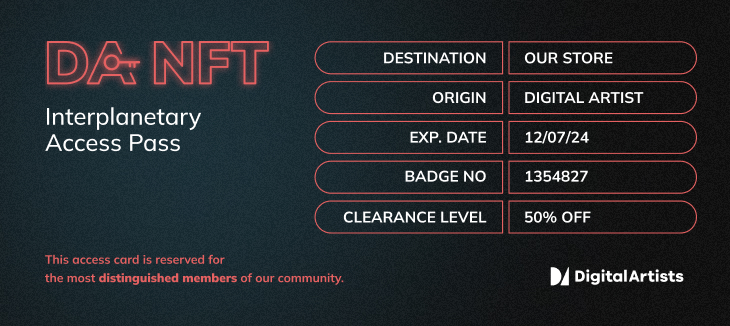
The top-ranking brand regarding club memberships and NFT Passes in 2023 is the Proof Collective . This pass is a collection of 1,000 exclusive membership pass NFTs on the Ethereum blockchain. PROOF Collective as a whole was founded by serial entrepreneur Kevin Rose- a host of the PROOF Podcast which provides in-depth NFT coverage and interviews. Holders of a PROOF Collective Pass NFT are able to access exclusive channels within the private PROOF Discord, together with early access to PROOF Podcast episodes.
Sell NFT Tickets for All Kinds of Events

NFT tickets for events are the new wave that is taking the world by storm! This revolutionary concept is bringing a new level of excitement and engagement to event organizers and attendees alike. By using blockchain technology, NFT tickets provide a more secure and transparent ticketing system that ensures fair access to events and reduces the risk of fraud.
But that’s not all – NFT tickets offer a range of benefits for attendees, from providing a more engaging and personalized experience to exclusive access to VIP areas, merchandise, and other perks. Imagine attending an event with a unique digital asset that can be customized with unique designs, animations, and other interactive features. It’s like having a personal pass to the most exclusive events in the world!
The leading names leaning entirely on the wide range of possibilities that NFT Tickets can offer are Coachella, GaryVee, Kings of Leon, Maroon 5, EXIT Festival, and many more big names!
What is also worth focusing on are the platforms that offer NFT ticketing. Among the leading are: YellowHeartNFT , GUTS , Wicket , NFT TiX , and SeatLab .
We suggest you get ready to ride the NFT ticketing wave and experience a whole new level of excitement and engagement in the event space!
In conclusion, NFTs represent a groundbreaking development in the world of digital assets and ownership. As we’ve seen throughout this guide, NFTs offer businesses a range of exciting possibilities, from creating new revenue streams to fostering stronger relationships with customers. By leveraging the unique properties of blockchain technology and smart contracts, companies can use NFTs to unlock new forms of value and creativity and to engage with audiences in innovative ways.
Whether you’re a creative professional looking to monetize your work, a brand looking to build deeper connections with customers, or a business looking to explore new revenue streams, NFTs offer an exciting and powerful new tool for achieving your goals. By staying informed and keeping an open mind about this rapidly-evolving technology, businesses can position themselves to succeed in the digital economy of the future.
It is never too late to launch your NFT brand!
Also explore: Shopify NFTs Guide .
If you still have a question on how to use NFT in business, you can find it in our FAQs section!
What makes NFTs different from traditional digital art files like images and videos?
NFTs’ uniqueness lies in blockchain tech that ensures transparent and tamper-proof verification of ownership and authenticity. Unlike digital assets that can be duplicated and shared, NFTs are one-of-a-kind and traceable to their creator, making them especially valuable for businesses with unique assets such as artists, musicians, and sports teams.
Learn more NFTs vs Stock Photography .
How can NFTs help businesses monetize their digital assets?
NFTs enable businesses to monetize their digital assets, creating new revenue streams by selling unique and exclusive content. NFTs can also offer new business models such as selling fractional ownership or creating a secondary market. However, businesses must price and distribute their NFTs carefully to maximize profits and offer value to customers.
What are the potential legal issues that businesses should be aware of when using NFTs?
NFTs have legal and regulatory concerns, including copyright and trademark laws for selling copyrighted/trademarked content and securities laws for selling NFTs as investments. Businesses should seek legal advice and keep up-to-date on regulations to ensure the responsible and compliant use of NFTs.
How can businesses ensure the security of their NFTs?
NFTs are stored on the blockchain, which is designed to be secure and tamper-proof. However, businesses still need to take precautions to protect their NFTs from hacks and theft. This can include using secure wallets and storage solutions, implementing strong authentication protocols, and monitoring for suspicious activity. It’s also important for businesses to have a plan in place for what to do in the event of a security breach.
What are some potential drawbacks of using NFTs for businesses?
NFTs have potential drawbacks for businesses, including the energy consumption of blockchain tech and backlash from environmentally-conscious customers. The hype surrounding NFTs may also create a bubble that could leave businesses and investors with worthless assets. It’s vital for businesses to be aware of the potential benefits and risks of NFTs to make informed decisions.
Similar Articles
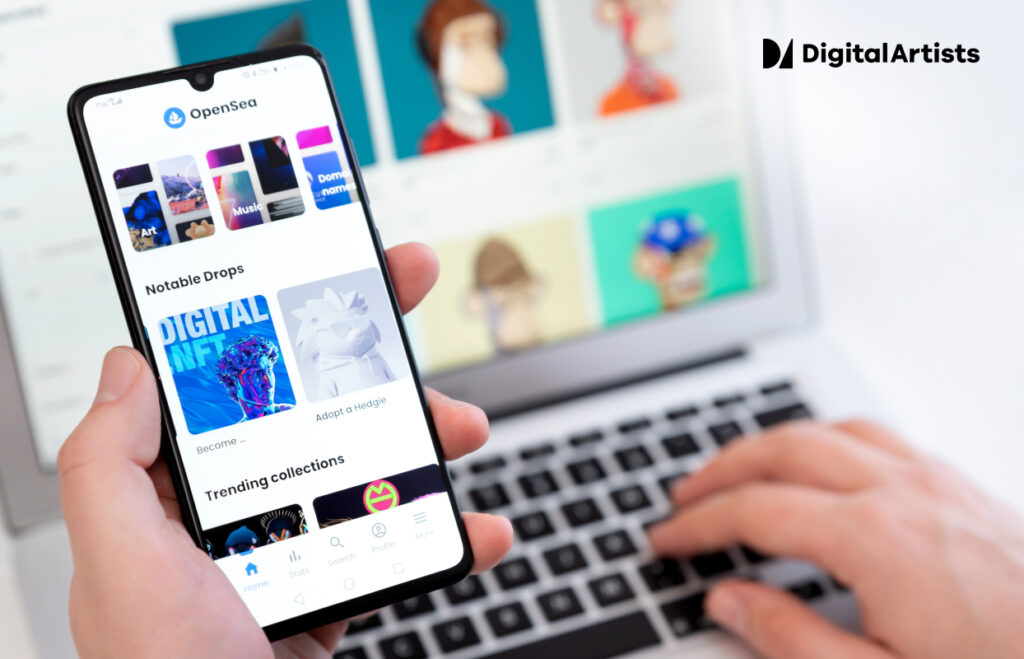
NFT Collectibles: A Deep Dive into the Digital Revolution
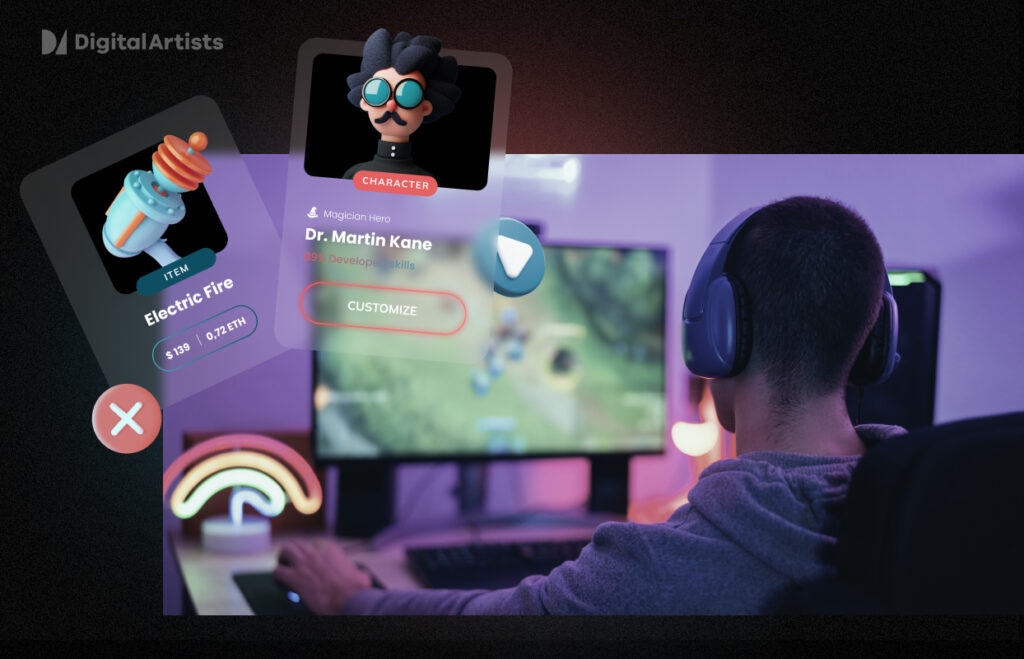
Gaming NFTs: How NFTs Are transforming the gaming industry

Token Gating Guide: How Businesses Can Increase Customer Loyalty Through NFTs
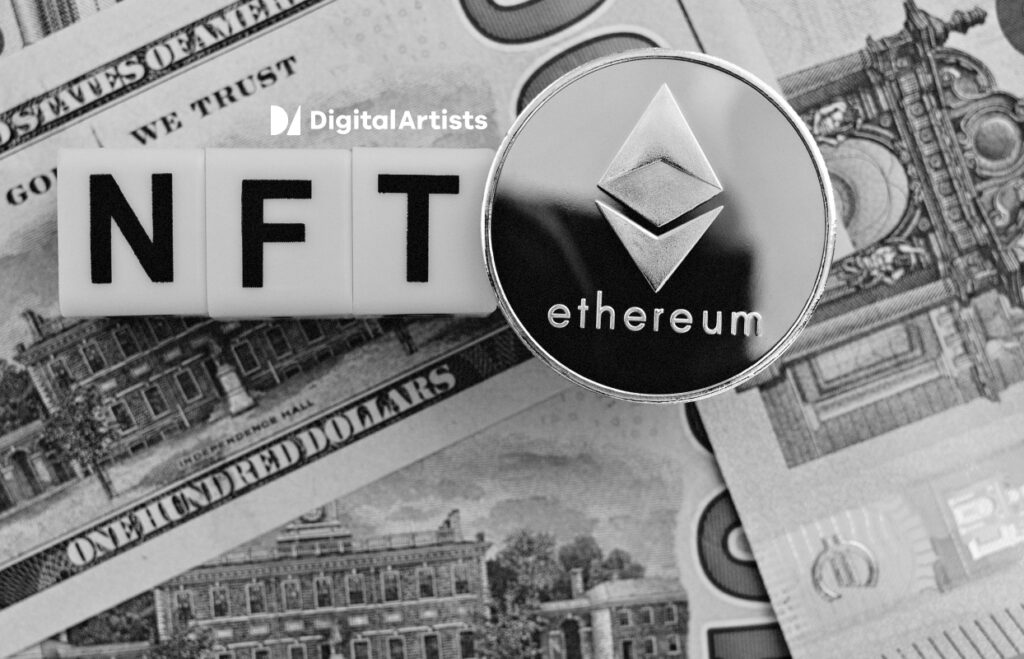
NFT Wallets: Your Storage For Secure NFT Journey
- We are Hiring!
- Privacy Policy
- Cookie Policy (EU)
NFT Marketplace Business Plan
- February 3, 2022 February 3, 2022

According to NonFungible.com , in the first quarter of 2021, the total market capitalization of large NFT projects increased by 2100% (the market grew by 300% last year ). Most NFTs sell out instantly, with the most famous NFTs selling for nearly $70 million. In addition, celebrities are supporting the NFT hype by tokenizing their music, paintings, memes, short videos, logos, computer code, and the like.
At the same time, the main beneficiaries of the NFT market were sites that provide an opportunity for the simplest possible purchase and sale of NFTs. In this article, we will briefly describe what NFTs are and where they can be used, as well as how to develop your own NFT marketplace and how much it costs .
What is NFT?
A non-fungible token, or NFT, is a digital token that acts as an electronic certificate of ownership for physical or virtual assets such as photos, videos, tweets, computer code, etc. Each NFT is a unique, non-fungible, indivisible digital asset. This means that, unlike bitcoin or ether, NFTs are not identical to each other, therefore, they cannot be traded or exchanged on an equivalent basis and they cannot be used as a means of payment for trading transactions.
For example, NFT Cryptopunk 4250 is a certificate of ownership of a unique character that exists digitally and is described as a pixelated image of a punk woman wearing welding goggles with messy hair and purple lipstick. This item is listed for sale on the Larva Labs marketplace for $116,913.

NFT Cryptopunk 4250 for sale at Larva Labs
Another example of an NFT is a picture of a cute girl smiling in front of a burning house, which became the Disaster Girl meme. 21-year-old American Zoe Roth (she is in the photo) sold this meme for 500 thousand dollars .

Disaster girl. Photo: Dave Roth / Know Your Meme
As you can see, NFTs can make crazy money. Some NFTs are, of course, more attractive and therefore people are willing to pay significant amounts for them, while other NFTs are sold for pennies. The principle of value formation in this market is simple: the more famous (more in demand) the lot, the more expensive it is.
Here are some more examples of famous NFT lots:
- Beeple’s digital collage “Every Day: The First 5,000 Days” sold for an impressive $69 million at Christie’s .
- Twitter CEO’s first tweet sold for $2.9 million .
- The animated film Nyan Cat sold for $590,000 .
- A kitten from CryptoKitties was sold for $172,000 .
How does the NFT marketplace work?
Unlike Bitcoin or Ethereum, you cannot directly trade non-fungible tokens on regular cryptocurrency exchanges. To buy and sell NFTs, you need dedicated trading platforms that allow you to issue, hold, and trade non-fungible tokens. Now this market is dominated by large marketplaces OpenSea, Rarible, Superfarm and Mintable.
They generate NFTs using special smart contracts that add a set of unique information (metadata) to each such token and prescribe its main parameters (name, immutability, inseparability, address/number, etc.). After that, non-fungible tokens can be bought and sold on the site at a fixed price or through auctions.

How smart contracts work in NFT marketplaces. A source
From the client side, NFT marketplaces work like regular online stores . The user needs to register on the platform and create a personal digital wallet to store NFTs and cryptocurrencies. The user can then either use the listing to purchase NFTs or create their own token. Launching an NFT is usually simple and similar to creating an eBay listing. You need to specify the name, price, give a description and an image, photo, video, gif, and the like.

Interface of NFT-marketplace OpenSea
Niches and applications of NFTs
Most NFTs are used to commercialize all kinds of digital art, from digital copies of real paintings to memes. For example, on the OpenSea marketplace, you can buy, sell, and transfer images, videos, gifs, and music. This platform runs on Ethereum and issues NFTs using the ERC721 and ERC1155 protocols.
But fine art is not the only area of application for non-fungible tokens. They can also be used to trade collectible cards (NBA Top Shot), game characters (CryptoKitties), real estate (Mintable), virtual worlds (Metaverses), investment offers (Spencer DINVIDDI contract), and any other area where ownership of anything. The main thing is to create a marketplace that will be able to work with the right of ownership you need.
For example, if you want to develop an NFT marketplace for fine art trading, then you essentially need to create a regular online store , the back end of which should be able to issue, store, sell, and change NFTs. It’s relatively simple. If you need an NFT platform for real estate trading, then you will need to create an analogue of Zillow or Trulia. Such sites should be able to work with MLS databases and databases of state registers, determine the user’s location, etc.
And so it is with every area. Here are some more examples:
- Online learning. Such marketplaces should provide a full range of services for learning via the Internet – from selling a training course to tracking the progress of a buyer’s education and communicating with teachers.
- Investment projects. This kind of NFT marketplace should function like a stock market for trading securities. That is, they must provide the possibility of issuing legal securities with the right to property, dividends or a share in profits.
- Safety. Non-fungible tokens can act as access keys to a content, program, database, operating system , or event. In order to sell such NFTs, the marketplace must be as secure and reliable as possible, as well as support popular buyer-side security tools (Touch ID, Face ID, Eye ID, etc.).
- Video games. The sale and purchase of NFTs, which symbolize unique game items or characters, usually takes place either inside the game (for game money) or on external online platforms that guarantee a safe exchange of real money for a game asset (like on Steam). This implies very close integration with the video game.
Main features of the marketplace
The NFT marketplace combines the functions of an online store , an auction, and a blockchain platform for issuing non-fungible tokens. Users should be able to create their own NFT products and sell them. In addition, these marketplaces usually offer some features to attract and retain customers, as well as improve the quality of their service. When developing your own NFT marketplace, it is better to start by implementing the following things.
Showcase. This feature provides the visitors of the trading platform with all the necessary information about the lot: name, price, description, preview, owner, purchase method, rating, etc. Some NFT marketplaces also provide information about the blockchain and protocol of the token so that users can verify the authenticity of purchased NFTs.

Rarible online marketplace showcase
Search system . Make sure your users can easily find the item they are interested in. It would be nice to split all assets into several categories such as art, photography, videos, domains, memes, and music to make it easier for users to navigate the store listing. Filters also make navigation easier, especially if there are a lot of similar items on the platform.
Registration, login . To be able to buy or sell NFTs on the platform, the user must create an account. Typically, the registration process occurs through email, phone number or social media accounts . In addition, the user is also usually prompted to provide their cryptocurrency address. If it is not there, then the possibility of registration is offered using links to cryptocurrency wallets, such as Coinbase Wallet , Metamask, MyEtherWallet.
Create ad . This process should be simple and not take much time. Ideally, it should be the same as on Ebay. To achieve this, you need to think about the optimal user path and implement something like the OpenSea collection manager. It helps to quickly upload a product to the site and specify the properties of the token, such as name, price, description, tags, external link, and so on.

The process of creating a lot on the OpenSea website
Wallet for NFTs . Users need a wallet to send, receive and store non-fungible tokens and cryptocurrencies. The easiest way to do this is to provide integration with popular crypto wallets. The main thing is that such wallets support the NFT protocol you need. Usually these are wallets such as Metamask, MyEtherWallet, Coinbase Wallet and WalletConnect.
Trading History . Usually, an NFT marketplace should have a section where the user can view their trading history. So you can understand how popular the site is, what they sell on it and at what price. For example, on OpenSea, the trading history includes the following data: event, product name, price, buyer, seller, date.

Trading history on the OpenSea website Reviews and ratings . Shows how much the lot or the seller/buyer is liked by the visitors. This information helps users evaluate contractors and specific lots. Typically, the rating is implemented in the form of a numerical rating of the product or likes. Reviews can be implemented both in the form of comments that all registered users can post, and in the form of reviews that counterparties leave to each other after the transaction is completed.
Notifications . You can implement a push notification system to inform users about new bids in a selected category or from a selected seller, a status change on a featured item, a new message, a sale of your own lot, or an update to the NFT trading platform.
Support . An important element of any trading platform. With the help of the support service, users will look for answers to their questions, solve problems and conflicts. You can implement a support service as a call center, email support, a separate information portal, or using a help bot.
Non-Fungible Token Standards
In order to run a blockchain-based NFT, certain token standards must be used, which guarantee that the asset will act in a certain way and demonstrate how to interact with the basic functions of the asset. Currently, the most popular standards for running NFTs are:
- ERC721. Used to uniquely identify something or someone based on Ether. It supports smart contracts and offers a permitted way to transfer assets using the transferFrom method.
- ERC1155. According to the standard, identifiers represent not just one unique asset, but a class of assets. Compared to the ERC721 standard, it is much more efficient. So, if you are a video game developer and want to sell 100 sets of armor, then in the case of ERC721 you will need to register 100 smart contacts, and in the case of ERC1155 only one and register its number.
- B.E.P. At the end of the year, the largest cryptocurrency exchange Binance launched a new BSC blockchain with support for smart contracts and compatibility with the Ethereum virtual machine (EVM). And it has analogues of ERC721 and ERC1155 for NFT – BEP-721 and BEP-1155, respectively.
Stages of developing your NFT marketplace
The trading platform for buying and selling NFTs is a complex piece of software that is best left to a development company with relevant experience. Since 2015, we have been helping businesses and individuals implement projects in the field of fintech and blockchain — from wallets to cryptocurrency exchanges. At the same time, our company can help you both create a marketplace from scratch and clone an existing platform.
Step 1: open a project
The first step in creating an NFT marketplace is for you and the development team to review the details of your project in order to assess the technical feasibility of the project and its viability. Here you must answer the questions:
- What niche will you work in?
- How exactly will you sell NFTs?
- Who is your main target audience?
- What token protocol will you be using?
- What technology stack will you use?
- What monetization model will you use?
- What will make your project stand out from the competition?
- What features do you intend to implement?
- Other questions…
The answers to these questions will guide you through the entire development process and help you develop the specifications for building your NFT marketplace. If you find it difficult to answer questions, do not worry, the development team will help with this: they can describe your ideas in text and visual diagrams, prepare technical documentation so that you can start designing.
Once the initial concept and specifications are in place, the development team can create a development plan to provide a rough timeline and budget for the project. Then you can start designing.
Step 2: design and development
When all the technical requirements and the development plan are agreed, the development team can get to work. First, you, the business analyst and/or designers design the user interface of the marketplace (wireframe, mockups and prototypes) describing the user flows and functions of the marketplace. An efficient trading platform architecture is also being created.
UX / UI design . Navigation and the appearance of the user interface are very important when developing an NFT marketplace, since they determine the first impression, usability and user experience in general. So make sure that your site design appeals to your audience and is simple enough for anyone with even the slightest familiarity with Amazon and Ebay to understand.

An example of a possible interface design for an NFT marketplace. A source
Back-end and smart contracts . At this level, the work of the entire internal (server) part of your trading platform is carried out. When developing it, in addition to the usual business logic and marketplace functionality, you must implement work with the blockchain, smart contracts, wallets and provide an auction mechanism (most NFTs are sold using it). Here is an example of a technology stack for the backend of an NFT marketplace:
- Blockchain: Ethereum, Binance Smart Chain.
- Token standard: ERC721, ERC1155, BEP-721, BEP-1155.
- Smart contracts: Ethereum Virtual Machine, BSC Virtual Machine.
- Frameworks: Spring, Symfony, Flask.
- Programming languages: Java, PHP, Python.
- SQL databases: MySQL, PostgreSQL, MariaDB, MS SQL, Oracle.
- NoSQL databases: MongoDB, Cassandra, DynamoDB.
- Search engines: Apache Solr, Elasticsearch.
- DevOps: GitLab CI, TeamCity, GoCD Jenkins, WS CodeBuild, Terraform.
- Caching: Redis, Memcached.
front-end . This is the entire external part of the trading platform, which is responsible for the interaction with the end user. The main goal of front-end development is to provide ease of management, as well as reliability and performance. Here is an example of a technology stack for an NFT marketplace front-end:
- Web languages: Angular.JS, React.JS, Backbone and Ember.
- Mobile languages: Java, Kotlin for Android and Swift for iOS.
- Architecture: MVVM for Android and MVC, MVP, MVVM and VIPER for iOS.
- IDE: Android Studio and Xcode for iOS.
- SDK: Android SDK and iOS SDK.
Step 3: testing the created product
At this stage, several cycles of code testing are performed to ensure that the platform works correctly. The QA team runs several checks to make sure that your project code does not contain critical errors and bugs. In addition, the content, usability, security, reliability and performance are checked for all possible scenarios for using the platform.
Step 4: Deploy and Support
When the platform is tested, it’s time to deploy your NFT marketplace on the server (cloud). Please note that this is not the last step, as you will also need to organize the support service. In addition, it is also necessary to plan the further development of the platform in order to follow the market trends and user expectations.
Leave a Reply Cancel reply
Your email address will not be published. Required fields are marked *

How to Make a Business Model for NFT (Non-Fungible Tokens)?

Business Model for NFT, the world, nowadays, is crazy about the business model. And it is clear that NFTs are big business, really big. However, there are skeptics who think that the NFT bubble may soon burst. Real estate companies, luxury fashion labels, sports leagues, and ……. are selling NFTs. Sotheby’s, Christie’s, and Phillip; even these legacy Jewelry and art auction houses have entered into the business. This is, therefore, a trend worth exploring. Mark Cuban, a billionaire, is enthusiastic about NFTs. It can provide important new revenue streams for creators and small businesses, according to him. He advises to jump into the business. And what is the best time for it?
Table of Contents
Now! It’s time to act on to start with the right business model for NFT.

NFT Business Model: How to Make Money?

It’s time to understand the business and how to earn money using NFTs. We know that purpose of any business is to earn money. A business model helps in creating, developing, and maintaining a business. Hence, we are starting a discussion on the ways of revenue generation in the business model for NFT.
Selling NFTs is the most common means for businesses to make money in the ecosystem. NFT business model is an indisputable and undeniable choice as there is ample demand for virtual goods. It also works very well.
Selling NFT
As mentioned earlier, selling NFTs directly to users is the most popular method for companies in the NFT ecosystem to generate revenue. Likes of video game publishers and game developers have already entered into the NFT business. Revenue earned from the NFT business has a lion’s share in the total income. Experts opine that selling NFTs directly to users will create money for the foreseeable future.
NFT Marketplace
A new way of monetizing the internet with digital collectibles
You need an NFT marketplace to start your business . An NFT marketplace is very similar to eMarketplaces likes Amazon, eBay, and Itsy. Sellers sell their goohttps://www.vardhamaninfotech.com/nft-marketplace-development-company/ds in these marketplaces. Similarly, NFT owners sell their NFTs in these NFT marketplaces.
NFTs are Etherium (Cryptocurrency) based smart contracts for a digital asset. These are unique, verifiable, indivisible, and immutable tokens created using blockchain technology. These NFTs represent ownership rights of a digital asset, artworks, etc. An NFT seller sells his or her NFTs in exchange for a cryptocurrency in the NFT marketplace. The marketplace owner charges a commission, usually 2.5 to 5 percent, from the NFT seller. There are plenty of sellers and buyers of NFTs. Hence, the NFT marketplace owner earns a handsome revenue as commission.
Schedule NFT Marketplace Demo

Business Model for NFT: An Overview
According to the English dictionary, Fungibility is the ability of a good or asset to be interchanged with other individual goods or assets of the same type. Fungible assets simplify the exchange and trade processes, as fungibility implies equal value between the assets. And, as per the Cambridge dictionary, non-fungible means not easy to exchange or mix with other similar goods or assets.
Non-fungible or non-fungibility are not new concepts for the business world. However, non-fungible token (NFT) is a rather new business idea. Blockchain technology has converted the idea into big businesses. Hence, there is a need to know about the NFT business model.
What Do You Need to Know About NFTs?
Understanding non-fungible tokens.
Fungibility is a rather simple concept relating to the things people own and use in daily life. Dollars or rupees are simple examples of fungible assets because one can easily replace them with something identical. To clarify, you can replace a 100 rupees note with one serial number with another 100 rupees note of a different serial number. Both notes hold equal value. This fungibility of fiat currencies lays the foundation stone to exchange. And this exchange system is the basis of any business. Hence, all classic business models are based on the fungibility of fiat currencies.
Inversely, non-fungible assets are unique in nature. These are not mutually interchangeable. An art piece of a famous artist is not interchangeable with another art piece of a different artist. This very nature of non-fungible assets leads to the blockchain-based new business model of NFTs.
Non-Fungible tokens contain identifying information about these unique assets. Also, there was a problem of a lack of unity in traditional digital assets. Non-Fungible tokens solve this problem too, Blockchain technology helps in creating a unique and immutable identifying system of these unique non-fungible assets. Thus providing a simple way to transfer ownership and manage access to these NFTs.
Non-fungible digital assets have been existing since the digital era started. However, the tokenization of these unique assets has the potential to pave a way for new business model for NFT. It is essential to know about the characteristics and unique abilities of NFTs that differentiate them from traditional cryptocurrencies before we understand the NFT business model.
Characteristics of Non-Fungible Tokens
<h3 UniquenessMetadata describing the uniqueness of a digital asset differentiating it from all other assets are the basis of NFTs. The owners can describe large numbers of attributes in rich metadata that make the NFT special and identifiable. In the blockchain, this record is permanent and unalterable. As an outcome, one can validate the authenticity of the asset using this feature.
Validating authenticity is a challenge for high-value non-fungible assets in art, gaming, collectibles, and other virtual or real-world assets. There are, always, fakes. The original function of NFTs was to verify digital art because they can function as certificates of authenticity. NFTs, help to protect these fraudulent activities. The very characteristic of blockchain helps negate counterfeiting and deceptive behavior. This reassures purchasers that their acquisition is authentic and original.
Validating the authenticity and Uniqueness characteristics of NFTs leads them to create a successful NFT business model.
Indivisible
We know that 35 percent of the famous Monalisa painting is meaningless. So, you cannot split the NFTs into smaller denominations. One can only hold, buy, and sell these as whole entities. However, there is a possibility that an expensive NFT can be bought in partnership and one can get a share of the same.
Though, technically one can create unlimited numbers of NFT, it is its scarcity that makes it attractive. That is what makes non-fungible tokens interesting for business. Increasing rareness enhances desirability and that is suitable for any NFT business model.
Moreover, NFTs solidify ownership rights. A non-fungible token paired with Blockchain technology helps to provide ownership rights to a digital asset. An NFT is also transferable. One can easily trade NFT ownership rights on a specialist market.
Now, we have some understanding of fungibility, non-fungibility, and non-fungible tokens (NFTs) along with the business model.
Besides this, there are many other ways to create revenue. Blockchain technology has opened up doors for more business opportunities. We will discuss these innovative ways to earn money using the business model for NFT in the coming blog post.
Written by Jyoti Kothari
Technology | business | nft, 0 comments(s), april 18, 2021, recent posts.
- Is The Metaverse The Future Of Social Media?
- The Future of Metaverse Tourism
Role Of AR and VR In The Metaverse
- Metaverse Cryptocurrency (ETP)- A Complete Review
Why Should You Build Metaverse Project?
Blockchain technology Mobile App Development Mobile Application Development NFT NFT Marketplace
Very nice blog, you have done here. So keep it up and help the visitors.
Thanks for sharing the informational blog post.
Hello! This is a great article! Really informative to know more about Hybrid Apps.
Great article cleared allot of my doubts great job
Your Title Goes Here
Your content goes here. Edit or remove this text inline or in the module Content settings.
You May Also Like…

Jan 2, 2023
The metaverse generally allows users to engage in a more interesting experience with the real world, but augmented...

You've probably encountered the word "metaverse" multiple times on a website, social platform, or newspaper. Ever...

Difference Between Metaverse And Virtual Reality
The financial, technological, and physical worlds nowadays integrate, which crystallized the growth of technology. We...
Get a Quote
Fill up the form and our Team will get back to you within 24 hours
+91-8955953845
[email protected], https://t.me/etherify, /vardhamaninfotech1.
Email Address
NFT LTD. ANNOUNCES 1 FOR 50 REVERSE SHARE SPLIT
Hong Kong, April 11, 2024 (GLOBE NEWSWIRE) -- NFT Ltd. (NYSE American: MI) ("Company" or "NFT", formerly known as Takung Art Co., Ltd.), as an emerging online trading platform operator of international art and collectibles today announced that a 1 for 50 reverse split of its Class A ordinary shares and Class B ordinary shares was approved by the Company's shareholders on March 18, 2024 and is expected to become effective on or around April 12, 2024 (the “Reverse Split”).
Upon the effectiveness of the Reverse Split, NFT shareholders will receive one new ordinary share of NFT for every fifty shares they hold. NFT’s Class A ordinary shares are expected to begin trading on a split-adjusted basis when the market opens on April 12, 2024.
The Reverse Split is expected to lead NFT’s Class A ordinary shares to trade at approximately fifty times the price per share at which it trades prior to the effectiveness of the Reverse Split. NFT, however, cannot assure that the price of its Class A ordinary shares after the Reverse Split will reflect the 1 for 50 Reverse Split ratio, that the price per share following the effective time of the Reverse Split will be maintained for any period of time, or that the price will remain above the pre-split trading price.
NFT's Articles and Memorandum of Association was amended and restated in connection with the Reverse Split. As of April 11, 2024, there were approximately 154.5 million of NFT's Class A ordinary shares outstanding. Effecting the Reverse Split will reduce that amount to approximately 3.09 million Class A ordinary shares outstanding.
Treatment of Stock Options and Restricted Shares
The number of ordinary shares into which NFT's outstanding stock options and restricted shares as well as the options' relevant exercise price per share will be proportionally adjusted to reflect the Reverse Split. The number of shares authorized for issuance under NFT's equity incentive plans will also be proportionally reduced to reflect the Reverse Split.
Fractional Shares
Any fractional shares that would have resulted because of the Reverse Split will be rounded up to the nearest whole share.
New Ordinary Share Certificates
NFT will adopt a new share certificate in connection with the implementation of the reverse share split. NFT's transfer agent, VStock Transfer LLC, will manage the exchange of share certificates. Shareholders of record will receive a letter of transmittal providing instructions for the exchange of their old certificates as soon as practicable following the effectiveness of the Reverse Split. Shareholders should not send in their old stock certificates until they receive a letter of transmittal from VStock Transfer LLC. Shareholders who hold their shares through a securities broker or nominee (i.e., in "street name") will be contacted by their brokers or nominees with any instructions.
For more information, shareholders and securities brokers should contact VStock Transfer LLC at 212-828-8436.
About NFT Limited
NFT Limited (formerly known as Takung Art Co Ltd.) operates an online electronic platform (www.nftoeo.com) for offering and trading of digital artwork. Through its platform, the Company allows artists/art dealers/owners to access a much bigger art trading market where they can engage with a wide range of investors. It generates revenue in the form of services in connection with the offering and trading of artwork on its platform, primarily consisting of listing fees, trading commissions, and management fees. Please visit : www.nftoeo.com .
Forward-Looking Statements
Certain statements in this press release may constitute "forward-looking statements" within the meaning of the Federal Securities Act, including but not limited to our expectations of future financial performance, business strategy or business. These statements constitute forecasts, prospects and forward-looking statements and are not performance guarantees. NFT warns that forward-looking statements are subject to many assumptions, risks and uncertainties that will change over time. Forward looking statements may be identified by words such as "may", "can", "should", "will", "estimate", "plan", "project", "forecast", "intend", "expect", "predict", "believe", "seek", "target", "Outlook" or similar words.
These forward-looking statements are based on information available as of the date of this press release and our management's current expectations, forecasts and assumptions, and involve a number of judgments, risks and uncertainties that may cause actual results or performance to be materially different from those expressed or implied by these forward-looking statements. These risks and uncertainties include, but not are limited to, the risk factors described by NFT in its filings with the Securities and Exchange Commission ("SEC").
Contact: Jimmy Wang [email protected] +8618021079975

IMAGES
VIDEO
COMMENTS
2. Write An NFT-Themed Blog. The web is desperate for well-written and informative NFT-related content. There's a huge potential readership for any blog that covers NFTs and the news surrounding ...
But while NFTs may be fetching eye-popping, eyebrow-raising valuations, there is a logic to how — and when — they create value. By creating a system of verifiable digital ownership NFTs ...
Upload a digital item and proceed to create an NFT. Create content and adjust the settings for your own NFT. Create a collection (this step is optional and can be skipped). List the item on the selected NFT marketplace by paying the fees involved. After that, the creator can sell their own NFT.
The NFT Business Plan. Whenever I get a client request whether they want an NFT Business plan or a white paper, I always explain that at 99% of the cases, they're the same thing. In the crypto world, the word whitepaper is just more common than the word business plan. The contents are almost exactly the same.
1. Turning digital artworks into NFTs. Generating NFT artwork and launching NFT collections is a well-known NFT business model that has contributed to the popularity and mainstream adoption of NFTs. Launching NFT projects involves creating one-of-a-kind digital artworks that are verified on the blockchain network.
NFT Marketplace business model: 9 Standard. The business model of the NFT marketplace is made up of 9 building blocks that explore the logic of how a company plans to provide money and make money. The 9 blocks cover the 4 main areas of a business they are. Offerings. Customers.
8. Strategic Marketing and Advertising: Develop a strategic marketing plan to promote your NFT business effectively. Utilize paid advertising, influencer partnerships, content marketing, and social media campaigns to reach your target audience. Continuously analyze and refine your marketing strategies based on data and feedback. 9.
Driven in part by a FOMO reminiscent of the 1990s dotcom anxiety of bricks-and-mortar companies, mass-market players and luxury brands alike are launching NFT collections at a dizzying pace.
In conclusion, writing a business plan for an NFT art marketplace requires careful consideration of market dynamics, target audience, competition, and financial projections. By following these 9 steps, you can create a solid plan that sets your platform up for success in this exciting and rapidly expanding industry. Conduct Market Research
Linking NFTs to online events such as competitions and auctions can draw a lot of attention to a brand and has worked well for several businesses. For example, McDonald's offered NFT prizes for retweets, resulting in a huge amount of exposure and engagement on Twitter, and many companies have run online NFT auctions. 4.
The music market is flooded with newcomers, therefore building an NFT business model is a great method to make money. 3. NFT in Gaming platform. The gaming industry is quickly capitalizing on the efficacy of NFT principles and launching a slew of new initiatives.
4. Launch, run & coordination. Beyond the big plans and fancy marketing announcements, real work is needed for any project, whether on the blockchain or not. Below is a list of things to work on to ensure a sound NFT strategy and vision, as well as a successful implementation and roll-out.
This past year also saw some NFT providers create business models that could raise securities law concerns. For example, some projects attached separate coin offerings to their NFT project that closely mirrored the types of "initial coin offerings" (ICOs) that the U.S. Securities and Exchange Commission found violated securities laws in ...
As a business, you can earn revenue, in perpetuity via a royalty, through a smart contract. Consumers can even " rent " your NFT to use in games and other activities. If they win and earn money, you split the earnings. The revenue streams at this point are plentiful and will continue to grow.
In the rapidly evolving world of non-fungible tokens, having a solid NFT business plan template is vital for success. An essential aspect of any effective marketing strategy is monitoring analytics and performance tracking to continually refine your plan and achieve better results. By incorporating data-driven insights into your NFT business ...
So, when considering the NFT business plan, it should be understood that this technology's commercial viability is still under the development phase. Basically, this is the time for the exponential curve and is arguably the perfect time to create the NFT pitch deck.
You can search other NFT collections to get some more ideas about how NFT collections should look. Step 4: Choosing an Art Style After deciding on your concept and exploring different NFT ...
An NFT roadmap is a plan that outlines the steps a creator, or team will take to launch and grow their own NFT project. It serves as a guide for the development and implementation of a new NFT ecosystem, from concept to launch, and lays out what the community can expect from the project post-mint. An NFT roadmap typically includes a clear ...
NFT sales topped $2.5 billion during the first half of 2021, demonstrating the potential of a seemingly new business model for digital creators. Yet as 2021 continues, some in the industry believe ...
Rather, we choose to work closely with the brand and together with our extensive knowledge in the NFT industry, build a strategy with a ready-to-use action plan. Build NFT Communities NFTs offer businesses a powerful tool for building strong and engaged communities around their brand or products.
NFT Marketplace Business Plan. February 3, 2022 February 3, 2022; According to NonFungible.com , in the first quarter of 2021, the total market capitalization of large NFT projects increased by 2100% (the market grew by 300% last year ). Most NFTs sell out instantly, with the most famous NFTs selling for nearly $70 million.
A business model helps in creating, developing, and maintaining a business. Hence, we are starting a discussion on the ways of revenue generation in the business model for NFT. Selling NFTs is the most common means for businesses to make money in the ecosystem. NFT business model is an indisputable and undeniable choice as there is ample demand ...
Coachella attendees who complete quests at the event and on the Coachella Discord server will earn "stamps" and points that can be traded for exclusive festival benefits and experiences, including access to the Oasis VIP lounge, unreleased music, and more—including a rare NFT that comes with two 2025 festival guest passes.. In exchange, Coachella organizers will gain insights into what ...
Hong Kong, April 11, 2024 (GLOBE NEWSWIRE) -- NFT Ltd. (NYSE American: MI) ("Company" or "NFT", formerly known as Takung Art Co., Ltd.), as an emerging online trading platform operator of international art and collectibles today announced that a 1 for 50 reverse split of its Class A ordinary shares and Class B ordinary shares was approved by the Company's shareholders on March 18, 2024 and is ...